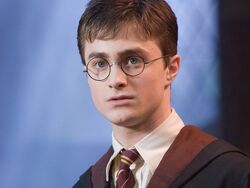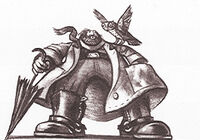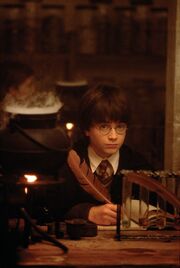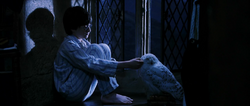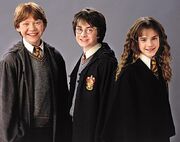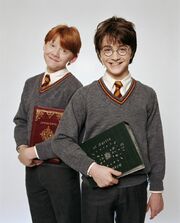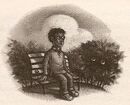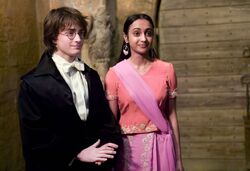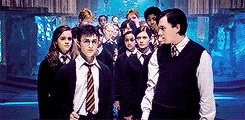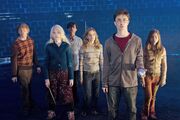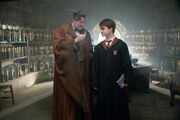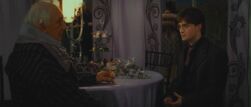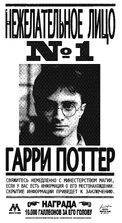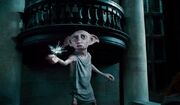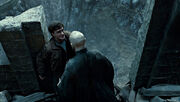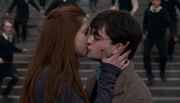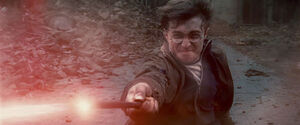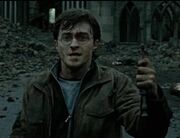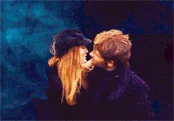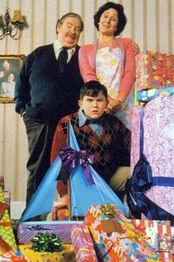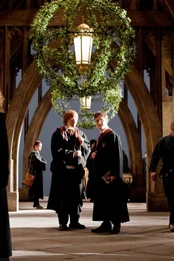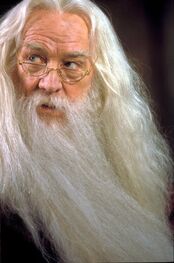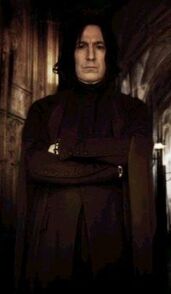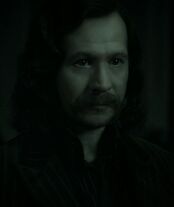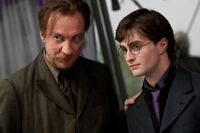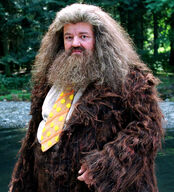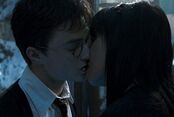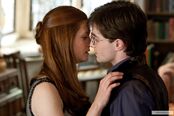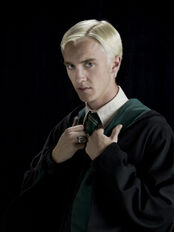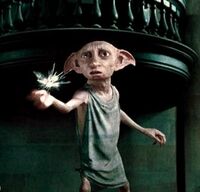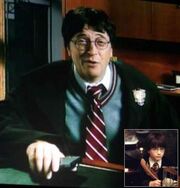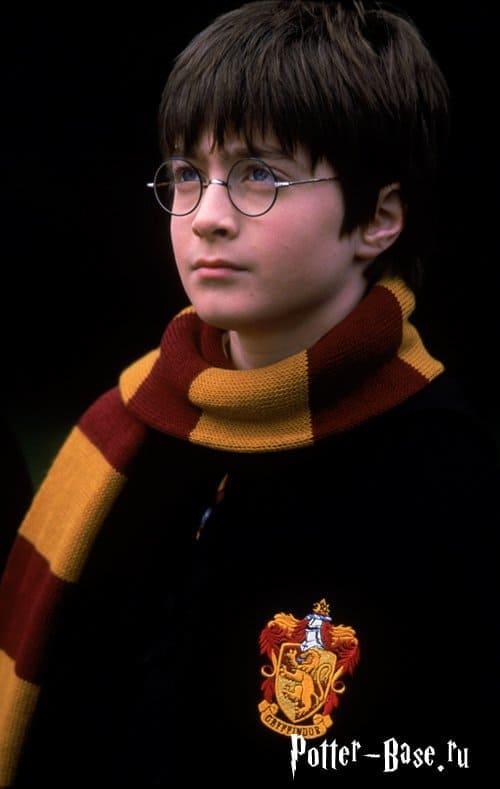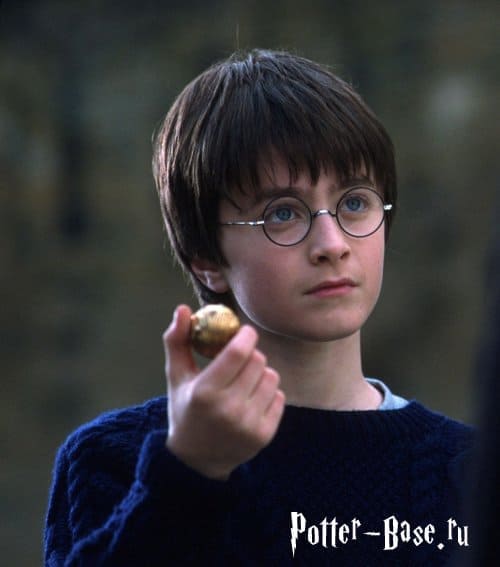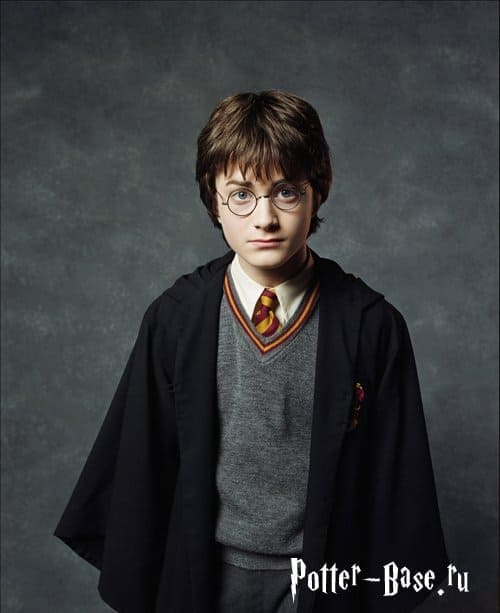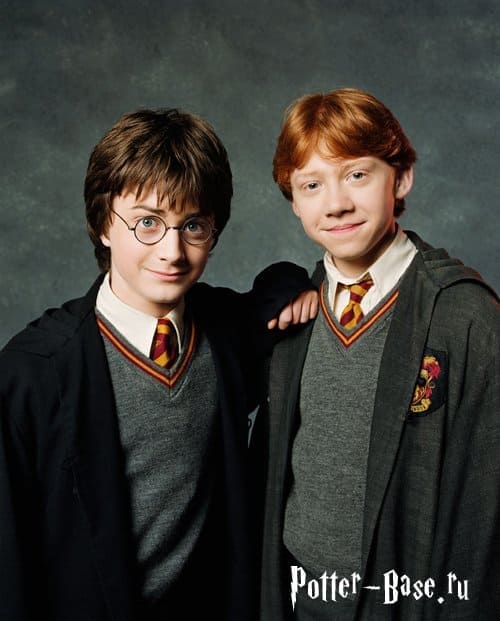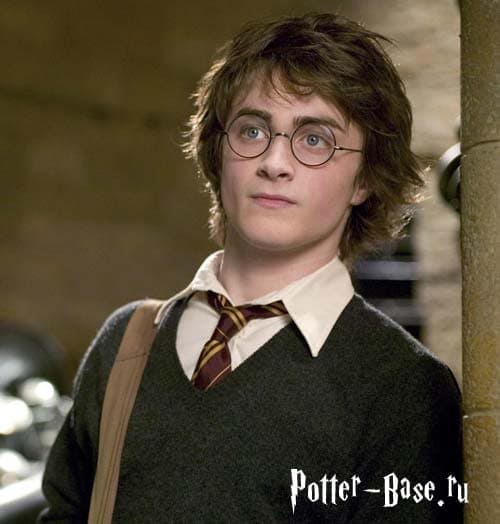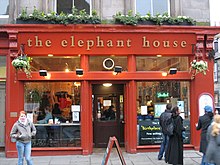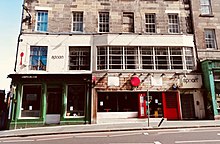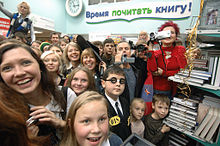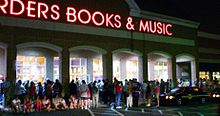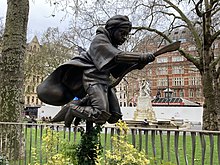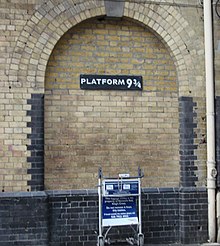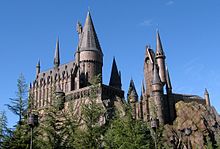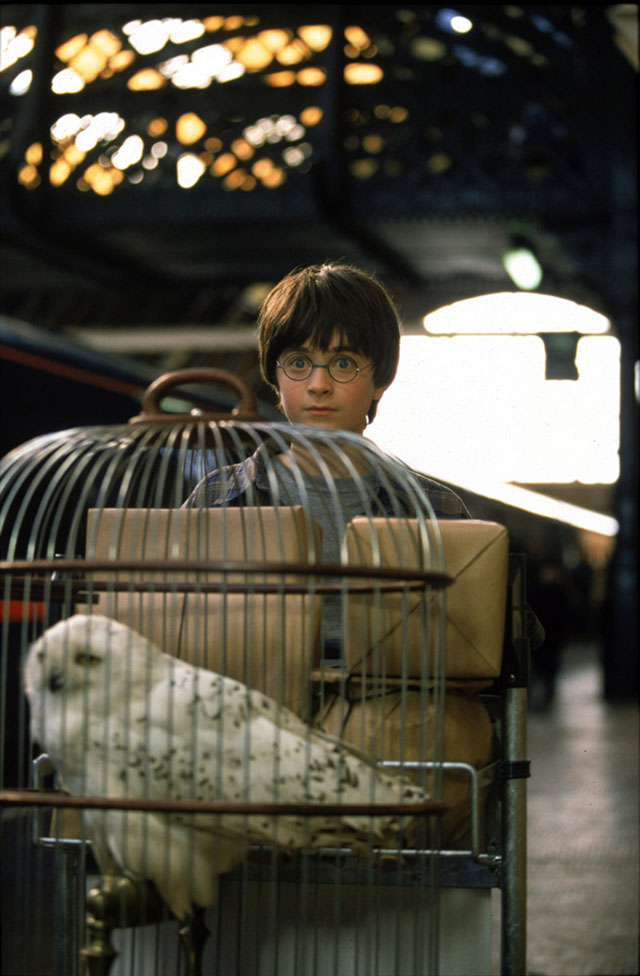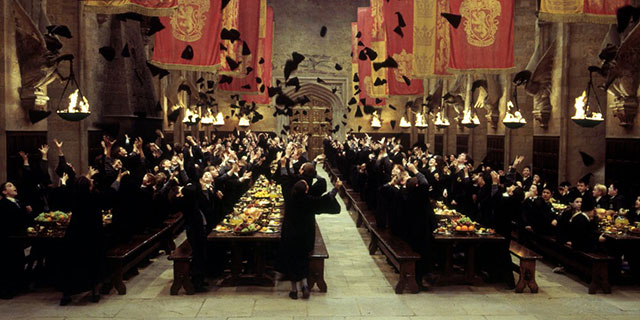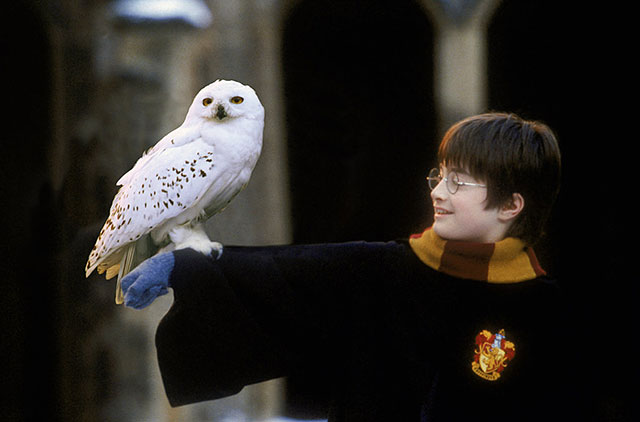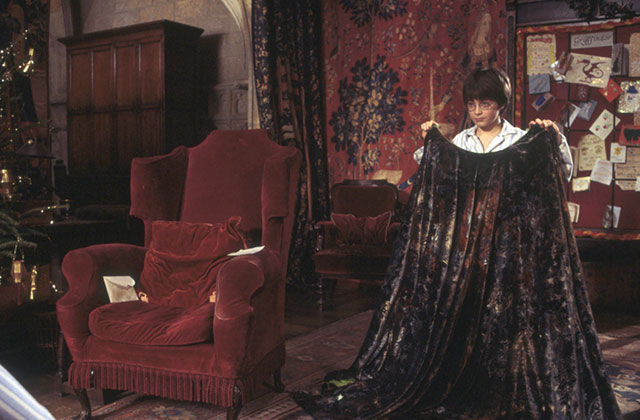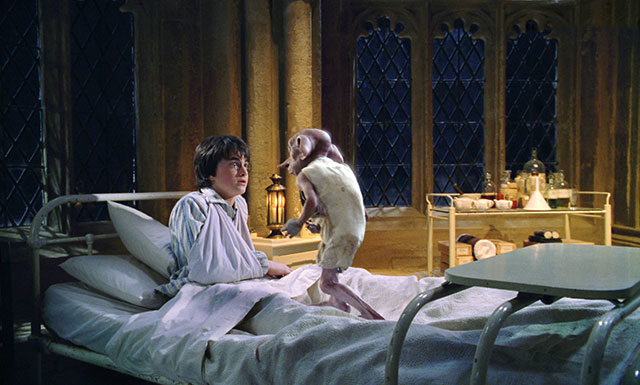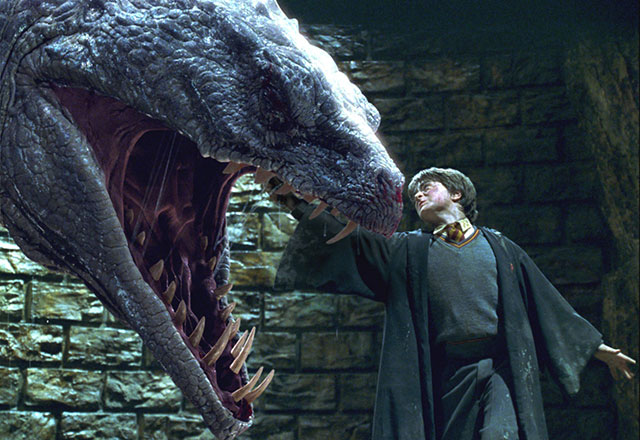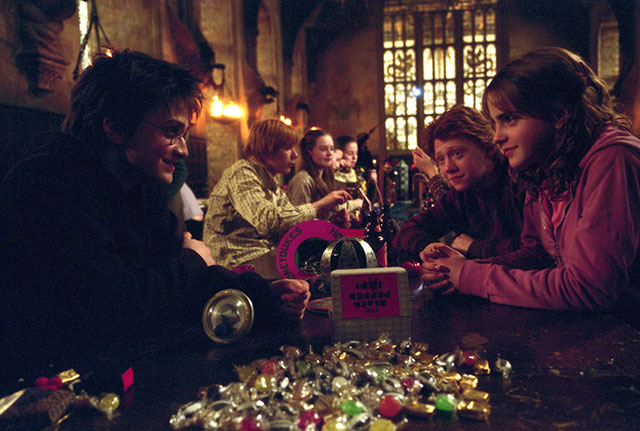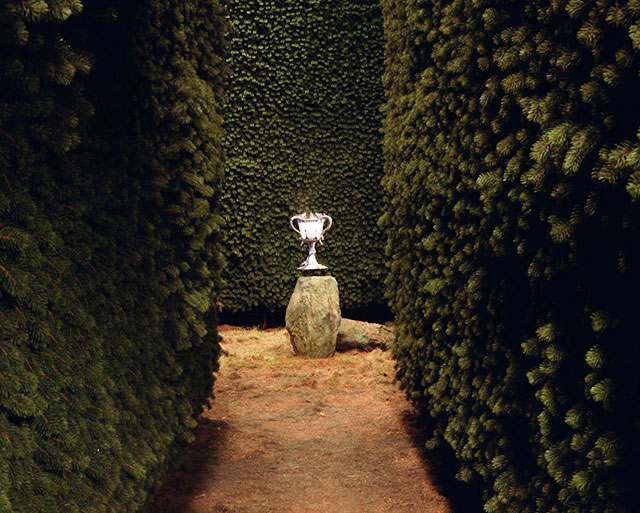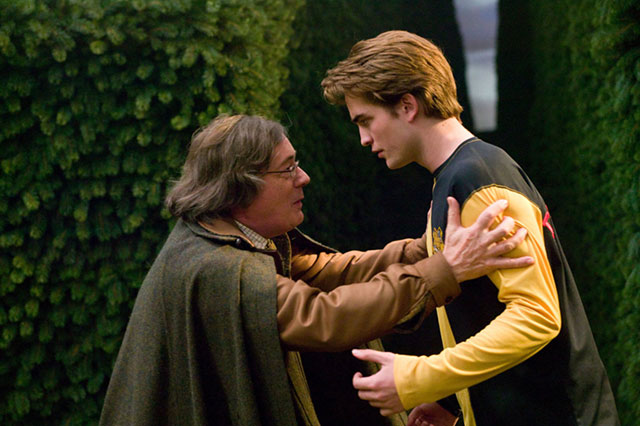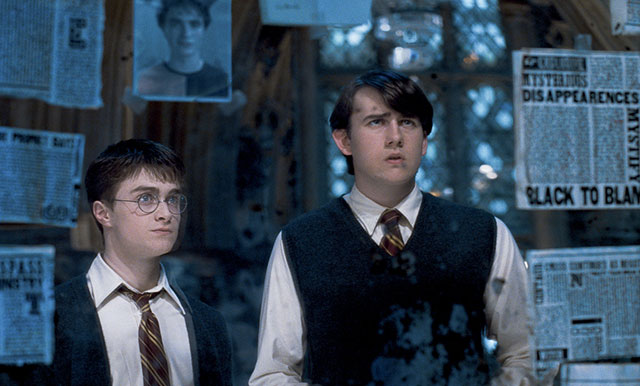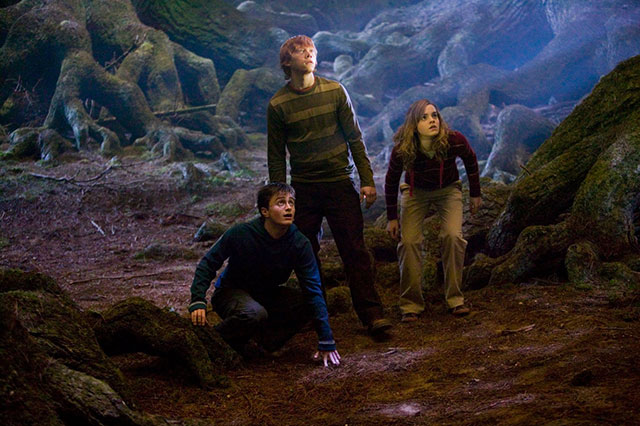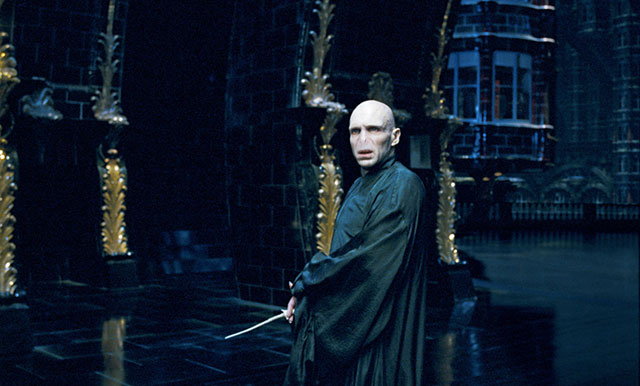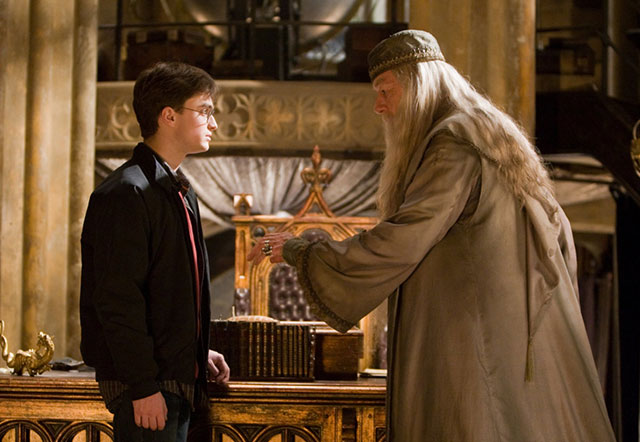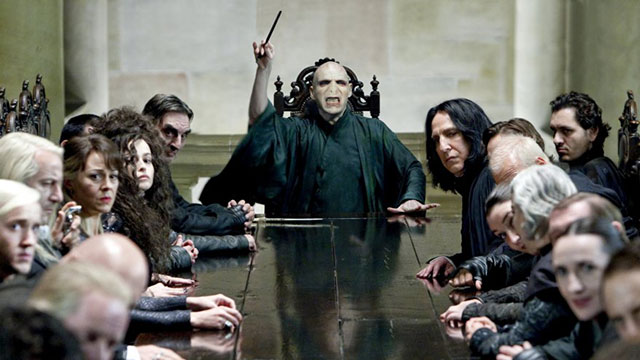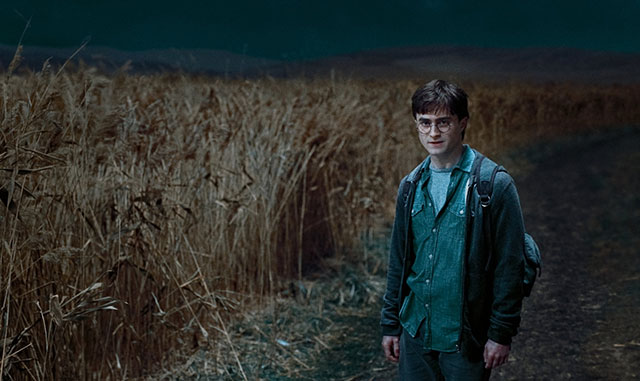
|
Внимание!
Информация в этой статье (или разделе) содержит спойлеры из пьесы «Гарри Поттер и Проклятое дитя»! |
[Просмотр]
Волан-де-Морт и Гарри Поттер[3]
Гарри Джеймс Поттер (англ. Harry James Potter) — главный герой Поттерианы, одноклассник и лучший друг Рона Уизли и Гермионы Грейнджер, член Золотого Трио. Самый знаменитый студент Хогвартса за последние сто лет. Первый волшебник, которому удалось противостоять смертельному проклятью «Авада Кедавра», благодаря чему он стал знаменитым и получил прозвище «Мальчик, Который Выжил». Героически сражался с лордом Волан-де-Мортом и его последователями Пожирателями смерти. Единственный, кому удалось дважды остаться живым после шести поединков с Тёмным Лордом и кто, в конце концов, победил его. Обладатель специальной награды Хогвартса «За заслуги перед школой», полученной в 1993 году за спасение школы от чудовища Тайной комнаты — василиска.
Внешний вид
Гарри Поттер внешне — вылитый отец (для Сириуса словно воскресший друг), лишь его зелёные глаза похожи на глаза матери (в фильме у исполнителя роли Гарри Поттера Дэниела Рэдклиффа глаза голубые). Гарри маленький и худой, он выглядит чуть младше своего возраста, с чёрными, вечно взъерошенными волосами, худощавым лицом и торчащими коленками. Он носит очки с круглой оправой. На лбу Гарри находится знаменитый шрам в виде молнии[4], который у него остался от проклятия «Авада Кедавра».
Характер
Гарри Поттер
В начале повествования Гарри — одинокий, замкнутый ребёнок, который постоянно подвергается унижениям в семье и в школе. Сложная жизнь у Дурслей формирует у него такую черту, как недоверчивость. Когда в его жизни появляется Хагрид, мальчик до последнего сомневается в происходящем.
В первый год обучения в Хогвартсе, где Гарри наконец-таки ощущает себя полноценным человеком, определяются основные черты его характера, как положительные, так и отрицательные.
Гарри добр, серьёзно относится к любым человеческим отношениям, никогда не предаст близкого человека, с уважением относится ко взрослым, которые, конечно, это уважение заслужили. Он никогда не нападает первым, напротив, ему самому часто приходится отбиваться от нападок. Гарри по своей натуре лидер, и если ему приходится чем-либо руководить (быть капитаном квиддичной команды или руководителем Отряда Дамблдора), у него это вполне прилично получается. Гарри никогда не кичится своей известностью, наоборот, собственная слава его раздражает. Он малообщителен, и несмотря на то, что ему поневоле приходится контактировать с большим количеством людей, близкие отношения его связывают лишь с несколькими. Гарри достаточно скрытен, он никогда не делится со своими чувствами и переживаниями даже с близкими друзьями.
Гарри Поттер — «человек первого впечатления». Если кто-либо не понравился (или наоборот, понравился) ему с первого взгляда, он очень неохотно пересматривает своё к нему отношение. Правда, он всегда легко и даже с радостью прощает обидчика, если только он скажет: «Извини, Гарри, я был глубоко не прав». Так произошло с Роном[5], так случилось год спустя с Симусом, это повторилось с Дадли[6]… Гарри не может абстрагироваться от собственных эмоций и опираться только на факты как Римус Люпин, он не умеет цепко замечать детали как Гермиона Грейнджер, он не умеет относиться ко всему с юмором как близнецы Уизли. Но зато он способен глубоко и сильно любить людей и предчувствовать то, что невозможно объяснить словами. «Следуй всегда своей интуиции, — говорит ему однажды Люпин[6], — она тебя почти никогда не обманывает».
Биография
Происхождение
Гарри Поттер — потомок Певереллов, старинной магической семьи, к которой имеет отношение и Том Реддл. Впрочем, кровь братьев Певереллов, по словам самой Джоан Роулинг, течёт в каждом, кто обладает магическими способностями. Сам Гарри узнал о том, что он потомок Игнотуса Певерелла, когда понял, что Мантия-невидимка, доставшаяся ему от отца, на самом деле насчитывает несколько веков истории и является одним из Даров Смерти. Также известно, что Том Реддл — потомок Кадма Певерелла по линии Мраксов, владевших другой реликвией — Воскрешающим камнем. Таким образом, сам Гарри и Волан-де-Морт имеют общие древние корни.
Гарри Поттер с отцовской стороны состоит в родстве с семейством Блэков, а через них — с половиной магических семейств Англии. С материнской стороны состоит в родстве с магловским семейством Дурслей.
Начало жизни
Мальчик, который выжил
Гарри Джеймс Поттер родился 31 июля 1980 года у волшебников Джеймса и Лили Поттеров. После рождения сына семья жила в укрытии, поскольку стало известно, что лорд Волан-де-Морт охотится за Гарри (см. «Пророчество»). Они жили в Годриковой впадине под защитой заклинания Фиделиус. Лучший друг Джеймса Поттера Сириус Блэк являлся крёстным отцом Гарри, и вначале планировали сделать хранителем его, но, по совету самого Сириуса, в последний момент и тайком ото всех сделали им Питера Петтигрю, который, как они считали, мог вызвать меньше подозрений. В этом была их фатальная ошибка, так как Петтигрю к этому моменту переметнулся к Волан-де-Морту. Он выдал место, где прятались Джеймс и Лили, Тёмному Лорду и тем обрёк их на смерть, а заодно и подставил Сириуса Блэка, который стал в глазах всех предателем.
Вечером 31 октября 1981 года Тёмный Лорд появился в Годриковой впадине, чтобы убить Гарри. Джеймс пытался защитить семью, но погиб. Когда Волан-де-Морт уже собрался убить ребёнка, Лили встала на его пути, закрывая своим телом кроватку малыша. Безоружная, она кричала, что пусть лучше Тёмный Лорд убьёт её, а не сына. Волан-де-Морт, который сначала собирался оставить Лили в живых по просьбе Северуса Снегга, убил её, устраняя препятствие. Как он думал. Но магический контракт был произнесён и заключён, (убив Лили, Тёмный Лорд согласился с условиями этого контракта) и подписан материнской кровью, которую он пролил. Своею смертью Лили создала несокрушимый барьер для своего сына. И когда Волан-де-Морт применил убивающее заклятие к ребёнку, оно отразилось от него, и Волан-де-Морт потерял всю свою силу и исчез. Так Гарри стал единственным, кому удалось испытать на себе заклятье Авада Кедавра и выжить после этого. На память о событиях в Годриковой Впадине ему остался только шрам в виде молнии.
Гарри вечером 31 октября 1981 года
Гарри стал знаменит в магическом мире именно тем, что нанёс поражение Волан-де-Морту, когда ему был всего лишь год. То есть, сделал то, что не удавалось на протяжении нескольких лет самым разным, в том числе и выдающимся волшебникам. В результате схватки дом в Годриковой Впадине был разрушен. Рубеус Хагрид вынес малютку Поттера из руин и по распоряжению Альбуса Дамблдора доставил его в дом Дурслей, тёти Петунии и дяди Вернона, родственников Гарри со стороны матери. Дамблдор оставил письмо, в котором объяснял Дурслям обстоятельства, при которых их племянник оказался сиротой. Но они никогда не обсуждали это с мальчиком. Супруги Дурсль договорились между собой, что попытаются оградить племянника от «всей этой опасной чепухи» и, полагая, что утаивание правды как-то защитит Гарри, ничего ему не говорили о родителях. Более того, они считали, что чем меньше мальчик получает удовольствий, тем лучше и «правильней» он вырастет. Так Гарри провёл десять несчастливых лет в строгом доме дяди и тёти, ничего не зная о своих родителях, будучи уверен, что они погибли в автокатастрофе (так ему сказали) и даже не догадываясь, что он сын волшебников.
Жизнь вместе с Дурслями была ужасной. Ну, по крайней мере, так её воспринимает Гарри. Нет, Поттера не морили голодом, не избивали каждый день и даже позволяли иногда смотреть телевизор. Но всё же мальчик чувствовал себя в доме дяди и тёти так, будто был грязной вонючей собакой, неизвестно зачем забредшей в этот чистенький дом.
При всём этом Дурсли до безумия любили и всячески баловали своего сына Дадли. Гарри был вынужден донашивать вещи после него, а так как Дадли был слишком большим и толстым, Поттер всегда носил мешковатую одежду. Хотя младший Дурсль имел целых две спальни (одну он использовал как кладовку для поломанных игрушек), Гарри проводил ночи под лестницей в крохотном чулане. Чувствуя отношение родителей к кузену, Дадли регулярно задирал его, при каждом удобном случае бил мальчика и науськивал на него своих дружков.
Позже Гарри узнал, что нахождение в этом «доме-тюрьме» было необходимо. Его мать перед смертью дала ему непреодолимую защиту. Защиту собственной, материнской крови. И тётя Петуния, которая была её родной сестрой, приняв сироту в свой дом, поддержала эту защиту. Таким образом для Волан-де-Морта и его приспешников Гарри был недоступен, но эта защита могла действовать либо до наступления совершеннолетия, либо до того момента, когда Поттер перестанет считать дом на Тисовой улице своим домом.
За Гарри в Литтл Уингинге приглядывала соседка, миссис Фигг. Когда Дурслям надо было всей семьёй уехать из дома, мальчика оставляли на её попечении. Каково же было удивление Гарри, когда он узнал, что эта сумасшедшая кошатница — сквиб, и что она работает на Орден Феникса.
Ты волшебник, Гарри
Письма из камина
Дни рождения Гарри в доме Дурслей никогда не отмечали, но незадолго до одиннадцатилетия ему прислали письмо из Хогвартса, которое сильно напугало его дядю и тётю. На конверте стоял подозрительно точный адрес: «чулан под лестницей», и Дурсли поспешили переселить племянника в самую маленькую спальню. Письмо они ему не отдали, надеясь, что всё утрясётся как-нибудь само собой. Но письма продолжали приходить, и чем дальше, тем их было больше. Пытаясь скрыться от неизвестного, который так жаждет пообщаться с маленьким Поттером, дядя Вернон, в конце концов, укрылся со всем семейством на скалистом острове в утлой хижине.
Рубеус Хагрид принёс Гарри письмо. Теперь Дурсли не смогут помешать прочесть его
Это происходило как раз накануне 31 июля, дня рождения Гарри. Ровно в полночь, в грозу в хижину явился Рубеус Хагрид и лично принёс письмо из Хогвартса. Он рассказал мальчику о том, как умерли его родители на самом деле, и что он с рождения зачислен в Школу чародейства и волшебства, а наутро забрал Гарри с собой в Лондон, чтобы купить всё необходимое для учёбы.
Это был первый день рождения, когда Гарри получил настоящие подарки. Хагрид специально для мальчика испёк торт и позже купил ему сову, которой Гарри дал имя Букля. В Косом Переулке Гарри убедился, что знаменит среди магического сообщества. Также он познакомился с Драко Малфоем и с первой же встречи невзлюбил его, так как своей заносчивостью и спесивостью он очень напоминал кузена Дадли, а кроме того, оскорбил Хагрида (не зная, что Гарри знаком с ним) — первого и единственного на тот момент друга Поттера. Ещё Гарри узнал, что родители оставили ему приличное состояние, которое хранится в ячейке магического банка Гринготтс.
Первый год в Хогвартсе
Первый год Гарри в Хогвартсе
Месяц спустя — 1 сентября, перед самым отъездом в Хогвартс, Гарри встретился с Молли Уизли и её детьми — Джинни, Фредом, Джорджем, Перси и Роном. Когда Гарри сел на Хогвартс-экспресс, к нему в купе присоединился Рон со своим питомцем — крысой Коростой. Позже к ребятам заглянули Гермиона Грейнджер и Невилл Долгопупс. С ними в дальнейшем Гарри Поттер подружился на всю жизнь.
В Хогвартсе первокурсников встретила декан факультета Гриффиндор — Минерва Макгонагалл. Гарри, Рона, Гермиону, Невилла и некоторых других первокурсников Распределяющая шляпа определила в Гриффиндор. По завершении пира в честь начала нового учебного года, ученики спели гимн Хогвартса, после чего старосты отвели первокурсников своих факультетов в их гостиные.
Босой Гарри и Букля на подоконнике в Хогвартсе, ночь с 1 на 2 сентября 1991 года
Гарри неплохо освоился в школе, а в умении летать на метле проявил такие способности, что его приняли в команду Гриффиндора по квиддичу. Так он стал самым юным ловцом за последние сто лет.
На Хэллоуин в Хогвартс проник тролль. Перед этим Гермиона, обиженная Роном, не пошла на пир, а заперлась в туалете, куда в итоге и забрёл монстр. Гарри и Рон бросились спасать Гермиону и одолели тролля. Этот случай скрепил их дружбу навек. А впереди у них было ещё немало интересных и опасных приключений…
Рон, Гарри и Гермиона Гарри и Рон на первом курсе
Между тем, давно исчезнувший лорд Волан-де-Морт, как выяснится в дальнейшем, тайно возвратился в Хогвартс. Для этого он использовал тело профессора защиты от Тёмных искусств Квиринуса Квиррелла, в которое вселился как паразит. Хозяин и его слуга пытались заполучить Философский камень, решив с его помощью восстановить тело Тёмного Лорда. Однако, в самом конце учебного года планы Волан-де-Морта были расстроены Гарри Поттером, которому помогли друзья — Рон и Гермиона. Общими усилиями им удалось отсрочить возвращение сил тьмы.
Второй год в Хогвартсе
Добби шпионит за Гарри
В свой двенадцатый день рождения, в доме дяди и тёти, Гарри неожиданно встретился со странным существом по имени Добби, сообщившем мальчику о том, что в Хогвартсе в новом учебном году ему будет угрожать большая опасность и настаивавшем на том, что Поттер не должен возвращаться в школу. Гарри ответил решительным отказом, после чего новый знакомый навлёк на него крупные неприятности, и кто знает, чем бы всё закончилось, если бы в одну прекрасную ночь за Поттером не прибыли на летающем автомобиле братья Уизли, забравшие друга к себе в «Нору», где он и провёл остаток каникул.
В Хогвартсе преподавателем по ЗОТИ стал Златопуст Локонс, известный многочисленными подвигами, описанными в его собственных книгах. Между тем, слова Добби начали подтверждаться. В Хогвартсе стали происходить страшные события: объявился некий «наследник Слизерина», который открыл Тайную комнату и выпустил оттуда ужас Слизерина, чтобы «очистить школу от грязнокровок». Вначале кошка Филча, а потом несколько учеников и даже привидение Гриффиндора оказались на больничной койке в парализованном состоянии.
Неожиданно для всех, в том числе и для самого Гарри, стало известно, что Поттер говорит на Парселтанге, змеином языке. Большинство учеников начало подозревать мальчика в том, что он и есть наследник Слизерина, а Гарри, Рон и Гермиона в свою очередь заподозрили Драко Малфоя и даже перевоплотились с помощью оборотного зелья в его друзей, чтобы всё выяснить. Однако оказалось, что Драко не являлся наследником Слизерина. Вскоре одной из жертв очередного нападения стала сама Гермиона. Министерство магии возложило вину на Рубеуса Хагрида, отправив его в Азкабан. Но лесничий успел дать Гарри и Рону подсказку; воспользовавшись ей, мальчики попали в логово акромантулов и узнали от Арагога, что Хагрид не открывал Тайную комнату. (Правда, спастись оттуда им удалось лишь чудом: Арагог запретил паукам нападать на Хагрида, но на его друзей это не распространялось.)
В действительности происходившие события имели совсем иную подоплёку: сестра Рона Джинни Уизли попала под влияние дневника Тома Реддла (он был подброшен ей Люциусом Малфоем в книжном магазине). Часть души Реддла, заключённая в дневнике, заставляла девочку выпускать из Комнаты василиска, натравливать его на учеников, писать кровью послания на стене и делать всякие другие, мягко говоря, нехорошие вещи. При этом Джинни не осознавала, что делает: целые часы жизни просто вылетали у неё из памяти («Кто-то перебил всех петухов, а кровь и перья почему-то на моей мантии»)…
В результате поисков, Гарри, при поддержке Рона и Гермионы, удалось найти Тайную комнату и проникнуть туда, использовав змеиный язык. Попутно Рон и Гарри выяснили, что Локонс на самом деле не совершал никаких подвигов, а лишь присваивал заслуги других волшебников. Гарри узнал что встреченный им в Тайной комнате призрачный Том Реддл и Волан-де-Морт это одно и тоже лицо, и именно он является наследником Слизерина. Реддл попытался прикончить мальчика, напустив на него василиска. Но Гарри с помощью меча Годрика Гриффиндора и феникса Фоукса смог победить монстра и, воспользовавшись его же ядовитым клыком, уничтожить дневник Тома. Это спасло едва не погибшую Джинни, призрак же Реддла бесследно исчез. В заключение Поттер, прибегнув к хитрости, ещё и освободил домашнего эльфа Добби от его деспотичного хозяина Люциуса Малфоя.
Третий год в Хогвартсе
Гарри получает Карту Мародёров
С Римусом в кабинете ЗОТИ
В пабе «Три метлы» под мантией невидимкой
Гарри и Сириус без сознания
В 1993 году Сириусу Блэку удалось сбежать из Азкабана. Все считали, что именно Гарри Поттер является его целью, что Блэк жаждет отомстить ему за падение Тёмного лорда. В связи с этим Министерство магии усилило охрану Хогвартса и выставило вокруг замка посты дементоров.
С этого года Гарри мог бы ходить в Хогсмид, деревню рядом с Хогвартсом, населённую исключительно магами, если бы Дурсли подписали ему письменное разрешение. Но те так и не подписали и не подпишут уже никогда… К счастью, Гарри получил в подарок от Фреда и Джорджа Уизли «карту Мародёров» — магическую карту Хогвартса, где показаны все закоулки замка и окрестностей и на которой видно, кто и куда перемещается. Используя мантию-невидимку и показанный на Карте потайной ход, Гарри несколько раз пробирался в Хогсмид.
Во время матча «Гриффиндор-Пуффендуй» у Гарри сломалась его старая метла, «Нимбус-2000», но на Рождество мальчик получил от кого-то в подарок «Молнию», последнюю модель гоночной метлы международного класса. Гермиона Грейнджер заподозрила, что метла прислана Сириусом Блэком, желающим погубить мальчика, но, как оказалось, она не содержит в себе ничего опасного. В это время Гарри узнал, что Сириус — не только его крёстный, он ещё и был лучшим другом его отца. И то, что Блэк попал в Азкабан за выдачу секретного убежища Поттеров врагу и убийство их общего друга Питера, потрясло его до глубины души. Гарри жаждал мести. Однако спустя время он узнал правду: Сириус невиновен, а Поттеров предал Петтигрю, который подставил Сириуса. Являясь незарегистрированным анимагом, Питер все эти годы скрывался в виде крысы Коросты в семье Уизли. После того, как всё всплыло наружу, Питер сбежал, а в это время Гарри оказался вынужден спасать Сириуса от нападения дементоров, вызвав патронуса, а затем организовывать его побег. В итоге, не без помощи Гарри и Гермионы, Сириусу удалось покинуть Хогвартс, хотя он по-прежнему был вынужден скрываться от Министерства магии.
Четвёртый год в Хогвартсе
Гарри пытается уйти от венгерской хвостороги во время первого задания на Турнире трёх волшебников
В 1994 году Хогвартс принимал возобновлённый Турнир Трёх Волшебников, для участия в котором прибыли ученики Шармбатона и Дурмстранга. Кубок Огня должен был выбрать трёх Чемпионов — по одному от каждой школы, но, по неизвестным причинам, он выбрал ещё и Гарри, которому пришлось участвовать наравне со всеми. С этого момента его жизнь изменилась в худшую сторону: все обвиняли его в мошенничестве, и даже Рон разделял это мнение. Положение изменилось только после первого испытания, когда всем стало ясно: тот, кто подкинул имя Гарри в Кубок, хотел его смерти.
Гарри и Парвати на Святочном балу
В финальном состязании Гарри и Седрик Диггори прошли лабиринт практически одновременно. Поэтому вместе взялись за Кубок Турнира, думая, что это конец Турнира. Но кубок оказался порталом, который переместил мальчиков на большое расстояние от Хогвартса — на кладбище. Там их уже поджидали Волан-де-Морт и Питер Петтигрю, по приказу своего хозяина убивший Седрика. Оказалось, что Гарри был нужен Тёмному Лорду для тёмного ритуала возрождения, в котором Волан-де-Морт хотел использовать его кровь. На зов восставшего господина на кладбище явились Пожиратели смерти, которые поклялись ему в своей вечной верности. Чтобы доказать, что события в Годриковой впадине были случайностью, Волан-де-Морт принудил Гарри к дуэли. Во время схватки их палочки неожиданно блокировали друг друга, вызвав тем самым эффект, называемый Приори Инкантатем. Это позволило Гарри еще раз использовать портал и вместе с телом Седрика переместиться обратно в Хогвартс.
В конце концов, выяснилось, что в Хогвартсе действовал шпион Волан-де-Морта Барти Крауч-младший, принявший вид бывшего мракоборца Аластора Грюма, приглашённого преподавать защиту от Тёмных искусств. Именно он бросил имя Гарри в Кубок, он содействовал победе Поттера в турнире, он же превратил Кубок Турнира в портал. Когда обман вскрылся, Министерство магии прислало дементора для казни Барти Крауча-младшего, отказавшись признать то, что Тёмный Лорд вернулся в мир.
Пятый год в Хогвартсе
Гарри чувствует присутствие Волан-де-Морта
Летом Гарри тяжело переживал гибель Седрика Диггори. А тут ещё Долорес Амбридж, помощник министра магии, послала в Литтл Уингинг дементоров, чтобы они напали на Гарри. Гарри пришлось вызвать Патронуса, чтобы спасти себя и Дадли. За применение магии вне школы его вызвали на дисциплинарное слушание в Визенгамот. Но, благодаря помощи Альбуса Дамблдора, Гарри выиграл дело.
Настоящий Аластор Грюм и команда мракоборцев доставили Гарри в штаб-квартиру Ордена Феникса на Площадь Гриммо, 12, расположенную в доме Сириуса Блэка.
Гарри показывает ребятам Заклинание
Корнелиус Фадж назначил Долорес Амбридж преподавателем защиты от Тёмных искусств, чтобы иметь в Хогвартсе своего человека. Позже он сделал её Генеральным инспектором, наделив полномочиями единолично устанавливать школьные порядки. Кроме скучных рассуждений, Амбридж ничего не давала ученикам на своих уроках. Поэтому Гермиона убедила Гарри в необходимости создать «кружок по обучению защите от Тёмных искусств». Так был создан Отряд Дамблдора.
Члены Отряда Дамблдора, слева направо: Рон, Полумна, Невилл, Гермиона, Гарри и Джинни
Волан-де-Морт хотел заполучить «секретное оружие» против Поттера. Этим оружием он считал Пророчество, хранящееся в Министерстве магии. В конце концов, ему удалось заманить туда Гарри. Вместе с членами ОД Роном Уизли, Гермионой Грейнджер, Джинни Уизли, Невиллом Долгопупсом и Полумной Лавгуд, Поттер отправился в министерство, чтобы спасти Сириуса, которого, как Гарри увидел в ложном видении, пытал Волан-де-Морт. Там, в отделе тайн, ребят встретили Пожиратели смерти. Завязалось неравное сражение. К счастью, на помощь юным волшебникам подоспели члены Ордена Феникса. В жаркой схватке на глазах у Гарри погиб Сириус Блэк. Чувствуя, что Пожиратели не справляются с задачей, Лорд Волан-де-Морт самолично явился в Министерство. Так Гарри уже в четвёртый раз столкнулся лицом к лицу со своим заклятым врагом. Но в это время появился Дамблдор, чем спас Гарри: сил пятнадцатилетнего чародея явно не хватило бы на победу над самым могущественным тёмным магом современности. Тёмный Лорд оказался вынужден скрыться, но его успели увидеть прибывшие в Министерство Корнелиус Фадж и многие другие работники. Отрицать возвращение Волан-де-Морта после этого стало невозможно.
Шестой год в Хогвартсе
Гарри Поттер — лучший ученик курса
Слухи о появлении Волан-де-Морта в Министерстве магии и сражении с ним Гарри поползли среди волшебников. Теперь многие стали называть Поттера «Избранным», и новый министр Руфус Скримджер попытался заполучить в свой штат «мальчика для рекламы». Известность уже давно встала Гарри поперёк горла. Он всё ещё не успокоился после смерти Сириуса, и наследование всего имущества крёстного оказалось только лишним напоминанием об утрате.
В Хогвартсе наметились кадровые перестановки. И дело не только в том, что Поттер стал капитаном гриффиндорской команды по квиддичу. Намного важнее то, что Северус Снегг получил долгожданное место профессора Защиты от Тёмных искусств, а освободившееся место преподавателя зельеварения занял Гораций Слизнорт. С этим назначением у Гарри появилась возможность стать мракоборцем: необходимую подготовку по зельеварению к ЖАБА профессор Слизнорт, в отличие от Снегга, был согласен проводить и с учениками, которые набрали на СОВ только «выше ожидаемого». У Гарри, который поставил было крест на зельеварении, не оказалось учебника, и профессор Слизнорт дал ему какой-то старый экземпляр до получения новой книги из «Флориш и Блоттс». Старый учебник принадлежал когда-то некоему «Принцу-полукровке», и предыдущий владелец оставил на полях многочисленные пометки: советы, заклинания, уточнения к рецептам, благодаря которым Гарри стал преуспевать в зельеварении и даже выиграл на первом же занятии флакон с Феликс Фелицис.
Дамблдор начал персонально заниматься с Гарри. Они просматривали воспоминания различных людей, касающиеся детства и юности Волан-де-Морта. Дамблдор подозревал, что, охваченный манией бессмертия, Волан-де-Морт расколол свою душу на несколько (предположительно семь) фрагментов и упрятал их в предметы, которые называются Крестражами. Директор подсказал Гарри, в какие артефакты Тёмный Лорд вложил куски своей души. Два крестража к этому моменту уже были уничтожены: дневник Тома Реддла и кольцо Марволо Мракса. Гарри и Дамблдор отправились вместе на поиски очередного крестража в пещеру у берега моря, где Дамблдор, чтобы добыть крестраж, выпил смертельный напиток.
Когда они вернулись, то застали в Хогвартсе пожирателей смерти. В эту ночь Драко Малфой, недруг Гарри ещё с первого курса, провёл их в замок. Они должны были помочь юноше выполнить волю Волан-де-Морта: убить Альбуса Дамблдора. Однако Драко не хватило воли сделать это, и директора убил Северус Снегг. Перед тем, как покинуть школу вместе с Драко Малфоем, Снегг заявил Гарри, что это он в школьные годы называл себя «Принцем-полукровкой». Гарри подобрал возле тела Дамблдора медальон, взятый в пещере. В выпавшей из медальона записке, подписанной неким «Р.А.Б.» говорилось о том, что истинный крестраж похищен. Выходило так, что смерть Дамблдора была напрасной.
Охота за Крестражами
- Более подробно см. статьи: Гарри Поттер и Дары Смерти, раздел «Сюжет книги», Медальон Слизерина, Чаша Пенелопы Пуффендуй, Диадема Кандиды Когтевран
Гарри разговаривает с Элфиасом
После смерти Альбуса Дамблдора Гарри осознал, что только ему, Рону и Гермионе известна страшная тайна Тёмного Лорда. Лишь они втроём могли найти и уничтожить четыре оставшихся крестража: артефакты, которые делают Волан-де-Морта бессмертным. Гарри знал наверняка, что три из них — это Медальон Слизерина, Чаша Пуффендуй и змея Волан-де-Морта Нагайна. И ещё один предмет, который принадлежал ранее либо Кандиде Когтевран, либо Годрику Гриффиндору… Максимально обезопасив свои семьи от преследования Пожирателями смерти и решив, что учёба в Хогвартсе им только помешает, ребята отправились на поиски.
НЕЖЕЛАТЕЛЬНОЕ ЛИЦО №1 Гарри и Гермиона остро переживают уход Рона Добби спасает Гарри Поттера и его друзей из поместья Малфоев
Вначале они имели одну единственную зацепку — ложный крестраж-медальон с запиской некоего Р.А.Б. Друзьям повезло: они случайно узнали, что автор записки — Регулус Арктурус Блэк, младший брат Сириуса. Пытаясь узнать о давно умершем Регулусе и о настоящем крестраже, ребята расспросили домового эльфа семьи Блэков Кикимера. По его рассказу и с его помощью они вышли на Наземникуса Флетчера, из показаний которого стало ясно, что сейчас искомый Медальон находится у помощницы министра Долорес Амбридж. Гарри, Рон и Гермиона организовали очень рискованную операцию, сумев выкрасть Медальон Слизерина прямо из министерства магии. После этого в поисках возникла большая пауза: ребята не имели ни малейшего понятия, где надо искать другие крестражи, а тот, который они добыли, не могли уничтожить. Эту патовую ситуацию разрешило обретение меча Гриффиндора, к чему (как выяснится много позже) приложил руку ни кто иной, как Северус Снегг. Дальше дело пошло веселей. С помощью Меча Рон разбил Медальон. А когда ребят схватили охотники за головами и привели их в имение Малфоев, именно наличие меча Гриффиндора довело до белого каления Беллатрису Лестрейндж. И Гарри понял — она прятала в своём сейфе в Гринготтсе, вместе с древним Мечом (точнее, его копией, о чём Беллатриса не знала), ещё что-то весьма ценное для её ненаглядного Хозяина. Вырвавшись на свободу, Гарри, Рон и Гермиона, при поддержке гоблина Крюкохвата, организовали налёт на банк волшебников и похитили из сейфа Лестрейнджей Чашу Пуффендуй. Правда, при этом ребята лишились Меча Гриффиндора.
Серая Дама открыла свой секрет только двоим студентам Хогвартса: Тому Реддлу и Гарри Поттеру. Гарри Поттер пытается убить Тёмного Лорда
Из очередного видения Волан-де-Морта Гарри узнал, что следующий крестраж находится в Хогвартсе, куда друзья и устремились. Почувствовав, что и сам Тёмный Лорд собрался прибыть в Хогвартс, Поттер предупредил об опасности деканов факультетов. Сведя воедино рассказы когтевранцев, Серой Дамы и свои собственные наблюдения, Гарри догадался, что крестраж спрятан в Выручай-комнате.
Тем временем Рон и Гермиона спустились в Тайную комнату, где всё ещё лежали останки убитого василиска. Яд его клыков до сих пор сохранял свою смертоносную силу и вполне подходил для уничтожения крестражей. Чашу Гермиона проткнула прямо в Тайной комнате, и несколько клыков они с Роном забрали с собой.
Гарри и Джинни перед финальной битвой Второй магической войны
Диадему Кандиды Когтевран ребята действительно нашли в Выручай-комнате, но туда смогли зайти и Драко Малфой с Гойлом и Крэббом. В ходе сражения между тремя гриффиндорцами и тремя слизеринцами Крэбб вызывал Адское пламя, которое охватило всю Комнату и сожгло не только найденный крестраж, но и самого Крэбба. В последний момент остальные ребята успели вылететь наружу, при этом Гарри взял на свою метлу Драко, а Рон и Гермиона — бесчувственного Гойла.
Гарри сбивает Пожирателя
Тем временем на Хогвартс напали полчища приспешников Волан-де-Морта. Старшекурсники и преподаватели Хогвартса организовали сопротивление. Сам Волан-де-Морт убил Северуса Снегга, полагая, что это сделает его полноправным владельцем Бузинной палочки. Но перед самой смертью Снегг успел отдать Гарри свои воспоминания. Юноша, просмотрев воспоминания Снегга в Омуте памяти, узнал, что является седьмым крестражем, о существовании которого не знал даже сам Тёмный Лорд. Гарри понял, что если он хочет смерти Волан-де-Морта, то должен принять смерть от его руки. Тяжело умирать молодым. Вдвойне тяжелей пойти на эту смерть осознанно. Гарри шёл под мантией-невидимкой, сжав в руке палочку Драко Малфоя, которая вобрала в себя силу Бузинной палочки, и открыв завещанный Дамблдором снитч, в котором оказался Воскрешающий камень. В этот момент Гарри Поттер собрал воедино все три Дара Смерти, но не для того, чтобы стать Повелителем смерти, а для того, чтобы ему хватило душевных сил эту смерть принять. Возможно, ещё и поэтому ему в итоге удалось вернуться в мир живых. Но теперь уже — без куска души Волан-де-Морта внутри.
Тем, что Гарри добровольно принёс себя в жертву, он оградил от смерти всех защитников Хогвартса, подобно тому, как его мать оградила сына от убийцы, пожертвовав собой.
Тем временем Волан-де-Морт, ни капли не сомневающийся в своей окончательной победе, направился со своими приспешниками в Хогвартс, чтобы погасить последние очаги сопротивления. Ослеплённый видом поверженного противника, он не замечал, как ослабли его заклинания, как легко сбрасывали защитники замка его чары… Воспользовавшись суматохой, когда в битву вступили новые силы (на поле перед Хогвартсом появились фестралы с Клювокрылом и кентавры), Гарри (под мантией-невидимкой) вновь вступил в схватку, а Невилл Долгопупс убил Нагайну мечом Гриффиндора, который он вытащил из Распределяющей шляпы. Последний крестраж Волан-де-Морта оказался уничтожен.
В финальном бою с Волан-де-Мортом
Гарри появился в разгар схватки в Большом зале, где Волан-де-Морт и Беллатриса Лестрейндж, едва ли не последние из всего войска Тёмного Лорда, отчаянно сопротивлялись. Когда Молли Уизли убила Беллу, Гарри не дав Волан-де-Морту напасть на миссис Уизли, опустил между ними Щитовые чары и сбросил мантию-невидимку. По рядам защитников Хогвартса пронёсся вздох удивления. Начался самый главный поединок поттерианы: поединок между Томом Реддлом и Гарри Поттером. И когда Волан-де-Морт попытался наложить на Гарри убивающее заклятие, Бузинная палочка не пожелала подчиниться ему и убить своего истинного хозяина (Гарри), заклинание обернулось против самого Волан-де-Морта, и его не стало, на этот раз навсегда.
Законный хозяин и Бузинная палочка воссоединились
В результате всех этих событий Гарри Поттер стал владельцем всех Даров Смерти, из которых он оставил у себя только мантию-невидимку. Воскрешающий камень он выронил где-то в Запретном лесу и не собирался его искать, Бузинную палочку вернул обратно в гробницу Дамблдора.
С уничтожением Волан-де-Морта Гарри потерял способность говорить на змеином языке и понимать его.
Дальнейшая судьба
Гарри, его жена Джинни и их сын Альбус Северус
Идентификационная карта мракоборца Гарри Поттера
О том, как и когда Поттер завершил своё образование и сдал экзамен ЖАБА, в каноне ничего не говорится. По идее, как волшебник, ставший сотрудником Министерства Магии, он обязан был это сделать; с другой стороны, есть свидетельство (статья «Воссоединение Отряда Дамблдора на финале Чемпионата мира по квиддичу»), согласно которому, Гарри (вместе с Роном) поступил на службу в Министерство сразу после Битвы за Хогвартс.
Гарри Поттер стал мужем Джинни Уизли и отцом троих их детей: сыновей Джеймса Сириуса Поттера, Альбуса Северуса Поттера и дочери Лили Полумны Поттер.
В возрасте 27 лет он возглавил отдел мракоборцев. Гарри также добился, чтобы портрет профессора Снегга повесили в директорском кабинете. Каждый год Поттера приглашают в Хогвартс провести несколько лекций по защите от Тёмных искусств.
Гарри продолжил поддерживать тесные дружеские связи с Роном и Гермионой, с которыми он теперь, благодаря Джинни, породнился. Принял очень деятельное участие в судьбе крестника Тедди Люпина, навещал Хагрида и Невилла Долгопупса.
В 2014 году он посетил Чемпионат мира по квиддичу в Аргентине, вместе со своими сыновьями и друзьями. Гарри познакомил детей с Виктором Крамом и болел за Сборную Болгарии, ловцом который являлся его старый знакомый Виктор Крам.
До сих пор остаётся в силе предсказание профессора Трелони о том, что Гарри вовсе не умрёт в юном возрасте, а доживёт до преклонных лет и станет министром магии и отцом двенадцати детей («Гарри Поттер и Орден Феникса»). Первая его часть уже сбылась, но исполнится ли оно целиком, Джоан Роулинг пока не сообщает.
Гарри Поттер и Проклятое дитя
В августе 2020 года Гарри Поттер, глава Отдела магического правопорядка, изъял из дома Теодора Нотта, сына Пожирателя смерти, незарегистрированный маховик времени. Этот прототип позволял путешествовать очень далеко в прошлое и оставаться там до пяти минут. Такое устройство могло стать причиной катастрофических изменений во времени. Поэтому Теодора Нотта арестовывают.
Маховик Нотта спрятали со всеми магическими предосторожностями в кабинете Министра магии Гермионы Грейнджер. Но, несмотря на все эти меры, Альбус Поттер и Скорпиус Малфой украли артефакт, чтобы спасти Седрика Диггори и вернуть сына его отцу, Амосу. Мальчики раз за разом пытались переписать историю, чиня всяческие препятствия Седрику в 1994 году, чтобы он не смог дойти до третьего задания Турнира Трёх Волшебников и остался бы в живых. И раз за разом их старания приводили к «эффекту бабочки», весьма драматическим и даже трагическим образом изменявшему настоящее.
В одном из вариантов прошлого Диггори всё равно погиб, но судьба героев сильно изменилась самым причудливым образом: Рон женат на Падме Патил, Гермиона — противная училка в Хогвартсе. В следующем варианте, когда Седрик остался жив, он стал Пожирателем смерти и в Битве за Хогвартс убил Невилла Долгопупса, а значит, Нагайна не была уничтожена, Тёмный Лорд убил Гарри Поттера и остался у власти. Всё это привело к тому, что Альбус Поттер вообще не родился. Преодолев множество препятствий, герои в итоге возвратили реальность к исходному состоянию.
Однако, позже Дельфи Реддл (дочь Волан-де-Морта и Беллатрисы Лестрейндж) взяла Альбуса и Скорпиуса в плен и перенеслась вместе с ними сначала в 24 июня 1995 года, а потом и в 30 октября 1981 года, чтобы спасти своего отца. Там она уничтожила маховик времени, чтобы не вернуться в настоящее через пять минут.
А в настоящем времени Гарри получил сообщение от Альбуса, которое они со Скорпиусом послали довольно экзотическим способом: записав его на одеяльце маленького Гарри. С помощью усовершенствованного маховика, хранившегося у Люциуса Малфоя, Гарри с Роном, Гермионой, Джинни и Драко Малфоем (беда сплотила бывших недругов) отправились в 1981 год. Совместными усилиями двух поколений Дельфи была побеждена, и вся компания вернулась «назад в будущее».
Магическая сила и навыки
| навык/сила | |
|---|---|
| Способности к защите от Тёмных искусств | У Гарри Поттера особенный талант к защите от Тёмных искусств. |
| Талант к полётам | Врождённая способность подчинять полёт метлы малейшим своим желаниям не только сделала Гарри самым юным ловцом за последние сто лет, но и не раз спасала ему жизнь. |
| Заклинание «Патронус» | Гарри демонстрировал телесного Патронуса (Патронус в виде животного, а не серебристого облачка) уже в возрасте 13 лет. Многие волшебники не умеют этого и в зрелом возрасте. |
| Змеиный язык | Гарри мог разговаривать на змеином языке, способность к которому ассоциируется с тёмными волшебниками, он приобрёл эту способность вместе с осколком души лорда Волан-де-Морта. Гарри утратил этот дар после уничтожения осколка самим Волан-де-Мортом в битве за Хогвартс. |
| Хозяин Даров Смерти | Гарри удалось собрать все три старинных магических артефакта, называемых Дары Смерти, владелец которых мог стать хозяином Смерти. При этом юноша не стремился ими завладеть, а завладев, не стал избегать смерти, но принял её как данность, как неизбежный итог. Возможно, ещё и поэтому Смерть отпустила его обратно в мир живых. |
Имущество
| имущество | |
|---|---|
| Сбережения Поттеров | Когда родители Гарри трагически погибли, он унаследовал вполне достаточные сбережения, хранящиеся в ячейке 687 Гринготтса и благодаря которым Гарри не испытывал нужды во всех необходимых для учёбы в Хогвартсе принадлежностях, книгах, колдовской одежде и в карманных деньгах. |
| Волшебная палочка | Палочка, выбравшая Гарри, сделана из остролиста, дерева, отгоняющего силы зла. Намеренно противоположна палочке из тиса Волан-де-Морта. Сердцевиной обеих палочек послужили перья из хвоста феникса Фоукса. |
| Мантия-невидимка | Очень ценный артефакт, который Гарри получил как подарок на Рождество на первом году обучения в Хогвартсе. Позже он узнал, что мантия раньше принадлежала его отцу, а Альбус Дамблдор всего лишь передал её сыну. Несколько лет спустя Гарри узнал, что именно эта мантия-невидимка является одним из Даров Смерти. |
| Метла Нимбус-2000 | Была подарена Гарри администрацией Хогвартса (или лично профессором Макгонагалл) в сентябре 1991 года, как перспективному ловцу сборной Гриффиндора по квиддичу. Метла сломалась в бурю во время матча Гриффиндор-Пуффендуй в ноябре 1993 года (из-за вмешательства дементоров). |
| Метла Молния | Инкогнито подарена Гарри на Рождество 1993 года Сириусом Блэком. На тот момент — лучшая спортивная метла. Уничтожена во время операции «Семь Поттеров» в июле 1997 года. |
| Коммуникационное («сквозное») зеркало | Одно из двух зеркал, которое подарил Гарри его крёстный Сириус Блэк. При помощи одного зеркала можно переговариваться с обладателем другого. Даже посредством разбитого зеркала, Гарри удалось связаться с Аберфортом Дамблдором, когда он с друзьями был схвачен и заперт в особняке Малфоев. |
| Букля | Сова Гарри, которая составляла ему компанию и была жизненно необходима, чтобы доставлять сообщения для Гарри или от него, особенно в укрытие Сириуса. Букля была поражена убивающим заклятием при операции «Семь Поттеров». Её смерть была для Гарри тяжёлой утратой. |
| После смерти Сириуса Гарри унаследовал всё, что когда-то принадлежало его крёстному: | |
| Резиденция семьи Блэков | Расположенный на площади Гриммо, 12 дом и всё имущество, что находится внутри, включая Кикимера (фамильного домашнего эльфа). (Правда, достаточно много оттуда утащил Наземникус Флетчер, включая медальон Слизерина.) |
| Сбережения Блэков | Гарри унаследовал состояние Сириуса в ячейке Гринготтса. |
| Гарри Джеймс Поттер | |
|---|---|
| Информация о крестраже | |
| Тип |
защитное средство |
| Создатель |
Волан-де-Морт |
| Предназначение |
делать бессмертным |
| Характеристики |
человек |
| Уничтожитель |
Волан-де-Морт |
| Жертва для создания |
Лили Поттер |
| Обладатели |
Вещи, которые не совсем принадлежали Гарри:
- Карта Мародёров — подарена Поттеру близнецами Уизли, но сами близнецы стащили её из кабинета Филча, который, в свою очередь отобрал её у кого-то из Мародёров.
- Учебник Принца-полукровки — был взят изначально Гарри во временное пользование в кабинете Зельеварения, до того момента, как из магазина должен был придти заказанный новый учебник зельеварения Либациуса Бораго. Однако вместо старого учебника Гарри положил обратно в шкаф новенький экземпляр.
Палочка с пером феникса
Гарри и его палочка
Волшебная палочка Гарри Поттера длиной 28 сантиметров (11 дюймов) сделана из остролиста, с сердцевиной из пера феникса, её сделал мастер Олливандер. Палочка Поттера необычна: у неё есть палочка-близнец, сердцевина которой тоже содержит перо из хвоста того же феникса. Только вторая палочка сделана из тиса. Эта тисовая палочка выбрала своим хозяином Тома Марволо Реддла намного раньше, чем палочка из остролиста выбрала Поттера. То, что палочки-близнецы выбрали хозяевами двух непримиримых врагов, сыграло большую роль в их дальнейшей судьбе.
Семья
Кровные родственники:
Со стороны отца:
- Джеймс Поттер — отец.
- Флимонт Поттер — дед.
- Юфимия Поттер — бабушка.
- Игнотус Певерелл — предок.
- Мистер Певерелл — предок.
- Линфред Стинчкомбский — предок.
- Хардвин Поттер — предок.
- Генри Поттер — прадед.
- Карлус Поттер — неизвестно.
- Дорея Блэк (в замужестве Поттер) — неизвестно.
Со стороны матери:
- Лили Эванс (в замужестве Поттер) — мать.
- Петуния Эванс (в замужестве Дурсль) — тётя.
- Вернон Дурсль — дядя (муж Петунии).
- Дадли Дурсль — двоюродный брат (сын Петунии).
- Мистер Эванс — дед.
- Миссис Эванс — бабушка.
Собственные дети:
- Джеймс Сириус Поттер — сын.
- Альбус Северус Поттер — сын.
- Лили Полумна Поттер — дочь.
Некровные родственники:
Родственники со стороны жены:
- Джинни Уизли (в замужестве Поттер) — жена.
- Артур Уизли — тесть.
- Молли Уизли (урождённая Пруэтт) — тёща.
- Фабиан и Гидеон Пруэтт — братья Молли. На момент знакомства Гарри с семьёй Уизли были уже мертвы.
- Билл Уизли — шурин.
- Флёр Делакур — невестка/сноха (жена Билла).
- Мари-Виктуар Уизли — племянница.
- Доминик Уизли — племянница.
- Луи Уизли — племянник.
- Чарли Уизли — шурин.
- Перси Уизли — шурин.
- Одри Уизли — невестка/сноха (жена Перси).
- Люси Уизли — племянница.
- Молли Уизли (младшая) — племянница.
- Фред Уизли — шурин. На момент женитьбы Гарри на Джинни Уизли был уже мёртв.
- Джордж Уизли — шурин.
- Анджелина Джонсон — невестка/сноха (жена Джорджа).
- Фред Уизли (младший) — племянник.
- Роксана Уизли — племянница.
- Рон Уизли — шурин.
- Гермиона Грейнджер — невестка/сноха (жена Рона).
- Роза Грейнджер-Уизли — племянница.
- Хьюго Грейнджер-Уизли — племянник.
Духовные родственники:
- Сириус Блэк — крёстный отец.
- Тедди Люпин — крестник.
Многие персонажи Поттерианы приходятся некровными родственниками Гарри Поттеру. Так, к примеру, главный враг Гарри, Волан-де-Морт, имеет очень дальнее родство с ним через братьев Певереллов: Гарри является потомком Игнотуса, а Том Реддл, судя по всему, потомком Кадма.
Взаимоотношения
Родители
Танец родителей Гарри Поттера
Сам Гарри едва знал своих родителей (они умерли, когда малышу был всего лишь год с небольшим), но относился к ним с глубоким почтением и любовью. Каждый раз, когда кто-то говорил, что он похож на отца, Гарри испытывал прилив гордости. И любой, кто отзывался о родителях нелестно, возбуждал к себе ненависть мальчика. Естественно, что злобные отзывы профессора Снегга о Джеймсе не добавили теплоты в их отношения. Чувства к отцу поколебались, когда Гарри увидел в Омуте памяти беспричинное нападение Джеймса и Сириуса на безоружного Снегга. Он не перестал после этого любить отца, просто его отношение к нему утратило детскую восторженность.
Несколько раз Гарри предоставилась возможность увидеть своих родителей: на магических фотографиях (в альбоме, который собрал для него Рубеус Хагрид), в зеркале Еиналеж[7], во время действия Приори Инкантатем у могилы отца Тома Реддла[5], во время действия Воскрешающего камня[6].
Дадли
Дадли в окружении родителей
В детстве Дадли регулярно пытался побить Гарри. По многим причинам. Потому, что Гарри был слабее, потому, что Дадли прощалось всё, потому, что Гарри был совершенно не похож на Дадли, потому, что Дадли так пытался самоутвердиться… Продолжать? Но после того как Дадли узнал, что кузен у него волшебник, он стал относиться к нему с опаской. По крайней мере, задираться к нему Дадли перестал. Но вот, когда мальчишкам было по пятнадцать лет, Гарри спас Дадли от дементоров, несмотря на все их предыдущие отношения. Маглы не могут видеть дементоров, они только чувствуют их присутствие. И Дадли понадобилось два года, чтобы в полной мере осознать происшедшее. При расставании с двоюродным братом перед операцией «Семь Поттеров»,[6] Дадли первый «зарывает топор войны». На прощание они пожимают друг другу руки.
Рон Уизли
Рон и Гарри в Хогвартсе
Рон Уизли стал лучшим другом Гарри на первом же году обучения в Хогвартсе. Неконфликтный открытый Рон очень понравился Гарри, а знаменитый Гарри Поттер оказался обычным мальчишкой, что, в свою очередь, очень подходило Рону. Они всегда были словно братья, хотя, как и у всех нормальных людей, у них не обходилось без ссор. Их дружба подверглась испытанию в 1994 году[5], когда Гарри избрали Чемпионом на Турнире Трёх Волшебников. Ещё один раз они поссорились, когда на Рона нагнал депрессию Медальон Слизерина[6]. Тем не менее, все разногласия были разрешены, и ребята остались друзьями на всю жизнь.
Гермиона Грейнджер
На Четвертом курсе
Гермиона Грейнджер подружилась с Гарри и Роном, после того как они все вместе встретились лицом к лицу с горным троллем в 1991 году.[7]. С тех пор Гермиона, благодаря своим знаниям, нередко выпутывала неуёмную троицу друзей из неприятностей, в которые они все регулярно попадали.
Грейнджер завязала очень крепкую дружбу с Гарри и Роном, она всецело доверяла Гарри, как и он ей. Девушка была честна и душевна с ним, никогда не лгала Поттеру (кроме единственного раза, когда пыталась убедить не только его, но и саму себя в том, что ей плевать, с кем Рон целуется и проводит время), всегда помогала и поддерживала его. Гарри тоже поддерживал Гермиону, когда она была в ссоре с Роном или злилась на него, да и просто в трудные периоды. Во время поиска крестражей, когда Рон ушёл, Гарри всячески пытался поднять своей знакомой настроение.
Гермиона очень привязалась к Гарри за годы учёбы в Хогвартсе. Она не хотела терять Гарри, что проявилось во время Битвы за Хогвартс, когда Гарри отправился к Волан-де-Морту.
Несмотря на попытки разных людей приписать мистеру Поттеру и мисс Грейнджер романтические отношения (Рита Скитер, Чжоу Чанг и даже Рон Уизли), Гермиона никогда не затрагивала сердца Гарри. Она для него — друг и сестра[6] (если хотите, «названая сестра»), чувства между ними достаточно глубокие, но к влюблённости не имеющие ни малейшего отношения.
Альбус Дамблдор
Альбус Дамблдор
Отношения с Альбусом Дамблдором сначала напоминают отношения «Всё понимающий Учитель — несмышлёный Ученик». Совершенно незаметно они перетекают в «Великий полководец — верный Солдат». И хотя бывали случаи, когда Гарри не на шутку сердился на Дамблдора, так что был готов разнести всё вокруг[6][7], в конце концов, он принял старого учителя таким, каков он есть: зная о его недостатках, но высоко ценя его достоинства.
Северус Снегг
Профессор Снегг
В том, что отношения с профессором Снеггом не сложились с самого начала, виноват всецело Снегг и его давнишняя ненависть к Джеймсу Поттеру, на которого Гарри так похож внешне. Однако довольно быстро мальчик начал платить Мастеру Зелий той же монетой. И даже переплачивать. Он не замечал, что Снегг, как бы язвительно он ни отзывался о Поттере, никогда не делал ему действительного зла, а иногда даже спасал его. Лишь посмотрев воспоминания Снегга, которые тот успел отдать Гарри перед смертью во время Битвы за Хогвартс[6], юноша изменил своё отношение к этому человеку настолько, что своему младшему сыну дал второе имя в честь Северуса Снегга.
Сириус Блэк
Сириус
Сириус Блэк после появления в жизни Гарри был для мальчика, словно отец или старший брат, которому можно полностью довериться и спросить что угодно, не боясь показаться глупым. Для Сириуса же Гарри — будто оживший Джеймс. Он, как и Снегг, оказался введён в заблуждение внешним сходством отца и сына Поттеров. Только реакция у него на это сходство была другой. Во время беспредела Долорес Амбридж крёстный укрепил Гарри в решении организовать практические занятия по защите от Тёмных искусств, и добавил, что Джеймс сделал бы то же самое.
Когда Сириус был убит в Отделе тайн, Гарри всё никак не мог поверить в то, что они больше никогда не встретятся. Ему так отчаянно не хватало крёстного, что он пытался всеми способами наладить с ним связь. Сперва Гарри надеялся, что Сириус появится в сквозном зеркале, потом — что Сириус мог бы стать привидением… Но, в конце концов, Гарри пришлось смириться с тем, что Сириус ушёл и уже никогда не вернётся. В последний раз они с крёстным, вернее с его воспоминанием, встретились во время Битвы за Хогвартс, когда Сириус вместе с родителями Гарри и Люпином появился из воскрешающего камня.
Римус Люпин
Гарри и Римус на свадьбе Билла и Флер
Римус Люпин всегда со всеми предельно честен. И достаточно принципиален. Он сразу же завоевал уважение не только Гарри, но и его друзей. Однако именно его принципиальность, и ещё то, что первое знакомство состоялось тогда, когда Люпин был учителем Гарри, поставило между ними некоторую дистанцию в отношениях. И если был выбор, к кому обратиться за советом: к Блэку или к Люпину, Гарри выбирал поначалу Сириуса. В дальнейшем, поскольку Люпин и не думал отстраняться от Гарри, они сблизились. Настолько, что в один момент поменялись местами. Когда Римус поступил неправильно, бросив (как он думал, для её же блага) свою беременную жену, Гарри всего несколькими словами показал бывшему учителю всю его неправоту. Позже Люпин был благодарен Гарри за вовремя сделанное внушение. Недаром крёстным отцом своего новорождённого сына он попросил стать именно Поттера.
Рубеус Хагрид
Хагрид
Рубеус Хагрид — первый друг Гарри из волшебного мира и вообще первый друг. Можно сказать, что Хагрид дважды спас Гарри: один раз — когда вынес малыша Гарри из развалин дома; второй — когда забрал его от Дурслей и вернул в волшебный мир. Гарри всегда относился к Хагриду с особой теплотой, не допускал каких-либо нападок на него со стороны других учеников, и вообще был готов намылить шею тем, кто имел неосторожность как-то нелестно отозваться о полувеликане.
Со временем, (где-то уже с третьего курса) Гарри начал относиться к Хагриду не как к взрослому самостоятельному человеку, а как к такому взрослому, которого следует постоянно опекать, чтоб он не вляпался опять в неприятности. Мальчик не замечал, что при всей своей кажущейся наивности, Хагрид не так-то прост… По крайней мере, в истории с философским камнем Рубеус уж очень вовремя проговорился, наведя трёх друзей на нужные мысли и догадки. Вот чего у Хагрида никак не отнимешь: он действительно горячо любит Гарри Поттера. Хагрид вынес Гарри из Запретного леса, когда тот притворялся мёртвым, во время битвы за Хогвартс. И мальчику было крайне жаль, что он не мог хоть словом, хоть жестом намекнуть, что жив, и тем утешить полувеликана.
Чжоу Чанг
Гарри обратил внимание на Чжоу Чанг в 1994 году: она великолепно играла в квиддич за команду Когтеврана и была очень привлекательна. Примерно полгода спустя он долго не решался пригласить её на Святочный бал[5], а когда всё-таки набрался смелости, оказалось, что Чжоу уже приглашена Седриком Диггори.
На пятом году учёбы в Хогвартсе они начали встречаться, именно Чжоу подарила Гарри его первый поцелуй. Однако завязавшиеся было романтические отношения долго не продлились. Чжоу всё время возвращалась мыслями к погибшему Седрику и ревновала Гарри к Гермионе, что не добавляло молодым людям душевной близости. Предательство Отряда Дамблдора подружкой Чжоу Мариэттой и отказ девушки порвать отношения с предательницей поставили точку в романе Чанг и Поттера.
Накануне битвы за Хогвартс Чжоу снова появилась в повествовании, и стало понятно, что девушка не прочь «начать сначала». Вот только мысли Гарри в это время были заняты другим… или, точнее, другой.
Джинни Уизли
Джинни Уизли и Гарри впервые встретились на платформе 9¾ в 1991 году, когда маленькая девочка, провожавшая старших братьев в Хогвартс, была весьма заинтригована появлением «мальчика, который выжил». Когда же она впервые пошла в Хогвартс, всякий раз, встречая Гарри, Джинни робела и смущалась, не решаясь с ним заговорить. Даже то, что Гарри вызволил её из Тайной комнаты, не добавило девочке смелости. Гарри тоже не слишком обращал внимание на младшую сестричку Рона. Тем более что его мыслями всё более овладевала Чжоу Чанг. Джинни сдружилась с Гермионой, а позже — и с Полумной Лавгуд. Постепенно девочка стала самодостаточной личностью, научившейся в первую очередь уважать саму себя. Незаметно для всех Джинни превратилась в одну из самых популярных девушек Хогвартса. Это она выбирала, с кем ей встречаться, а кого бросить. При этом она искренне пыталась быть другом для Гарри Поттера. Другом, и никем более: она не навязывалась. Она не делала «маленьких женских гадостей» Чжоу, когда та встречалась с Гарри, и не злорадствовала, когда Гарри с ней порвал. Она была выше этого. И полагала, что у Гарри своя голова на плечах, а манипулировать любимым человеком было не в её характере. Постепенно Гарри начал проявлять интерес к Джинни, и весной 1997 года, на праздновании выигрыша Гриффиндором школьного кубка по квиддичу, вдруг, неожиданно даже для самого себя, поцеловал её на глазах всего факультета.[8] Но счастливый период свиданий с Джинни быстро был прерван самим Гарри: он побоялся, что своими чувствами сделает любимую девушку мишенью для Волан-де-Морта. Лишь после падения Тёмного Лорда ничто больше не мешало счастью влюблённых. Джинни стала женой Гарри Поттера и матерью их троих детей.
Драко Малфой
Драко Малфой
Драко Малфой познакомился с Гарри в магазине мадам Малкин в Косом Переулке[7]. При этом именно Драко раз за разом пытался разговорить стоящего рядом черноволосого мальчика. Чем-то Гарри ему очень понравился, и юный Малфой стремился произвести на нового знакомца как можно лучшее впечатление. Лучшее, в понимании Драко. Но вся его «крутизна» настраивала Гарри против него. Драко пренебрежительно отозвался о маглах, а Гарри вырос среди них и втайне побаивался, что окажется никудышным магом. Драко хвастался, как носились с ним его родители («отец выбирает мне сейчас метлу, а мать смотрит волшебные палочки»), а Гарри всё это ярко напомнило кузена Дадли. И в довершении всего, Драко презрительно отозвался о Хагриде, единственном друге Гарри, чем окончательно настроил Поттера против себя. Все дальнейшие отношения между мальчиками сводились к тому, что Драко постоянно придирался к Гарри. Именно упорное нежелание Поттера обратить внимание на такую «выдающуюся личность», как Малфой, толкало последнего на постоянные насмешки и оскорбления в адрес человека, с которым на самом деле Драко всегда хотел… дружить! Увы, Малфой был не в состоянии подавить свою спесь, а у Гарри хватало своих забот, чтобы разбираться ещё и в подтекстах поступков Драко. Некий перелом в их отношениях наступил лишь весной 1998 года. Во-первых, юный Малфой всячески пытался «не опознать» бывших сокурсников, когда они попали в лапы тётушки Беллатрисы, во-вторых, Гарри спас Драко во время пожара в Выручай-комнате и позже, когда на него, безоружного, напали Пожиратели смерти. Однако, хотя вражда и прекратилась, дружба между Драко и Гарри уже не возникла, да и не могла возникнуть: слишком много старых обид стояло между ними. И через 19 лет, случайно встретившись на платформе 9¾, Драко всего лишь слегка кивнул Гарри.
Добби
Добби
С самого начала знакомства с Добби Гарри узнаёт, что домашние эльфы — бесправные рабы в волшебных семьях. Действия домовика навели Поттера на мысль, что тот желает ему если не зла, то больших неприятностей — точно. Пытаясь узнать причину, по которой Добби, искренне восхищающийся Гарри Поттером, раз за разом устраивал ему неприятности, мальчик выяснил, что домовик пытался его таким образом… спасти. Мало того, Добби не мог выдать хозяйскую тайну, но дал понять Поттеру, что над Хогвартсом нависла смертельная опасность. Поттер поначалу испытывал злость к домовику, которую сменила жалость, когда мальчик узнал истинные мотивы поступков Добби. Видя, как эльф жаждет свободы, Гарри обманным путём заставил Люциуса Малфоя, хозяина Добби, освободить беднягу. С тех пор Добби не просто боготворил Гарри, но и стал ему преданным другом, по мере сил стараясь ему помогать.
Последней (и поистине неоценимой) услугой стало спасение Гарри, Рона, Гермионы, мистера Олливандера, Полумны Лавгуд, Дина Томаса и гоблина Крюкохвата из плена в поместье Малфоев. Этот поступок закончился для Добби трагично: он погиб от кинжала Беллатрисы Лестрейндж, который та бросила в эльфа в последний момент. Гарри был настолько потрясён гибелью Добби, что выкопал ему могилу вручную, без волшебства, с одной стороны, тяжёлым физическим трудом заглушая боль утраты, с другой — отдавая дань уважения самоотверженному и честному эльфу.
Семья Уизли
Отношение Гарри к членам этой семьи складывалось постепенно. Правда, не все Уизли, с которыми он сталкивался, относились к нему одинаково. Например, третий сын, Перси, менял своё мнение о Гарри вместе с переменой мнения своего босса. Но остальные Уизли для мальчика значили гораздо больше, чем, например, члены семьи Дурслей. А Молли вообще говорила, что относится к Гарри как к собственному сыну, и её боггарт — последовательные смерти всех членов семьи, включая Гарри.
Имена
В течение всего романа Гарри называли не только Гарри, но и другими именами. А именно (в хронологическом порядке):
- Мальчик-Который-Выжил — так назвало Гарри волшебное сообщество после ночи 31 октября 1981 года, когда мальчик оказался единственным, кто выжил из семьи Поттеров (и из всех жертв нападений Волан-де-Морта вообще).
- Кровавый Барон — Гарри выдал себя за него Пивзу, спрятавшись под мантией невидимкой на первом курсе.
- Грегори Гойл — Гарри откликался на это имя, пока был под действием оборотного зелья на втором курсе, изображая при этом Гойла.
- Невилл Долгопупс — Гарри выдал себя за него, чтобы не привлекать внимание в автобусе «Ночной рыцарь».
- Перкинс — так его назвал не различающий своих бывших и нынешних учеников Катберт Бинс.
- Потти — уничижительное имя, данное Поттеру Драко Малфоем и подхваченное Пивзом.
- Поттер-Обормоттер — Пивз.
- Маленький мальчик, пти гарсон — Флёр Делакур.
- Поттер-Смердоттер — последователи Седрика Диггори.
- Мальчик-Который-Лжёт — «Ежедневный пророк» в год травли Гарри и Дамблдора.
- Избранный — с лёгкой руки журналистов «Ежедневного Пророка» так стали называть Гарри после битвы в Отделе Тайн.
- ‘Арри — с акцентом называет его так Флёр Делакур (а заодно и пародирующая её Джинни Уизли).
- Парри Гроттер — выпивший Гораций Слизнорт.
- Рундил Уозлик — Гарри выдавал за своё прозвище перед Снеггом.
- Барни Уизли — это имя Гарри носил, пока был под действием Оборотного зелья на свадьбе Билла и Флёр.
- Барри Уизли — не расслышавшая имя «Барни» тётушка Мюриэль.
- Альберт Ранкорн — под действием Оборотного зелья Гарри приобрёл внешность этого человека во время вылазки в Министерство осенью 1997 года.
- Нежелательное лицо № 1 — эвфемизм, который использовался в официальных источниках после прихода к власти Волан-де-Морта, чтобы лишний раз не называть знаменитого Гарри Поттера по имени.
- Вернон Дадли — Гарри назвался вымышленным именем, взяв имена дяди и кузена, когда был схвачен егерями.
Этимология
Свою фамилию Поттер получил, благодаря другу детства Джоан Роулинг — Яну Поттеру.
Potter в английском языке имеет много значений, но примечательными из них являются:
- горшечник — на протяжении всех книг миссис Фигг является тайным хранителем Гарри.[9]
- работать кое-как, бездельничать — это явная ирония Роулинг.[10]
- лодырничать, слоняться — этим Гарри занимался, по мнению Дурслей и соседей, в пятой книге[11][12].
- фланирование — одно из значений: разгадка тайн, исследование городских легенд.
За кулисами
Билл Гейтс в роли Гарри Поттера
- Роль Гарри в фильмах исполнял Дэниел Рэдклифф, он его играл целых десять лет.
- У Гарри зелёные глаза, а у Рэдклиффа голубые.
- У Гарри чёрный цвет волос, тогда как у Дэниела каштановые.
- Гарри описывался как очень худой мальчик во всех книгах, при этом у Дэниела атлетическая фигура.
- Гарри был волшебником месяца на сайте Джоан Роулинг в октябре 2007 года[13].
- В первой книге упоминается 11-ый день рождения Гарри 31 июля во вторник. Но на самом деле эта дата приходилась на среду.
- На кладбище недалеко от Тель-Авива находится могила девятнадцатилетнего рядового Королевского полка Великобритании Гарри Поттера — полного тёзки литературного персонажа. Благодаря творчеству Джоан Роулинг, могила стала привлекать множество туристов. Могила Гарри Поттера добавлена в официальный список достопримечательностей[14].
- В 2002 году на открытии выставки Consumer Electronics Show, во время выступления Билла Гейтса, был показан видеоролик, в котором глава корпорации Microsoft предстал в роли Гарри Поттера[15]
- Во Флориде живёт полный тёзка Гарри Поттера[16].
- Начиная со второго фильма, Гарри Поттер в русском дубляже говорит голосом Николая Быстрова, который первоначально озвучивал Драко Малфоя[17].
- За время съемок Дэниел Рэдклифф сменил около 70 волшебных палочек и 160 пар очков. Неудивительно, ведь он предпочитал выполнять некоторые трюки, например, полёты на мётлах, самостоятельно[18].
Галерея
Заговор троицы против Малфоя
Перед отъездом из Хогвартса
Гарри и Рон летят в Хогвартс
Первый полёт Гарри на Клювокрыле
Гарри и Гермиона Грейнджер
Кингсли показывает Гарри информацию
Гарри и Найджел слышат приближение Амбридж и инспекционной дружины
Гарри и Гермиона на кладбище в Годриковой впадине
Гарри во время Битвы за Хогвартс
Гарри во время Битвы за Хогвартс
Гарри после Битвы за Хогвартс
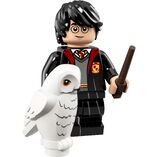
ЛЕГО Гарри с Буклей
Смотрите также
- Дни рождения Гарри Поттера
- Подарки Гарри Поттера
- Палочка Гарри Поттера
Примечания
- ↑ 1,0 1,1 1,2 Статья «Семья Поттеров» на Pottermore.
- ↑ Гарри Поттер и Проклятое дитя (пьеса).
- ↑ «Гарри Поттер и Дары Смерти: Часть 2»
- ↑ Возможно из-за фигуры взмаха палочки при «Авада Кедавра»
- ↑ 5,0 5,1 5,2 5,3 «Гарри Поттер и Кубок Огня»
- ↑ 6,0 6,1 6,2 6,3 6,4 6,5 6,6 6,7 «Гарри Поттер и Дары Смерти»
- ↑ 7,0 7,1 7,2 7,3 «Гарри Поттер и Философский камень»
- ↑ «Гарри Поттер и Принц-полукровка»
- ↑ слово «Figulus» означает «гончар», т.е. то же, что и «Potter».
- ↑ «Гарри взял губку, вымыл окно, машину, потом постриг газон, унавозил клумбы, обрезал и полил розовые кусты».«Гарри Поттер и Тайная комната» — Глава 1. День рождения — хуже некуда
- ↑ «Гарри Поттер и узник Азкабана» — Глава 2. Большая ошибка тётушки Мардж
- ↑ «Гарри Поттер и Орден Феникса» — Глава 1. Дадли досталось
- ↑ Wizard of the Month Archive jkrowling.com
- ↑ Найдена могила Гарри Поттера Дни.Ру
- ↑ .Билл Гейтс снялся в роли Гарри Поттера Компьюлента
- ↑ Назван настоящий возраст Гарри Поттера Дни.ру
- ↑ Чьим голосом говорит Гарри Поттер по-русски kp.ru
- ↑ Волшебник на миллион Коммерсант.ru
Ссылки
|
п•о•р Карьера Гарри Поттера |
||
|---|---|---|
| Предшественник | Должность | ㅤПреемникㅤㅤ |
| Анджелина Джонсон | Капитан сборной факультета Гриффиндора по квиддичу 1996 — 1997 |
Неизвестен |
| Неизвестен | Глава мракоборческого центра с 2007 |
Неизвестен |
|
п•о•р Турнир Трёх Волшебников · 1994 |
||
|---|---|---|
| Коллегия судей | Альбус Дамблдор · Барти Крауч · Игорь Каркаров · Корнелиус Фадж · Людовик Бэгмен · Олимпия Максим |  |
| Школы | Дурмстранг · Хогвартс · Шармбатон | |
| Чемпионы | Виктор Крам · Гарри Поттер · Седрик Диггори · Флёр Делакур | |
| Турнир | Первый этап · Второй этап · Третий этап | |
| Существа | Акромантул · Боггарт · Василиск · Гриндилоу · Дементор · Драконы · Русалки и тритоны · Сфинкс | |
| Пленники второго этапа | Габриэль Делакур · Гермиона Грейнджер · Рон Уизли · Чжоу Чанг | |
| Объекты | Золотое яйцо · Кубок Огня · Кубок Турнира |
|
п•о•р Отряд Дамблдора |
|
|---|---|
| Основатели | Гарри Поттер · Гермиона Грейнджер · Рон Уизли |
| Лидеры | Гарри Поттер · Полумна Лавгуд · Невилл Долгопупс · Джинни Уизли |
| Участники |
|
| Сочувствовавшие и помогавшие |
|
|
п•о•р Британское Министерство магии |
|||
|---|---|---|---|
| Министры магии | |||
|
|||
| Работники Министерства магии Орфорд Амбридж · Долорес Амбридж · Миллисента Багнолд · Боб · Бродерик Боуд · Амелия Боунс · Кингсли Бруствер · Альберт Бут · Людовик Бэгмен · Бэзил · Ваканда · Улик Гамп · Гесфестус Гор · Гермиона Грейнджер · Аластор Грюм · Отталин Гэмбл · Уилки Двукрест · Юджина Дженкинс · Берта Джоркинс · Амос Диггори · Элдрич Диггори · Алиса Долгопупс · Фрэнк Долгопупс · Джон Долиш · Присцилла Дюпон · Максимилиан Крауди · Барти Крауч · Дирк Крессвелл · Венузия Крикерли · Сол Крокер · Реджинальд Кроткотт · Артемизия Лафкин · Радольфус Лестрейндж · Нобби Лич · Лайелл Люпин · Минерва Макгонагалл · Тиверий Маклагген · Лоркан МакЛайрд · Уолден Макнейр · Хамиш МакФерлeн · Дугалд Макфэйл · Септимус Малфой · Эрик Манч · Гризельда Марчбэнкс · Гортензия Миллифут · Мирафора Мина · Элоиз Минтамбл · Гарольд Минчум · Арнольд Миргуд · Катберт Мокридж · Левина Монкстэнли · Орабелла Наттли · Портеус Натчбулл · Боб Огден · Тиберий Огден · Уильям Олдертон · Эванджелина Орпингтон · Анктуоус Осберт · Персей Паркинсон · Перкинс · Джастус Пилливикл · Гарри Поттер · Праудфут · Альберт Ранкорн · Гавейн Робардс · Дамокл Роули · Август Руквуд · Мнемона Рэдфорд · Ньют Саламандер · Руфус Скримджер · Леонард Спенсер-Мун · Фэрис Спэвин · Гроган Стамп · Сэвидж · Вильгельмина Тафт · Игнатий Тафт · Пий Толстоватый · Нимфадора Тонкс · Демпстер Уигглсвэйд · Артур Уизли · Перси Уизли · Уильямсон · Мистер Уорлок · Элфинстоун Урхарт · Руфус Фадж · Корнелиус Фадж · Джозефина Флинт · Бэзил Флэк · Гектор Фоули · Муфалда Хмелкирк · Миссис Чанг · Арчер Эвермонд · Миссис Эджком · Корбан Яксли |
|||
| Структура Бюро по связям с кентаврами · Отдел выявления и конфискации поддельных защитных заклинаний и оберегов · Отдел магических игр и спорта · Отдел магических происшествий и катастроф · Отдел магического правопорядка · Отдел магического транспорта · Отдел магического хозяйства · Отдел международного магического сотрудничества · Сектор борьбы с незаконным использованием изобретений маглов · Отдел регулирования магических популяций и контроля над ними · Министр магии и обслуживающий персонал · Сектор борьбы с неправомерным использованием магии · Отдел тайн · Комиссия по учёту магловских выродков |
|||
| См. также: | Визенгамот · Международная конфедерация магов · Охрана Министерства магии · Волшебный патруль · Совет магического законодательства |
|
п•о•р Волшебник месяца |
|
|---|---|
| 2004 год | Феликс Саммерби · Гвеног Джонс · Донаган Тремлетт · Онория Наткомб · Урик Странный · Гленда Читток · Девлин Вайтхорн · Игнатия Уилдсмит |
| 2005 год | Дервент Шимплинг · Артемизия Лафкин · Мунго Бонам · Гондолина Олифант · Феликс Саммерби · Эльфрида Клагг · Чонси Олдридж · Бриджит Венлок · Гаспард Шинглтон · Фифи ЛаФолл · Шарлотта Пинкстоун · Боумен Райт |
| 2006 год | Джокунда Сайкс · Ярдли Платт · Дэйзи Доддеридж · Гроган Стамп · Фабиус Уоткинс · Дэйзи Хукам · Тарквин МакТавиш · Эрика Стейнрайт · Хамблдон Квинс · Идрис Оукби · Лоркан д`Эат · Лауренция Флетвок |
| 2007 год | Харви Риджбит · Мнемона Рэдфорд · Тилден Тутс · Магента Комсток · Пенелопа Пуффендуй · Салазар Слизерин · Годрик Гриффиндор · Кандида Когтевран · Альбус Дамблдор · Гарри Поттер |
|
п•о•р Карточки из шоколадных лягушек |
||
|---|---|---|
| Золотые | Аг Ненадежный · Бес малый · Бладвин Блад · Большая пурпурная жаба · Берти Ботт · Бран Кровожадный · Валлийский зелёный дракон · Венгерский хвосторог · Веретенница · Этельред Вспыльчивый · Гебридский чёрный дракон · Герпий Злостный · Гигантский кальмар · Гитраш · Глизень · Голиаф · Горный тролль · Гермиона Грейнджер · Гырг Грязный · Малодора Гримм · Годрик Гриффиндор · Альбус Дамблдор · Двупалый тритон · Дзю Йен · Армандо Диппет · Докси · Граф Влад Дракула · Единорог · Кельпи · Кандида Когтевран · Амарильо Лестат · Лукотрус · Мантикора · Корделия Мизерикордия · Моргольт · Монтегю Найтли · Норвежский горбатый дракон · Олгаф Отвратительный · Парацельс · Шарлотта Пинкстоун · Гарри Поттер · Пенелопа Пуффендуй · Румынский длиннорог · Леди Кармилла Сангвина · Руфус Скримджер · Летиция Сомноленс · Эдгар Струглер · Тролль · Сэр Герберт Уорней · Эаргит Безобразный · Фалько Эсалон · Феникс · Мамаша Хаббард · Циклоп · Энгист из Верхнего Барнтона · Баба-Яга | 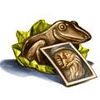 |
| Серебрянные | Андрос Неуязвимый · Освальд Бимиш · Венделина Странная · Альберик Граннион · Григорий Льстивый · Гвеног Джонс · Дэйзи Доддеридж · Керли Дюк · Киприан Йодль · Клиодна · Эльфрида Клегг · Королева Маб · Криспин Кронк · Гидеон Крумб · Артемизия Лафкин · Лаверна де Монморанси · Мопсус · Дунбар Оглторп · Чонси Олдридж · Гондолина Олифант · Мирабелла Планкетт · Боумен Райт · Ксавье Растрик · Феликс Саммерби · Леопольдина Смезвик · Бленхейм Сток · Сахарисса Тагвуд · Донаган Тремлетт · Альберта Тутхилл · Игнатия Уилдсмит · Джоселинд Уэдкок · Семь сыновей Фаддеуса Феркла · Фаддеус Феркл · Фулберт Пугливый · Димфна Фурмаг · Моргана ле Фэй · Цирцея · Гленда Читток · Дервент Шимплинг · Гаспард Шинглтон | |
| Бронзовые | Корнелиус Агриппа · Арчибальд Алдертон · Хиткот Барбари · Мусидора Барквиз · Флавиус Белби · Балфур Блейн · Беатрис Блоксам · Мунго Бонам · Кассандра Ваблатски · Девлин Вайтхорн · Бриджит Венлок · Стоддарт Визерс · Герман Винтрингам · Ганхильда из Горсмура · Миранда Гуссокл · Доркас Очаровательная · Мервин Злобный · Роланд Кегг · Элладора Кеттеридж · Грета Кечлав · Бердок Малдун · Бомонт Марджорибэнкс · Мерлин · Мертон Грэйвз · Мирон Вогтэйл · Гиффорд Оллертон · Орсайно Фрастон · Гленмор Пикс · Джастус Пилливикл · Родерик Пламптон · Ярдли Платт · Квонг По · Гулливер Поукби · Джокунда Сайкс · Ньют Саламандер · Хевлок Свитинг · Алмерик Соубридж · Гроган Стамп · Геспер Старки · Эдгар Струглер · Норвел Твонк · Тилли Ток · Селестина Уорлок · Адальберт Уоффлинг · Перпетуа Фанкорт · Гловер Хипворт · Уилфред Элфик · Энгист из Вудкрофта |
|
п•о•р Владельцы «Даров Смерти» |
||
|---|---|---|
| Бузинная палочка | Смерть (создатель) · Антиох Певерелл · Эмерик Отъявленный · Эгберт Эгоист · Годелот · Геревард · Варнава Деверилл · Локсий · Аркус или Ливий · (нет точных данных кто именно) · Майкью Грегорович · Геллерт Грин-де-Вальд · Альбус Дамблдор · Драко Малфой · Лорд Волан-де-Морт (не подчинялась) · Гарри Поттер | 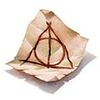 |
| Воскрешающий камень | Смерть (создатель) · Кадм Певерелл · Марволо Мракс · Морфин Мракс · Лорд Волан-де-Морт · Альбус Дамблдор · Гарри Поттер | |
| Мантия-невидимка | Смерть (создатель) · Игнотус Певерелл · Сын Игнотуса Певерелла · Иоланта Певерелл · (несколько поколений Поттеров) · Генри Поттер · Флимонт Поттер · Джеймс Поттер · Альбус Дамблдор · Гарри Поттер · Джеймс Сириус Поттер · Альбус Северус Поттер |
Гарри Поттер
Гарри Поттер — главный персонаж произведений про мальчика, который выжил после смертельного заклинания темного властелина, которого мир знал как Тома Редла младшего или как Волан-де-морта. Участник и победитель турнира трех волшебников. После победы над темным повелителем и его сторонниками стал мракоборцем.
Родители
Отцом мальчика был Джеймс Поттер, единственный сын Флимонта и Клавдии Поттер. Джеймс родился очень поздно, так как его родители не могли забеременеть, но после продажи компании главой семейства сразу родился сын Джеймс. Флимонт и Клавдия баловали мальчика и давали ему все самое лучшее — он рос в любви и довольстве, мальчик с детства рос наглым, но всю жизнь был против темных искусств.
Матерью мальчика была маглорожденная Лили Эванс, которая в первое время презирала Джеймса и его компанию за вечные издевательства над ее другом Северусом Снеггом. Однако, позже и сама разочаровалась в бывшем друге Северусе.
Джеймс и Лили начали встречаться на последних курсах и продолжили после окончания школы. Когда обоим родителям было 28 лет у них родился Гарри Поттер. Дед и бабка Гарри по отцовской линии не увидели своего внука.
Смерть родителей
Родители Гарри Поттера были противниками темного повелителя и являлись участниками организации «Орден Феникса» созванной для борьбы со сторонниками темного властелина. Одним из сторонников темного повелителя окажется бывший друг Лили Эванс, а именно Северус Снегг.
Находясь в трактире «Кабанья голова» Северус Снегг подслушает разговор Альбуса Дамблдора и Сивиллы Трелони, в котором прорицательница случайно предскажет падение темного лорда. Хозяин трактира Аберфорт Дамблдор обнаружит Северуса Снегга и выгонит его, тому так и не удалось узнать все пророчество, но все известные ему сведения были переданы темному повелителю. Из услышанного нельзя было сделать однозначный вывод о мальчике, которого Волан де морт отметит равным себе. Выбор был сделан самим Воландемортом между Гарри Поттером и Невиллом Долгопупсом. Именно темный властелин отметил мальчика как равного себе.
В дальнейшем темный властелин начал поиск мальчика и в этом ему помог лучший друг Джеймса Поттера — Питер Петтигрю, который и выдал местонахождение мальчика и его семьи лично темному повелителю.
Темный повелитель обнаружит дом Поттеров и снимет тайну хранителя, а затем убьет Джеймса Поттера, который попробует остановить Воландеморта без палочки. Лили Поттер не успеет убежать и начнет умолять темного мага не убивать ее сына. После того как Лили Эванс была убита темный властелин попробует убить мальчика, но заклинание отскочит в самого Тома Редла, и тот потеряет свои силы передав часть своей души в Гарри Поттера.
Сириус Блэк посоветовал Поттерам передать тайну Питеру Петтигрю надеясь, но то что пожиратели смерти продолжат искать его, так как никто не поверит, что Джеймс передал тайну хранителя Питеру. Сириус забеспокоится и наведается в жилище Питера Петтигрю, где не обнаружит хозяина, а потом побежит к дому Поттеров.
Сириус Блэк первым обнаружит уничтоженный дом и убитых друзей, а затем захочет стать опекуном мальчика. Однако, по требованию Альбуса Дамблдора мальчика заберет Рубеус Хагрид и передаст родственникам Лили …
Слухи среди волшебников
Пока Гарри рос среди маглов в семье своей тети Петунии и ее мужа Вернона в мире волшебников стали появляться странные слухи. Многие пожиратели смерти и даже обычные волшебники начали думать, что темный властелин пытался убить мальчика, потому что ему было предсказано, что Гарри Поттер станет его главным соперником, который смог бы стать более сильным и могущественным темным волшебником, чем сам темный властелин.
Многие пожиратели смерти начали думать, что именно Гарри Поттер возглавит их и станет новым темным властелином. Именно поэтому Драко Малфой со своей компанией и захочет подружиться с Гарри.
Однако, эти слухи не подтвердились.
Детство мальчика
Гарри рос болезненным и слабым. Ему часто приходилось недоедать, работать по дому и донашивать одежду своего брата. Несмотря на это он хорошо убегал от всех своих неприятностей, и даже мог ненароком применить случайную магию. Несколько раз он очень странно убегал от преследователей, среди которых был и его брат. Гарри имел проблемы со зрением, которые ему передались от отца.
Все это время он думал, что его родители погибли в автомобильной аварии и не знал о своей магической природе.
Письма от неизвестных
Незадолго до своего 11-го дня рождения Гарри случайно наткнулся на странное письмо адресованное ему и начал вскрывать его в компании дяди и брата. Дядя отобрал письмо и далее не давал Гарри прочитать ни одно такое письмо, которых было очень много.
Пытаясь отстранить мальчика от неизвестных дядя Вернон увозит семью на необитаемый остров и селится в непригодном для жилья острове.
На остров прибывает посланец Рубеус Хагрид, который рассказал мальчику правду о его родителях и о нем. Так, мальчик узнает о том, что он волшебник и его приглашают на обучение в школу магии.
Гарри без труда решает бросить беспросветный для себя мир ради школы Хогвартс, который становится для него домом.
Школа Хогвартс
Перед посещением школы Гарри Поттер знакомится с представителем одного из древнейших чистокровных семейств — Роном Уизли, а также с маглорожденной Гермионой Грейнджер. Ребята становятся лучшими друзьями!
В школе Гарри начинает постигать азы магии, больше узнает о себе и о других волшебниках. Так, Гарри узнает о живом, но слабом и лишенном всех сил темном волшебнике, который пьет кровь единорога чтобы вернуть свою силу с помощью философского камня.
Гарри удается одолеть прислужника темного властелина и он заканчивает обучение в школе став настоящим героем. Дальше Гарри и представить себе не может жизни без Хогвартса!
Противостояние с темным повелителем
Темный властелин потерял свою силу после попытки убить Гарри Поттера, но он выжил, и не оставлял попыток вернуться к прежнему могуществу.
В первый год своего обучения Гарри Поттеру удалось не дать темному властелину воскреснуть с помощью философского камня, и тогда тот практически перестал верить в свое возрождение.
На второй год Гарри Поттер обнаружил тайник темного властелина, где скрывалась сущность Тома Реддла, сущность о которой мальчик ничего не подозревал до последнего. Гарри уничтожил причину появления сущности — дневник Тома Реддла.
На третий год темный повелитель уже потерял всякие надежды на возвращение пока его бывший слуга не появился перед ним с подарком. Гарри удалось узнать, что его родителей предал не Сириус Блэк, а Питер Петтигрю. Питер испугался своих школьных друзей и вернулся к бывшему хозяину поймав работницу министерства магии Берту Джоркинс, которая знала о готовящемся турнире трех волшебников. С помощью своей магии темный повелитель прочитал память помощницы Барти Краутча старшего и придумал план.
На четвертый год темный властелин внедрил Барти Краутча младшего в школу Хогвартс под видом преподавателя защиты от темных искусств Аластора Грюма, который должен был выманить Гарри Поттера в указанное место дабы провести особый ритуал по возрождению.
Гарри прибыл на кладбище семейства Реддлов вместе с Седриком Дигори и смог скрыться после возрождения темного волшебника взяв с собой тело Дигори. Гарри рассказал Альбусу Дамбдору о возрождении темного властелина.
На пятый год жизни в мире волшебников Гарри обнаруживает, что ему не верят. Его слова о возвращении темного волшебника считают попыткой получить еще большую славу. А министр магии Корнелиус Освальд Фадж считает, что потворствующий этому Альбус Дамблдор пытается захватить власть в министерстве магии. Это вылилось в преследование мальчика, на которого было совершено покушение с помощью двух дементоров Азкабана, которые напали на Гарри по велению первого председателя министра магии Долорес Джейн Амбридж.
Часть сотрудников министерства магии убедятся в возвращении темного волшебника и потеряют доверие к министру Фаджу, который не сможет удержать власть.
Шестой год в жизни Гарри станет переломным. Он начнет получать сведения от самого Альбуса Дамлдора. Гарри узнает все о темном повелителе и сможет понимать его так же хорошо, как и директор Хогвартса. От Альбуса Дамблдора Гарри узнает о необходимости уничтожения крестражей.
Гарри и Альбус Дамблдор обнаружат еще один крестраж, но не успеют его уничтожить из-за проникновения в школу пожирателей смерти и убийства школьного директора.
На седьмой год Гарри не вернется в школу, и будет выполнять задачу поставленную Альбусом Дамблором.
Гарри начнет скрываться от министерства магии, власть в котором захватят прислужники темного властелина Воландеморта. Он сумеет обнаружить:
Медальон Слизерина в министерстве магии, которым владела Долорес Джейн Амбридж.
Чашу Пенелопы Пуффендуй в хранилище Лестрейнджей.
Диадему Кандиды Коктевран в выручай-комнате.
Темный повелитель поймет, что Гарри знает о крестражах и нападет на замок в который проник Гарри Поттер. Там же Гарри Поттер узнает, что он также является крестражем и без уничтожения его как крестража темный повелитель останется бессмертным.
Гарри пожертвует собой ради того чтобы спасти остальных: друзей, любимую, учителей и прочих безымянных волшебников и маглов. Перед тем как отправиться к темному повелителю Гарри передаст свою задачу новому хранителю тайны: Невиллу Долгопупсу, который должен будет убить змею Нагайну.
Для того чтобы уничтожить крестраж внутри себя, Гарри не должен был сопротивляться врагу, сам Воландеморт должен был убить свой крестраж внутри Гарри. Все это время сам темный властелин не будет знать о том, что в Гарри содержится его крестраж!
После того как Воландеморт применит заклинание Авада Кедавра против Гарри, мальчик снова выживет, но будет убит крестраж темного волшебника. В это время Гарри решит не пугать своего врага известием о том, что он жив.
Темный властелин применит заклинания Круциатус против «притворяющегося мертвым» Гарри, но заклинание не подействует. Для того чтобы непростительные заклинания подействовали, их исполнитель должен хотеть убить, причинить боль и контролировать другого волшебника, а так как темный властелин боялся того что мальчик снова выжил заклинание не оказало никакого эффекта на Гарри.
В этот момент в живых из крестражей оставалась только змея Нагайна. Темный повелитель решил показать мертвое тело «избранного» защитникам замка, так как не хотел убивать всю магическую кровь.
Темный властелин призвал распределяющую шляпу и сжег ее, так как далее не планировал распределять учеников на другие факультеты. В этот момент Гарри поднялся из рук Хагрида и спрятался под мантией невидимкой. А Невилл достал из горящей шляпы меч Годрика Гриффиндора и поразил змею Нагайну. Так пал последний крестраж.
В это время Воландеморт не знал, о том что Гарри Поттер выжил. Гарри отразил луч темного властелина направленный в Молли Уизли и снял мантию.
Волондеморт был удивлен тем, что Гарри Поттер жив … В этот момент он надеялся только на свою бузинную палочку, но настоящим владельцем бузинной палочки был Гарри Поттер. Она не помогла темному властелину и он был убит собственным отраженным заклинанием.
После битвы за Хогвартс волшебники начали искать пропавших друзей и увидели ужас войны. Погибших было так много, что их не успевали оплакать.
Личная жизнь
Гарри не проявлял особого интереса к противоположному полу до встречи с Чжоу Чанг, которая была спортменкой как и он. После того как она начала защищать предавшую «Отряд Дамблдора» подругу и обвинять Гермиону, Гарри с ней поссорился.
На шестом курсе Гарри начинает встречаться с сестрой своего лучшего друга, Джинни Уизли. Пара расталась на год — пока Гарри искал крестражи, так как Гарри не хотел рисковать ее жизнью. Позже они снова начнут встречаться и поженятся.
У Гарри Поттера родятся трое детей от Джинни Уизли.
– Джеймс Сириус Поттер
– Альбус Северус Поттер
– Лили Полумна Поттер
Работа
После окончательного падения темного властелина Гарри Поттер устроился в министерство магии и стал мракоборцем.
Важные факты о Гарри Поттере:
Плохое зрение. Возможно, главный персонаж изначально не носил очки, и такой вид мальчик обрел уже перед изданием первой книги. Однако, из-за ужасного зрения Гарри не мог хорошо играть в спортивные игры и не мог уметь летать на метле как будто родился для Квиддича. В детстве Гарри Поттер летал на игрушечной метле, которая не взлетала слишком высоко.
Прообраз Гарри Поттера. Прообразом Гарри Поттера является главный персонаж «Властелина колец» Фродо Сумкин. Фродо был рыжим, и не носил очки. Родители Фродо утонули при неизвестных обстоятельствах.
Змееуст. В тот день, когда мальчик выжил после смертельного заклинания темного властелина часть души темного мага вошла в Гарри Поттера. Эта магия именуемая крестражем передала Гарри часть сил темного повелителя, поэтому Гарри Поттер умел разговаривать со змеями.
Впервые Гарри случайно заговорил со змеей в день рождения своего брата Дадли в Лондонском зоопарке.
Уже на втором курсе обучения в школе Хогвартс Гарри приказывает змее не нападать на маглорожденного пуффендуйца Джастина, но школьники восприняли этот случай как приказ напасть на Джастина. Вся школа узнала, что Гарри змееуст и слухи о том, что он может стать темным волшебником снова усилились.
Владелец бузиной палочки. После того как Альбус Дамблдор получил ранение своей руки, тот пожелал похоронить силу своей бузиной палочки, но это не возможно согласно другим историческим фактам. Сила палочки не может умереть из-за смерти ее хозяина даже если тот не был побежден. Так, Геллерт Грин-де-вальд просто украл палочку.
Также, план Альбуса Дамблдора не был исполнен из-за случайности — Драко Малфой сумел провести пожирателей смерти в замок Хогвартс и применил обезоруживающее заклинание против Альбуса Дамблдора. Таким образом, истинным владельцем бузиной палочки стал Драко Малфой.
После доставки Гарри Поттера и его друзей в поместье Малфоев произошла стычка, в результате которой Гарри Поттер одолел Драко Малфоя, что послужило причиной для бузиной палочки слушаться Гарри Поттера.
Будьте в курсе новых статей и новостей через наш Telegram-канал.
Дата добавления: 2-01-2013, 16:52 | Просмотров: 60906
 |
|
|
|
| Author | J. K. Rowling |
|---|---|
| Cover artist | Mary GrandPré |
| Country | United Kingdom |
| Language | English |
| Genre | Fantasy |
| Publisher | Bloomsbury Publishing (UK) Scholastic Press (US) |
| Published | 26 June 1997 – 21 July 2007 (initial publication) |
| Media type | Print (hardback & paperback) Audiobook E-book |
| No. of books | 7 |
| Website | www.wizardingworld.com |
Harry Potter is a series of seven fantasy novels written by British author J. K. Rowling. The novels chronicle the lives of a young wizard, Harry Potter, and his friends Hermione Granger and Ron Weasley, all of whom are students at Hogwarts School of Witchcraft and Wizardry. The main story arc concerns Harry’s struggle against Lord Voldemort, a dark wizard who intends to become immortal, overthrow the wizard governing body known as the Ministry of Magic and subjugate all wizards and Muggles (non-magical people).
The series was originally published in English by Bloomsbury in the United Kingdom and Scholastic Press in the United States. All versions around the world are printed by Grafica Veneta in Italy.[1] A series of many genres, including fantasy, drama, coming-of-age fiction, and the British school story (which includes elements of mystery, thriller, adventure, horror, and romance), the world of Harry Potter explores numerous themes and includes many cultural meanings and references.[2] According to Rowling, the main theme is death.[3] Other major themes in the series include prejudice, corruption, and madness.[4]
Since the release of the first novel, Harry Potter and the Philosopher’s Stone, on 26 June 1997, the books have found immense popularity, positive reviews, and commercial success worldwide. They have attracted a wide adult audience as well as younger readers and are often considered cornerstones of modern young adult literature.[5] As of February 2018, the books have sold more than 500 million copies worldwide, making them the best-selling book series in history, and have been translated into more than eighty languages.[6] The last four books consecutively set records as the fastest-selling books in history, with the final instalment selling roughly 2.7 million copies in the United Kingdom and 8.3 million copies in the United States within twenty-four hours of its release.
The original seven books were adapted into an eight-part namesake film series by Warner Bros. Pictures. In 2016, the total value of the Harry Potter franchise was estimated at $25 billion,[7] making Harry Potter one of the highest-grossing media franchises of all time. Harry Potter and the Cursed Child is a play based on a story co-written by Rowling.
The success of the books and films has allowed the Harry Potter franchise to expand with numerous derivative works, a travelling exhibition that premiered in Chicago in 2009, a studio tour in London that opened in 2012, a digital platform on which J. K. Rowling updates the series with new information and insight, and a pentalogy of spin-off films premiering in November 2016 with Fantastic Beasts and Where to Find Them, among many other developments. Themed attractions, collectively known as The Wizarding World of Harry Potter, have been built at several Universal Parks & Resorts amusement parks around the world.
Plot
Early years
The series follows the life of a boy named Harry Potter. In the first book, Harry Potter and the Philosopher’s Stone, Harry lives in a cupboard under the stairs in the house of the Dursleys, his aunt, uncle and cousin. The Dursleys consider themselves perfectly normal, but at the age of eleven, Harry discovers that he is a wizard. He meets a half-giant named Hagrid who invites him to attend the Hogwarts School of Witchcraft and Wizardry. Harry learns that as a baby, his parents were murdered by the dark wizard Lord Voldemort. When Voldemort attempted to kill Harry, his curse rebounded and Harry survived with a lightning-shaped scar on his forehead.
Harry becomes a student at Hogwarts and is sorted into Gryffindor House. He gains the friendship of Ron Weasley, a member of a large but poor wizarding family, and Hermione Granger, a witch of non-magical, or Muggle, parentage. Harry encounters the school’s potions master, Severus Snape, who displays a dislike for him; the rich pure-blood Draco Malfoy whom he develops an enmity with; and the Defence Against the Dark Arts teacher, Quirinus Quirrell, who turns out to be allied with Lord Voldemort. The first book concludes with Harry’s confrontation with Voldemort, who, in his quest to regain a body, yearns to gain the power of the Philosopher’s Stone, a substance that bestows everlasting life.
Harry Potter and the Chamber of Secrets describes Harry’s second year at Hogwarts. Students are attacked and petrified by an unknown creature; wizards of Muggle parentage are the primary targets. The attacks appear related to the Chamber of Secrets, a fifty-year-old mystery at the school. Harry discovers an ability to speak the snake language Parseltongue, which he learns is rare and associated with the Dark Arts. When Hermione is attacked, Harry and Ron uncover the chamber’s secrets and enter it. Harry discovers that the chamber was opened by Ron’s younger sister, Ginny Weasley, who was possessed by an old diary in her belongings. The memory of Tom Marvolo Riddle, Voldemort’s younger self, resided inside the diary and unleashed the basilisk, an ancient monster that kills those who make direct eye contact. Harry draws the Sword of Gryffindor from the Sorting Hat, slays the basilisk and destroys the diary.
In the third novel, Harry Potter and the Prisoner of Azkaban, Harry learns that he is targeted by Sirius Black, an escaped convict who allegedly assisted in his parents’ murder. As Harry struggles with his reaction to the dementors – creatures guarding the school that feed on despair – he reaches out to Remus Lupin, a new professor who teaches him the Patronus charm. On a windy night, Ron is dragged by a black dog into the Shrieking Shack; Harry and Hermione follow. The dog is revealed to be Sirius Black. Lupin enters the shack and explains that Black was James Potter’s best friend; he was framed by Peter Pettigrew, who hides as Ron’s pet rat, Scabbers. As the full moon rises, Lupin transforms into a werewolf and bounds away; the group chase after him but are surrounded by dementors. They are saved by a mysterious figure who casts a stag Patronus. This is later revealed to be a future version of Harry, who traveled back in time with Hermione using the Time Turner. The duo help Sirius escape on a Hippogriff.
Voldemort returns
The former 1st floor Nicholson’s Cafe now renamed Spoon in Edinburgh where J. K. Rowling wrote the first few chapters of Harry Potter and the Philosopher’s Stone
In Harry’s fourth year of school (detailed in Harry Potter and the Goblet of Fire), he is unwillingly entered in the Triwizard Tournament, a contest between schools of witchcraft and wizardry. Harry is Hogwarts’ second participant after Cedric Diggory, an unusual occurrence that causes his friends to distance themselves from him. He competes against schools Beauxbatons and Durmstrang with the help of the new Defence Against the Dark Arts professor, Alastor «Mad-Eye» Moody. Harry claims the Triwizard Cup with Cedric, but in doing so is teleported to a graveyard where Voldemort’s supporters convene. Moody reveals himself be to Barty Crouch, Jr, a Death Eater. Harry manages to escape, but Cedric is killed and Voldemort is resurrected using Harry’s blood.
In the fifth book, Harry Potter and the Order of the Phoenix, the Ministry of Magic refuses to believe that Voldemort has returned. Dumbledore re-activates the Order of the Phoenix, a secret society to counter Voldemort; meanwhile, the Ministry appoints Dolores Umbridge as the High Inquisitor of Hogwarts. Umbridge bans the Defense Against the Dark Arts; in response, Hermione and Ron form «Dumbledore’s Army», a secret group where Harry teaches what Umbridge forbids. Harry is punished for disobeying Umbridge, and dreams of a dark corridor in the Ministry of Magic. Near the end of the book, Harry falsely dreams of Sirius being tortured; he races to the Ministry where he faces Death Eaters. The Order of the Phoenix saves the teenagers’ lives, but Sirius is killed. A prophecy concerning Harry and Voldemort is then revealed: one must die at the hands of the other.
In the sixth book, Harry Potter and the Half-Blood Prince, Snape teaches Defense Against the Dark Arts while Horace Slughorn becomes the Potions master. Harry finds an old textbook with annotations by the Half-Blood Prince, due to which he achieves success in Potions class. Harry also takes lessons with Dumbledore, viewing memories about the early life of Voldemort in a device called a Pensieve. Harry learns from a drunken Slughorn that he used to teach Tom Riddle, and that Voldemort divided his soul into pieces, creating a series of Horcruxes. Harry and Dumbledore travel to a distant lake to destroy a Horcrux; they succeed, but Dumbledore weakens. On their return, they find Draco Malfoy and Death Eaters attacking the school. The book ends with the killing of Dumbledore by Professor Snape, the titular Half-Blood Prince.
In Harry Potter and the Deathly Hallows, the seventh novel in the series, Lord Voldemort gains control of the Ministry of Magic. Harry, Ron and Hermione learn about the Deathly Hallows, legendary items that lead to mastery over death. The group infiltrate the ministry, where they steal a locket Horcrux, and visit Godric’s Hollow, where they are attacked by Nagini. A silver doe Patronus leads them to the Sword of Gryffindor, with which they destroy the locket. They steal a Horcrux from Gringotts and travel to Hogwarts, culminating in a battle with Death Eaters. Snape is killed by Voldemort out of paranoia, but lends Harry his memories before he dies. Harry learns that Snape was always loyal to Dumbledore, and that he himself is a Horcrux. Harry surrenders to Voldemort and dies. The defenders of Hogwarts continue to fight on; Harry is resurrected, faces Voldemort and kills him.
An epilogue titled «Nineteen Years Later» describes the lives of the surviving characters and the impact of Voldemort’s death. Harry and Ginny are married with three children, and Ron and Hermione are married with two children.
Style and allusions
Genre and style
The novels fall into the genre of fantasy literature, and qualify as a type of fantasy called «urban fantasy», «contemporary fantasy», or «low fantasy». They are mainly dramas, and maintain a fairly serious and dark tone throughout, though they do contain some notable instances of tragicomedy and black humour. In many respects, they are also examples of the bildungsroman, or coming of age novel,[8] and contain elements of mystery, adventure, horror, thriller, and romance. The books are also, in the words of Stephen King, «shrewd mystery tales»,[9] and each book is constructed in the manner of a Sherlock Holmes-style mystery adventure. The stories are told from a third person limited point of view with very few exceptions (such as the opening chapters of Philosopher’s Stone, Goblet of Fire and Deathly Hallows and the first two chapters of Half-Blood Prince).
The series can be considered part of the British children’s boarding school genre, which includes Rudyard Kipling’s Stalky & Co., Enid Blyton’s Malory Towers, St. Clare’s and the Naughtiest Girl series, and Frank Richards’s Billy Bunter novels: the Harry Potter books are predominantly set in Hogwarts, a fictional British boarding school for wizards, where the curriculum includes the use of magic.[10] In this sense they are «in a direct line of descent from Thomas Hughes’s Tom Brown’s School Days and other Victorian and Edwardian novels of British public school life», though they are, as many note, more contemporary, grittier, darker, and more mature than the typical boarding school novel, addressing serious themes of death, love, loss, prejudice, coming-of-age, and the loss of innocence in a 1990s British setting.[11][12]
In Harry Potter, Rowling juxtaposes the extraordinary against the ordinary.[13] Her narrative features two worlds: a contemporary world inhabited by non-magical people called Muggles, and another featuring wizards. It differs from typical portal fantasy in that its magical elements stay grounded in the mundane.[14] Paintings move and talk; books bite readers; letters shout messages; and maps show live journeys, making the wizarding world both exotic and familiar.[13][15] This blend of realistic and romantic elements extends to Rowling’s characters. Their names are often onomatopoeic: Malfoy is difficult, Filch unpleasant and Lupin a werewolf.[16][17] Harry is ordinary and relatable, with down-to-earth features such as wearing broken glasses;[18] the scholar Roni Natov terms him an «everychild».[19] These elements serve to highlight Harry when he is heroic, making him both an everyman and a fairytale hero.[18][20]
Each of the seven books is set over the course of one school year. Harry struggles with the problems he encounters, and dealing with them often involves the need to violate some school rules. If students are caught breaking rules, they are often disciplined by Hogwarts professors. The stories reach their climax in the summer term, near or just after final exams, when events escalate far beyond in-school squabbles and struggles, and Harry must confront either Voldemort or one of his followers, the Death Eaters, with the stakes a matter of life and death – a point underlined, as the series progresses, by characters being killed in each of the final four books.[21][22] In the aftermath, he learns important lessons through exposition and discussions with head teacher and mentor Albus Dumbledore. The only exception to this school-centred setting is the final novel, Harry Potter and the Deathly Hallows, in which Harry and his friends spend most of their time away from Hogwarts, and only return there to face Voldemort at the dénouement.[21]
Allusions
The Harry Potter stories feature imagery and motifs drawn from Arthurian myth and fairytales. Harry’s ability to draw the Sword of Gryffindor from the Sorting Hat resembles the Arthurian sword in the stone legend.[23] His life with the Dursleys has been compared to Cinderella.[24] Hogwarts resembles a medieval university-cum-castle with several professors who belong to an Order of Merlin; Old Professor Binns still lectures about the International Warlock Convention of 1289; and a real historical person, a 14th-century scribe, Sir Nicolas Flamel, is described as a holder of the Philosopher’s Stone.[25] Other medieval elements in Hogwarts include coats-of-arms and medieval weapons on the walls, letters written on parchment and sealed with wax, the Great Hall of Hogwarts which is similar to the Great Hall of Camelot, the use of Latin phrases, the tents put up for Quidditch tournaments are similar to the «marvellous tents» put up for knightly tournaments, imaginary animals like dragons and unicorns which exist around Hogwarts, and the banners with heraldic animals for the four Houses of Hogwarts.[25]
Many of the motifs of the Potter stories such as the hero’s quest invoking objects that confer invisibility, magical animals and trees, a forest full of danger and the recognition of a character based upon scars are drawn from medieval French Arthurian romances.[25] Other aspects borrowed from French Arthurian romances include the use of owls as messengers, werewolves as characters, and white deer.[25] The American scholars Heather Arden and Kathrn Lorenz in particular argue that many aspects of the Potter stories are inspired by a 14th-century French Arthurian romance, Claris et Laris, writing of the «startling» similarities between the adventures of Potter and the knight Claris.[25] Arden and Lorenz noted that Rowling graduated from the University of Exeter in 1986 with a degree in French literature and spent a year living in France afterwards.[25]
Like C. S. Lewis’s The Chronicles of Narnia, Harry Potter also contains Christian symbolism and allegory. The series has been viewed as a Christian moral fable in the psychomachia tradition, in which stand-ins for good and evil fight for supremacy over a person’s soul.[26] Children’s literature critic Joy Farmer sees parallels between Harry and Jesus Christ.[27] Comparing Rowling with Lewis, she argues that «magic is both authors’ way of talking about spiritual reality».[28] According to Maria Nikolajeva, Christian imagery is particularly strong in the final scenes of the series: Harry dies in self-sacrifice and Voldemort delivers an «ecce homo» speech, after which Harry is resurrected and defeats his enemy.[29]
Rowling stated that she did not reveal Harry Potter‘s religious parallels in the beginning because doing so would have «give[n] too much away to fans who might then see the parallels».[30] In the final book of the series Harry Potter and the Deathly Hallows, Rowling makes the book’s Christian imagery more explicit, quoting both Matthew 6:21 and 1 Corinthians 15:26 (King James Version) when Harry visits his parents’ graves.[30] Hermione Granger teaches Harry Potter that the meaning of these verses from the Christian Bible are «living beyond death. Living after death», which Rowling states «epitomize the whole series».[30][31][32] Rowling also exhibits Christian values in developing Albus Dumbledore as a God-like character, the divine, trusted leader of the series, guiding the long-suffering hero along his quest. In the seventh novel, Harry speaks with and questions the deceased Dumbledore much like a person of faith would talk to and question God.[33]
Themes
Harry Potter‘s overarching theme is death.[34][35] In the first book, when Harry looks into the Mirror of Erised, he feels both joy and «a terrible sadness» at seeing his desire: his parents, alive and with him.[36] Confronting their loss is central to Harry’s character arc and manifests in different ways through the series, such as in his struggles with Dementors.[36][37] Other characters in Harry’s life die; he even faces his own death in Harry Potter and the Deathly Hallows.[38] The series has an existential perspective – Harry must grow mature enough to accept death.[39] In Harry’s world, death is not binary but mutable, a state that exists in degrees.[40] Unlike Voldemort, who evades death by separating and hiding his soul in seven parts, Harry’s soul is whole, nourished by friendship and love.[39]
Love distinguishes Harry and Voldemort. Harry is a hero because he loves others, even willing to accept death to save them; Voldemort is a villain because he does not.[41] Harry carries the protection of his mother’s sacrifice in his blood; Voldemort, who wants Harry’s blood and the protection it carries, does not understand that love vanquishes death.[27]
Rowling has spoken about thematising death and loss in the series. Soon after she started writing Philosopher’s Stone, her mother died; she said that «I really think from that moment on, death became a central, if not the central theme of the seven books».[42] Rowling has described Harry as «the prism through which I view death», and further stated that «all of my characters are defined by their attitude to death and the possibility of death».[43]
While Harry Potter can be viewed as a story about good vs. evil, its moral divisions are not absolute.[44][45] First impressions of characters are often misleading. Harry assumes in the first book that Quirrell is on the side of good because he opposes Snape, who appears to be malicious; in reality, Quirrell is an agent of Voldemort, while Snape is loyal to Dumbledore. This pattern later recurs with Moody and Snape.[44] In Rowling’s world, good and evil are choices rather than inherent attributes: second chances and the possibility of redemption are key themes of the series.[46][47] This is reflected in Harry’s self-doubts after learning his connections to Voldemort, such as Parseltongue;[46] and prominently in Snape’s characterisation, which has been described as complex and multifaceted.[48] In some scholars’ view, while Rowling’s narrative appears on the surface to be about Harry, her focus may actually be on Snape’s morality and character arc.[49][50]
Rowling said that, to her, the moral significance of the tales seems «blindingly obvious». In the fourth book, Dumbledore speaks of a «choice between what is right and what is easy»; Rowling views this as a key theme, «because that … is how tyranny is started, with people being apathetic and taking the easy route and suddenly finding themselves in deep trouble».[51]
Academics and journalists have developed many other interpretations of themes in the books, some more complex than others, and some including political subtexts. Themes such as normality, oppression, survival, and overcoming imposing odds have all been considered as prevalent throughout the series.[52] Similarly, the theme of making one’s way through adolescence and «going over one’s most harrowing ordeals – and thus coming to terms with them» has also been considered.[53] Rowling has stated that the books comprise «a prolonged argument for tolerance, a prolonged plea for an end to bigotry» and that they also pass on a message to «question authority and… not assume that the establishment or the press tells you all of the truth».[54]
Development history
In 1990, Rowling was on a crowded train from Manchester to London when the idea for Harry suddenly «fell into her head». Rowling gives an account of the experience on her website saying:
«I had been writing almost continuously since the age of six but I had never been so excited about an idea before. I simply sat and thought, for four (delayed train) hours, and all the details bubbled up in my brain, and this scrawny, black-haired, bespectacled boy who did not know he was a wizard became more and more real to me.»
Rowling completed Harry Potter and the Philosopher’s Stone in 1995 and the manuscript was sent off to several prospective agents.[56] The second agent she tried, Christopher Little, offered to represent her and sent the manuscript to several publishers.[57]
Publishing history
The logo used in British, Australian, and Canadian editions before 2010, which uses the typeface Cochin Bold[58]
After twelve other publishers had rejected Philosopher’s Stone, Bloomsbury agreed to publish the book.[59] Despite Rowling’s statement that she did not have any particular age group in mind when beginning to write the Harry Potter books, the publishers initially targeted children aged nine to eleven.[60] On the eve of publishing, Rowling was asked by her publishers to adopt a more gender-neutral pen name in order to appeal to the male members of this age group, fearing that they would not be interested in reading a novel they knew to be written by a woman. She elected to use J. K. Rowling (Joanne Kathleen Rowling), using her grandmother’s name as her second name because she has no middle name.[61][62]
Harry Potter and the Philosopher’s Stone was published by Bloomsbury, the publisher of all Harry Potter books in the United Kingdom, on 26 June 1997.[63] It was released in the United States on 1 September 1998 by Scholastic – the American publisher of the books – as Harry Potter and the Sorcerer’s Stone,[64] after the American rights sold for US$105,000 – a record amount for a children’s book by an unknown author.[65] Scholastic feared that American readers would not associate the word «philosopher» with magic, and Rowling suggested the title Harry Potter and the Sorcerer’s Stone for the American market.[66] Rowling has later said that she regrets the change.[67]
The second book, Harry Potter and the Chamber of Secrets, was originally published in the UK on 2 July 1998 and in the US on 2 June 1999. Harry Potter and the Prisoner of Azkaban was published a year later in the UK on 8 July 1999 and in the US on 8 September 1999.[68] Harry Potter and the Goblet of Fire was published on 8 July 2000 at the same time by Bloomsbury and Scholastic.[69] Harry Potter and the Order of the Phoenix is the longest book in the series, at 766 pages in the UK version and 870 pages in the US version.[70] It was published worldwide in English on 21 June 2003.[71] Harry Potter and the Half-Blood Prince was published on 16 July 2005.[72][73] The seventh and final novel, Harry Potter and the Deathly Hallows, was published on 21 July 2007.[74] Rowling herself has stated that the last chapter of the final book (in fact, the epilogue) was completed «in something like 1990».[75]
Rowling retained rights to digital editions and released them on the Pottermore website in 2012. Vendors such as Amazon displayed the ebooks in the form of links to Pottermore, which controlled pricing.[76] All seven Harry Potter books have been released in unabridged audiobook versions, with Stephen Fry reading the UK editions and Jim Dale voicing the series for the American editions.[77][78]
Translations
The Russian translation of The Deathly Hallows goes on sale in Moscow, 2007.
The series has been translated into more than 80 languages,[6] placing Rowling among the most translated authors in history. The books have seen translations to diverse languages such as Korean, Armenian, Ukrainian, Arabic, Urdu, Hindi, Bengali, Bulgarian, Welsh, Afrikaans, Albanian, Latvian, Vietnamese and Hawaiian. The first volume has been translated into Latin and even Ancient Greek,[79] making it the longest published work in Ancient Greek since the novels of Heliodorus of Emesa in the 3rd century AD.[80] The second volume has also been translated into Latin.[81]
Some of the translators hired to work on the books were well-known authors before their work on Harry Potter, such as Viktor Golyshev, who oversaw the Russian translation of the series’ fifth book. The Turkish translation of books two to seven was undertaken by Sevin Okyay, a popular literary critic and cultural commentator.[82] For reasons of secrecy, translation on a given book could only start after it had been released in English, leading to a lag of several months before the translations were available. This led to more and more copies of the English editions being sold to impatient fans in non-English speaking countries; for example, such was the clamour to read the fifth book that its English language edition became the first English-language book ever to top the best-seller list in France.[83]
The United States editions were adapted into American English to make them more understandable to a young American audience.[84]
Cover art
For cover art, Bloomsbury chose painted art in a classic style of design, with the first cover a watercolour and pencil drawing by illustrator Thomas Taylor showing Harry boarding the Hogwarts Express, and a title in the font Cochin Bold.[85] The first releases of the successive books in the series followed in the same style but somewhat more realistic, illustrating scenes from the books. These covers were created by first Cliff Wright and then Jason Cockroft.[86]
Due to the appeal of the books among an adult audience, Bloomsbury commissioned a second line of editions in an ‘adult’ style. These initially used black-and-white photographic art for the covers showing objects from the books (including a very American Hogwarts Express) without depicting people, but later shifted to partial colourisation with a picture of Slytherin’s locket on the cover of the final book.[citation needed]
International and later editions have been created by a range of designers, including Mary GrandPré for U.S. audiences and Mika Launis in Finland.[87][88] For a later American release, Kazu Kibuishi created covers in a somewhat anime-influenced style.[89][90]
Reception
Commercial success
The popularity of the Harry Potter series has translated into substantial financial success for Rowling, her publishers, and other Harry Potter related license holders. This success has made Rowling the first and thus far only billionaire author.[91] The books have sold more than 500 million copies worldwide and have also given rise to the popular film adaptations produced by Warner Bros., all of which have been highly successful in their own right.[92][93] The total revenue from the book sales is estimated to be around $7.7 billion.[94] The first novel in the series, Harry Potter and the Philosopher’s Stone, has sold in excess of 120 million copies, making it one of the bestselling books in history.[95][96] The films have in turn spawned eight video games and have led to the licensing of more than 400 additional Harry Potter products. The Harry Potter brand has been estimated to be worth as much as $25 billion.[7]
The great demand for Harry Potter books motivated The New York Times to create a separate best-seller list for children’s literature in 2000, just before the release of Harry Potter and the Goblet of Fire. By 24 June 2000, Rowling’s novels had been on the list for 79 straight weeks; the first three novels were each on the hardcover best-seller list.[97] On 12 April 2007, Barnes & Noble declared that Deathly Hallows had broken its pre-order record, with more than 500,000 copies pre-ordered through its site.[98] For the release of Goblet of Fire, 9,000 FedEx trucks were used with no other purpose than to deliver the book.[99] Together, Amazon.com and Barnes & Noble pre-sold more than 700,000 copies of the book.[99] In the United States, the book’s initial printing run was 3.8 million copies.[99] This record statistic was broken by Harry Potter and the Order of the Phoenix, with 8.5 million, which was then shattered by Half-Blood Prince with 10.8 million copies.[100] Within the first 24 hours of its release, 6.9 million copies of Prince were sold in the U.S.; in the United Kingdom more than two million copies were sold on the first day.[101] The initial U.S. print run for Deathly Hallows was 12 million copies, and more than a million were pre-ordered through Amazon and Barnes & Noble.[102]
Fans of the series were so eager for the latest instalment that bookstores around the world began holding events to coincide with the midnight release of the books, beginning with the 2000 publication of Harry Potter and the Goblet of Fire. The events, commonly featuring mock sorting, games, face painting, and other live entertainment have achieved popularity with Potter fans and have been highly successful in attracting fans and selling books with nearly nine million of the 10.8 million initial print copies of Harry Potter and the Half-Blood Prince sold in the first 24 hours.[103][104]
The final book in the series, Harry Potter and the Deathly Hallows became the fastest selling book in history, moving 11 million units in the first twenty-four hours of release.[105] The book sold 2.7 million copies in the UK and 8.3 million in the US.[73] The series has also gathered adult fans, leading to the release of two editions of each Harry Potter book, identical in text but with one edition’s cover artwork aimed at children and the other aimed at adults.[106]
Literary criticism
Early in its history, Harry Potter received positive reviews. On publication, the first book, Harry Potter and the Philosopher’s Stone, attracted attention from the Scottish newspapers, such as The Scotsman, which said it had «all the makings of a classic»,[107] and The Glasgow Herald, which called it «Magic stuff».[107] Soon the English newspapers joined in, with The Sunday Times comparing it to Roald Dahl’s work («comparisons to Dahl are, this time, justified»),[107] while The Guardian called it «a richly textured novel given lift-off by an inventive wit».[107]
By the time of the release of the fifth book, Harry Potter and the Order of the Phoenix, the books began to receive strong criticism from a number of literary scholars. Yale professor, literary scholar, and critic Harold Bloom raised criticisms of the books’ literary merits, saying, «Rowling’s mind is so governed by clichés and dead metaphors that she has no other style of writing.»[108] A. S. Byatt authored an op-ed article in The New York Times calling Rowling’s universe a «secondary secondary world, made up of intelligently patchworked derivative motifs from all sorts of children’s literature … written for people whose imaginative lives are confined to TV cartoons, and the exaggerated (more exciting, not threatening) mirror-worlds of soaps, reality TV and celebrity gossip.»[109]
Michael Rosen, a novelist and poet, advocated the books were not suited for children, as they would be unable to grasp the complex themes. Rosen also stated that «J. K. Rowling is more of an adult writer.»[110] The critic Anthony Holden wrote in The Observer on his experience of judging Harry Potter and the Prisoner of Azkaban for the 1999 Whitbread Awards. His overall view of the series was negative – «the Potter saga was essentially patronising, conservative, highly derivative, dispiritingly nostalgic for a bygone Britain,» and he speaks of «a pedestrian, ungrammatical prose style».[111] Ursula K. Le Guin said, «I have no great opinion of it […] it seemed a lively kid’s fantasy crossed with a ‘school novel,’ good fare for its age group, but stylistically ordinary, imaginatively derivative, and ethically rather mean-spirited.»[112] By contrast, author Fay Weldon, while admitting that the series is «not what the poets hoped for», nevertheless goes on to say, «but this is not poetry, it is readable, saleable, everyday, useful prose.»[113]
The literary critic A. N. Wilson praised the Harry Potter series in The Times, stating, «There are not many writers who have JK’s Dickensian ability to make us turn the pages, to weep – openly, with tears splashing – and a few pages later to laugh, at invariably good jokes … We have lived through a decade in which we have followed the publication of the liveliest, funniest, scariest and most moving children’s stories ever written.»[114] Charles Taylor of Salon.com, who is primarily a movie critic,[115] took issue with Byatt’s criticisms in particular. While he conceded that she may have «a valid cultural point – a teeny one – about the impulses that drive us to reassuring pop trash and away from the troubling complexities of art»,[116] he rejected her claims that the series is lacking in serious literary merit and that it owes its success merely to the childhood reassurances it offers.[116] Stephen King called the series «a feat of which only a superior imagination is capable», and declared «Rowling’s punning, one-eyebrow-cocked sense of humor» to be «remarkable». However, he wrote that he is «a little tired of discovering Harry at home with his horrible aunt and uncle», the formulaic beginning of all seven books.[9][117]
Sameer Rahim of The Daily Telegraph disagreed, saying «It depresses me to see 16- and 17-year-olds reading the series when they could be reading the great novels of childhood such as Oliver Twist or A House for Mr Biswas.»[118] The Washington Post book critic Ron Charles opined in July 2007 that «through no fault of Rowling’s», the cultural and marketing «hysteria» marked by the publication of the later books «trains children and adults to expect the roar of the coliseum, a mass-media experience that no other novel can possibly provide».[119] Jenny Sawyer wrote in The Christian Science Monitor on 25 July 2007 that Harry Potter neither faces a «moral struggle» nor undergoes any ethical growth, and is thus «no guide in circumstances in which right and wrong are anything less than black and white».[120] In contrast Emily Griesinger described Harry’s first passage through to Platform 9+3⁄4 as an application of faith and hope, and his encounter with the Sorting Hat as the first of many in which Harry is shaped by the choices he makes.[121]
In an 8 November 2002 Slate article, Chris Suellentrop likened Potter to a «trust-fund kid whose success at school is largely attributable to the gifts his friends and relatives lavish upon him».[122] In a 12 August 2007, review of Deathly Hallows in The New York Times, however, Christopher Hitchens praised Rowling for «unmooring» her «English school story» from literary precedents «bound up with dreams of wealth and class and snobbery», arguing that she had instead created «a world of youthful democracy and diversity».[123]
In 2016, an article written by Diana C. Mutz compares the politics of Harry Potter to the 2016 Donald Trump presidential campaign. She suggests that these themes are also present in the presidential election and it may play a significant role in how Americans have responded to the campaign.[124]
There is ongoing discussion regarding the extent to which the series was inspired by Tolkien’s Lord of the Rings books.[125]
Thematic critique
The portrayal of women in Harry Potter has been described as complex and varied, but nonetheless conforming to stereotypical and patriarchal depictions of gender.[126] Gender divides are ostensibly absent in the books: Hogwarts is coeducational and women hold positions of power in wizarding society. However, this setting obscures the typecasting of female characters and the general depiction of conventional gender roles.[127] According to scholars Elizabeth Heilman and Trevor Donaldson, the subordination of female characters goes further early in the series. The final three books «showcase richer roles and more powerful females»: for instance, the series’ «most matriarchal character», Molly Weasley, engages substantially in the final battle of Deathly Hallows, while other women are shown as leaders.[128] Hermione Granger, in particular, becomes an active and independent character essential to the protagonists’ battle against evil.[129] Yet, even particularly capable female characters such as Hermione and Minerva McGonagall are placed in supporting roles,[130] and Hermione’s status as a feminist model is debated.[131] Girls and women are more frequently shown as emotional, more often defined by their appearance, and less often given agency in family settings.[127][132]
The social hierarchy of wizards in Rowling’s world has drawn debate among critics. «Purebloods» have two wizard parents; «half-bloods» have one; and «Muggle-born» wizards have magical abilities although neither of their parents is a wizard.[133] Lord Voldemort and his followers believe that blood purity is paramount and that Muggles are subhuman.[134] According to the literary scholar Andrew Blake, Harry Potter rejects blood purity as a basis for social division;[135] Suman Gupta agrees that Voldemort’s philosophy represents «absolute evil»;[136] and Nel and Eccleshare agree that advocates of racial or blood-based hierarchies are antagonists.[137][138] Gupta, following Blake,[139] suggests that the essential superiority of wizards over Muggles – wizards can use magic and Muggles cannot – means that the books cannot coherently reject anti-Muggle prejudice by appealing to equality between wizards and Muggles. Rather, according to Gupta, Harry Potter models a form of tolerance based on the «charity and altruism of those belonging to superior races» towards lesser races.[140]
Harry Potter‘s depiction of race, specifically the slavery of house-elves, has received varied responses. Scholars such as Brycchan Carey have praised the books’ abolitionist sentiments, viewing Hermione’s Society for the Promotion of Elfish Welfare as a model for younger readers’ political engagement.[141][142] Other critics including Farah Mendlesohn find the portrayal of house-elves «most difficult to accept»: the elves are denied the right to free themselves and rely on the benevolence of others like Hermione.[143][144] Pharr terms the house-elves a disharmonious element in the series, writing that Rowling leaves their fate hanging;[145] at the end of Deathly Hallows, the elves remain enslaved and cheerful.[146] The goblins of the world of Harry Potter have also been accused of perpetuating antisemitic caricatures – they are described by Rowling as a «secretive cabal of hook-nosed, greedy bankers», a description associated with Jewish stereotypes.[147][148][149]
Controversies
The books have been the subject of a number of legal proceedings, stemming from various conflicts over copyright and trademark infringements. The popularity and high market value of the series has led Rowling, her publishers, and film distributor Warner Bros. to take legal measures to protect their copyright, which have included banning the sale of Harry Potter imitations, targeting the owners of websites over the «Harry Potter» domain name, and suing author Nancy Stouffer to counter her accusations that Rowling had plagiarised her work.[150][151][152]
Various religious fundamentalists have claimed that the books promote witchcraft and religions such as Wicca and are therefore unsuitable for children,[153][154][155] while a number of critics have criticised the books for promoting various political agendas.[156][157] The series has landed the American Library Associations’ Top 10 Banned Book List in 2001, 2002, 2003, and 2019 with claims it was anti-family, discussed magic and witchcraft, contained actual spells and curses, referenced the occult/Satanism, violence, and had characters who used «nefarious means» to attain goals, as well as conflicts with religious viewpoints.[158]
The books also aroused controversies in the literary and publishing worlds. From 1997 to 1998, Harry Potter and the Philosopher’s Stone won almost all the UK awards judged by children, but none of the children’s book awards judged by adults,[159] and Sandra Beckett suggested the reason was intellectual snobbery towards books that were popular among children.[160] In 1999, the winner of the Whitbread Book of the Year award children’s division was entered for the first time on the shortlist for the main award, and one judge threatened to resign if Harry Potter and the Prisoner of Azkaban was declared the overall winner; it finished second, very close behind the winner of the poetry prize, Seamus Heaney’s translation of the Anglo-Saxon epic Beowulf.[160]
In 2000, shortly before the publication of Harry Potter and the Goblet of Fire, the previous three Harry Potter books topped The New York Times fiction best-seller list and a third of the entries were children’s books. The newspaper created a new children’s section covering children’s books, including both fiction and non-fiction, and initially counting only hardback sales. The move was supported by publishers and booksellers.[97] In 2004, The New York Times further split the children’s list, which was still dominated by Harry Potter books, into sections for series and individual books, and removed the Harry Potter books from the section for individual books.[161] The split in 2000 attracted condemnation, praise and some comments that presented both benefits and disadvantages of the move.[162] Time suggested that, on the same principle, Billboard should have created a separate «mop-tops» list in 1964 when the Beatles held the top five places in its list, and Nielsen should have created a separate game-show list when Who Wants to Be a Millionaire? dominated the ratings.[163]
Legacy
Influence on literature
Harry Potter transformed children’s literature.[164][165] In the 1970s, children’s books were generally realistic as opposed to fantastic,[166] while adult fantasy became popular because of the influence of The Lord of the Rings.[167] The next decade saw an increasing interest in grim, realist themes, with an outflow of fantasy readers and writers to adult works.[168][169]
The commercial success of Harry Potter in 1997 reversed this trend.[170] The scale of its growth had no precedent in the children’s market: within four years, it occupied 28% of that field by revenue.[171] Children’s literature rose in cultural status,[172] and fantasy became a dominant genre.[173] Older works in the genre, including Diana Wynne Jones’s Chrestomanci series and Diane Duane’s Young Wizards, were reprinted and rose in popularity; some authors re-established their careers.[174] In the following decades, many Harry Potter imitators and subversive responses grew popular.[175][176]
Rowling has been compared to Enid Blyton, who also wrote in simple language about groups of children and long held sway over the British children’s market.[177][178] She has also been described as an heir to Roald Dahl.[179] Some critics view Harry Potter‘s rise, along with the concurrent success of Philip Pullman’s His Dark Materials, as part of a broader shift in reading tastes: a rejection of literary fiction in favour of plot and adventure.[180] This is reflected in the BBC’s 2003 «Big Read» survey of the UK’s favourite books, where Pullman and Rowling ranked at numbers 3 and 5, respectively, with very few British literary classics in the top 10.[181]
Cultural impact
Harry Potter has been described as a cultural phenomenon.[182][183] The word «Muggle» has spread beyond its origins in the books, entering the Oxford English Dictionary in 2003.[184]
A real-life version of the sport Quidditch was created in 2005 and featured as an exhibition tournament in the 2012 London Olympics.[185] Characters and elements from the series have inspired scientific names of several organisms, including the dinosaur Dracorex hogwartsia, the spider Eriovixia gryffindori, the wasp Ampulex dementor, and the crab Harryplax severus.[186]
Librarian Nancy Knapp pointed out the books’ potential to improve literacy by motivating children to read much more than they otherwise would.[187] The seven-book series has a word count of 1,083,594 (US edition). Agreeing about the motivating effects, Diane Penrod also praised the books’ blending of simple entertainment with «the qualities of highbrow literary fiction», but expressed concern about the distracting effect of the prolific merchandising that accompanies the book launches.[188] However, the assumption that Harry Potter books have increased literacy among young people is «largely a folk legend».[189]
Research by the National Endowment for the Arts (NEA) has found no increase in reading among children coinciding with the Harry Potter publishing phenomenon, nor has the broader downward trend in reading among Americans been arrested during the rise in the popularity of the Harry Potter books.[189][190] The research also found that children who read Harry Potter books were not more likely to go on to read outside the fantasy and mystery genres.[189] NEA chairman Dana Gioia said the series, «got millions of kids to read a long and reasonably complex series of books. The trouble is that one Harry Potter novel every few years is not enough to reverse the decline in reading.»[191]
Many fan fiction and fan art works about Harry Potter have been made. In March 2007, «Harry Potter» was the most commonly searched fan fiction subject on the internet.[192]
Jennifer Conn used Snape’s and Quidditch coach Madam Hooch’s teaching methods as examples of what to avoid and what to emulate in clinical teaching,[193] and Joyce Fields wrote that the books illustrate four of the five main topics in a typical first-year sociology class: «sociological concepts including culture, society, and socialisation; stratification and social inequality; social institutions; and social theory».[194]
From the early 2000s onwards several news reports appeared in the UK of the Harry Potter book and movie series driving demand for pet owls[195] and even reports that after the end of the movie series these same pet owls were now being abandoned by their owners.[196] This led J. K. Rowling to issue several statements urging Harry Potter fans to refrain from purchasing pet owls.[197] Despite the media flurry, research into the popularity of Harry Potter and sales of owls in the UK failed to find any evidence that the Harry Potter franchise had influenced the buying of owls in the country or the number of owls reaching animal shelters and sanctuaries.[198]
Awards, honours, and recognition
The Harry Potter series has been recognised by a host of awards since the initial publication of Philosopher’s Stone including a platinum award from the Whitaker Gold and Platinum Book Awards ( 2001),[199][200] three Nestlé Smarties Book Prizes (1997–1999),[201] two Scottish Arts Council Book Awards (1999 and 2001),[202] the inaugural Whitbread children’s book of the year award (1999),[203] the WHSmith book of the year (2006),[204] among others. In 2000, Harry Potter and the Prisoner of Azkaban was nominated for a Hugo Award for Best Novel, and in 2001, Harry Potter and the Goblet of Fire won said award.[205] Honours include a commendation for the Carnegie Medal (1997),[206] a short listing for the Guardian Children’s Award (1998), and numerous listings on the notable books, editors’ Choices, and best books lists of the American Library Association, The New York Times, Chicago Public Library, and Publishers Weekly.[207]
In 2002, sociologist Andrew Blake named Harry Potter a British pop culture icon along with the likes of James Bond and Sherlock Holmes.[208] In 2003, four of the books were named in the top 24 of the BBC’s The Big Read survey of the best loved novels in the UK.[209] A 2004 study found that books in the series were commonly read aloud in elementary schools in San Diego County, California.[210] Based on a 2007 online poll, the U.S. National Education Association listed the series in its «Teachers’ Top 100 Books for Children».[211] Time magazine named Rowling as a runner-up for its 2007 Person of the Year award, noting the social, moral, and political inspiration she has given her fandom.[212] Three of the books placed among the «Top 100 Chapter Books» of all time, or children’s novels, in a 2012 survey published by School Library Journal: Sorcerer’s Stone ranked number three, Prisoner of Azkaban 12th, and Goblet of Fire 98th.[213]
In 2007, the seven Harry Potter book covers were depicted on a series of UK postage stamps issued by Royal Mail.[214] In 2012, the opening ceremony of the 2012 Summer Olympics in London featured a 100-foot tall rendition of Lord Voldemort in a segment designed to showcase the UK’s cultural icons.[215] In November 2019, the BBC listed the Harry Potter series on its list of the 100 most influential novels.[216]
Adaptations
Films
The locomotive that features as the «Hogwarts Express» in the film series
In 1999, Rowling sold the film rights for Harry Potter to Warner Bros. for a reported $1 million.[217][218]
Rowling had creative control on the film series, observing the filmmaking process of Philosopher’s Stone and serving as producer on the two-part Deathly Hallows, alongside David Heyman and David Barron.[219] Rowling demanded the principal cast be kept strictly British, nonetheless allowing for the inclusion of Irish or French and Eastern European actors where characters from the book are specified as such.[220]
Chris Columbus was selected as the director for Harry Potter and the Philosopher’s Stone (titled «Harry Potter and the Sorcerer’s Stone» in the United States).[221] Philosopher’s Stone was released on 14 November 2001. Just three days after the film’s release, production for Harry Potter and the Chamber of Secrets, also directed by Columbus, began and the film was released on 15 November 2002.[222] Columbus declined to direct Harry Potter and the Prisoner of Azkaban, only acting as producer. Mexican director Alfonso Cuarón took over the job, and after shooting in 2003, the film was released on 4 June 2004. Due to the fourth film beginning its production before the third’s release, Mike Newell was chosen as the director for Harry Potter and the Goblet of Fire, released on 18 November 2005.[223] Newell became the first British director of the series, with television director David Yates following suit after he was chosen to helm Harry Potter and the Order of the Phoenix. Production began in January 2006 and the film was released the following year in July 2007.[224] Yates was selected to direct Harry Potter and the Half-Blood Prince, which was released on 15 July 2009.[225][226] The final instalment in the series, Harry Potter and the Deathly Hallows was released in two cinematic parts: Part 1 on 19 November 2010 and Part 2 on 15 July 2011.[227][228]
Spin-off prequels
A new prequel series consisting of five films will take place before the main series.[229] The first film Fantastic Beasts and Where to Find Them was released in November 2016, followed by the second Fantastic Beasts: The Crimes of Grindelwald in November 2018 and Fantastic Beasts: The Secrets of Dumbledore in April 2022 with two more to be released. Rowling wrote the screenplay for the first three instalments,[230] marking her foray into screenwriting.
Games
A number of non-interactive media games and board games have been released such as Cluedo Harry Potter Edition, Scene It? Harry Potter and Lego Harry Potter models, which are influenced by the themes of both the novels and films.
There are thirteen Harry Potter video games, eight corresponding with the films and books and five spin-offs. The film/book-based games are produced by Electronic Arts (EA), as was Harry Potter: Quidditch World Cup, with the game version of the first entry in the series, Philosopher’s Stone, being released in November 2001. Harry Potter and the Philosopher’s Stone went on to become one of the best-selling PlayStation games ever.[231] The video games were released to coincide with the films. Objectives usually occur in and around Hogwarts. The story and design of the games follow the selected film’s characterisation and plot; EA worked closely with Warner Bros. to include scenes from the films. The last game in the series, Deathly Hallows, was split, with Part 1 released in November 2010 and Part 2 debuting on consoles in July 2011.[232][233]
The spin-off games Lego Harry Potter: Years 1–4 and Lego Harry Potter: Years 5–7 were developed by Traveller’s Tales and published by Warner Bros. Interactive Entertainment. The spin-off games Book of Spells and Book of Potions were developed by London Studio and use the Wonderbook, an augmented reality book designed to be used in conjunction with the PlayStation Move and PlayStation Eye.[234] The Harry Potter universe is also featured in Lego Dimensions, with the settings and side characters featured in the Harry Potter Adventure World, and Harry, Voldemort, and Hermione as playable characters. In 2017, Warner Bros. Interactive Entertainment opened its own Harry Potter-themed game design studio, by the name of Portkey Games, before releasing Hogwarts Mystery in 2018, developed by Jam City.[235]
Stage production
Harry Potter and the Cursed Child: Parts I and II is a play which serves as a sequel to the books, beginning nineteen years after the events of Harry Potter and the Deathly Hallows. It was written by Jack Thorne based on an original new story by Thorne, Rowling and John Tiffany.[236] It has run at the Palace Theatre in London’s West End since previews began on 7 June 2016 with an official premiere on 30 June 2016.[237] The first four months of tickets for the June–September performances were sold out within several hours upon release.[238] Forthcoming productions are planned for Broadway[239] and Melbourne.[240]
The script was released as a book at the time of the premiere, with a revised version following the next year.
Television
On 25 January 2021, a live action television series was reported to have been in early development at HBO Max. Though it was noted that the series has «complicated rights issues», due to a seven-year rights deal with Warner Bros. Domestic TV Distribution that included U.S. broadcast, cable and streaming rights to the franchise, which ends in April 2025.[241]
Attractions
Hogwarts Castle as depicted in the Wizarding World of Harry Potter, located in Universal Orlando Resort’s Island of Adventure
Universal and Warner Brothers created The Wizarding World of Harry Potter, a Harry Potter-themed expansion to the Islands of Adventure theme park at Universal Orlando Resort in Florida. It opened to the public on 18 June 2010.[242] It includes a re-creation of Hogsmeade and several rides; its flagship attraction is Harry Potter and the Forbidden Journey, which exists within a re-creation of Hogwarts School of Witchcraft and Wizardry.[243]
In 2014 Universal opened a Harry Potter-themed area at the Universal Studios Florida theme park. It includes a re-creation of Diagon Alley.[244] The flagship attraction is the Harry Potter and the Escape from Gringotts roller coaster ride.[245] A completely functioning full-scale replica of the Hogwarts Express was created for the Diagon Alley expansion, connecting King’s Cross Station at Universal Studios to the Hogsmeade station at Islands of Adventure.[246][247] The Wizarding World of Harry Potter opened at the Universal Studios Hollywood theme park near Los Angeles, California in 2016,[248][249] and in Universal Studios Japan theme park in Osaka, Japan in 2014. The Osaka venue includes the village of Hogsmeade, Harry Potter and the Forbidden Journey ride, and Flight of the Hippogriff roller coaster.[250][251]
The Making of Harry Potter is a behind-the-scenes walking tour in London featuring authentic sets, costumes and props from the film series. The attraction is located at Warner Bros. Studios, Leavesden, where all eight of the Harry Potter films were made. Warner Bros. constructed two new sound stages to house and showcase the sets from each of the British-made productions, following a £100 million investment.[252] It opened to the public in March 2012.[253]
Supplementary works
Rowling expanded the Harry Potter universe with short books produced for charities.[254][255] In 2001, she released Fantastic Beasts and Where to Find Them (a purported Hogwarts textbook) and Quidditch Through the Ages (a book Harry reads for fun). Proceeds from the sale of these two books benefited the charity Comic Relief.[256] In 2007, Rowling composed seven handwritten copies of The Tales of Beedle the Bard, a collection of fairy tales that is featured in the final novel, one of which was auctioned to raise money for the Children’s High Level Group, a fund for mentally disabled children in poor countries. The book was published internationally on 4 December 2008.[257][258] Rowling also wrote an 800-word prequel in 2008 as part of a fundraiser organised by the bookseller Waterstones.[259] All three of these books contain extra information about the wizarding world not included in the original novels.
In 2016, she released three new e-books: Hogwarts: An Incomplete and Unreliable Guide, Short Stories from Hogwarts of Power, Politics and Pesky Poltergeists
and Short Stories from Hogwarts of Heroism, Hardship and Dangerous Hobbies.[260]
Rowling’s website Pottermore was launched in 2012.[261] Pottermore allows users to be sorted, be chosen by their wand and play various minigames. The main purpose of the website was to allow the user to journey through the story with access to content not revealed by JK Rowling previously, with over 18,000 words of additional content.[262] The site was redesigned in 2015 as Wizardingworld.com and it mainly focuses on the information already available, rather than exploration.[263][verification needed]
See also
- The Worst Witch
- Mary Poppins
References
- ^ «In uscita l’ottavo Harry Potter, Grafica Veneta è ancora la tipografia di fiducia del maghetto». Padova Oggi (in Italian). 22 September 2016. Retrieved 13 August 2021.
- ^ Sources that refer to the many genres, cultural meanings and references of the series include:
- Fry, Stephen (10 December 2005). «Living with Harry Potter». BBC Radio 4. Archived from the original on 21 October 2014. Retrieved 10 December 2005.
- Jensen, Jeff (7 September 2000). «Why J.K. Rowling waited to read Harry Potter to her daughter». Entertainment Weekly. Archived from the original on 5 September 2015. Retrieved 19 August 2015.
- Nancy Carpentier Brown (2007). «The Last Chapter» (PDF). Our Sunday Visitor. Archived from the original (PDF) on 13 October 2007. Retrieved 28 April 2009.
- J. K. Rowling. «J. K. Rowling at the Edinburgh Book Festival». Archived from the original on 20 August 2006. Retrieved 10 October 2006.
- ^ Greig, Geordie (11 January 2006). «There would be so much to tell her…» The Telegraph. London. Archived from the original on 11 March 2007. Retrieved 4 April 2007.
- ^ Mzimba, Lizo (28 July 2008). «Interview with Steve Kloves and J.K. Rowling». Quick Quotes Quill. Archived from the original on 9 May 2015.
- ^ Allsobrook, Dr. Marian (18 June 2003). «Potter’s place in the literary canon». BBC News. Archived from the original on 9 January 2008. Retrieved 15 October 2007.
- ^ a b «Harry Potter’s 25th anniversary». The Economist. 26 June 2022. Archived from the original on 26 June 2022. Retrieved 26 June 2022.
- ^ a b Meyer, Katie (6 April 2016). «Harry Potter’s $25 Billion Magic Spell». Money. Archived from the original on 14 May 2021. Retrieved 4 November 2016.
- ^ Anne Le Lievre, Kerrie (2003). «Wizards and wainscots: generic structures and genre themes in the Harry Potter series». CNET Networks. Retrieved 1 September 2008.[dead link]
- ^ a b King, Stephen (23 July 2000). «Wild About Harry». The New York Times. Archived from the original on 17 April 2009. Retrieved 9 August 2010.
…the Harry Potter books are, at heart, satisfyingly shrewd mystery tales.
- ^ «Harry Potter makes boarding fashionable». BBC News. 13 December 1999. Archived from the original on 28 December 2008. Retrieved 1 September 2008.
- ^ Ellen Jones, Leslie (2003). JRR Tolkien: A Biography. Greenwood Press. p. 16. ISBN 978-0-313-32340-9.
- ^ A Whited, Lana (2004). The Ivory Tower and Harry Potter: Perspectives on a Literary Phenomenon. University of Missouri Press. p. 28. ISBN 978-0-8262-1549-9.
- ^ a b Natov 2002, p. 129.
- ^ Butler 2012, pp. 233–34.
- ^ Butler 2012, p. 234.
- ^ Park 2003, p. 183.
- ^ Natov 2002, p. 130.
- ^ a b Nikolajeva 2008, p. 233.
- ^ Ostry 2003, p. 97.
- ^ Ostry 2003, pp. 90, 97–98.
- ^ a b Grossman, Lev (28 June 2007). «Harry Potter’s Last Adventure». Time. Archived from the original on 27 August 2008. Retrieved 1 September 2008.
- ^ «Two characters to die in last ‘Harry Potter’ book: J.K. Rowling». CBC. 26 June 2006. Archived from the original on 30 June 2006. Retrieved 1 September 2008.
- ^ Alton 2008, p. 216.
- ^ Gallardo & Smith 2003, p. 195.
- ^ a b c d e f Arden, Heather; Lorenz, Kathryn (June 2003). «The Harry Potter Stories and French Arthurian Romance». Arthuriana. 13 (12): 54–68. doi:10.1353/art.2003.0005. JSTOR 27870516. S2CID 161603742.
- ^ Singer 2016, pp. 26–27.
- ^ a b Farmer 2001, p. 58.
- ^ Farmer 2001, p. 55.
- ^ Nikolajeva 2008, pp. 238–39.
- ^ a b c Adler, Shawn (17 October 2007). «‘Harry Potter’ Author J.K. Rowling Opens Up About Books’ Christian Imagery». MTV. Archived from the original on 14 October 2017. Retrieved 3 April 2018.
- ^ Sedlmayr, Gerold; Waller, Nicole (28 October 2014). Politics in Fantasy Media: Essays on Ideology and Gender in Fiction, Film, Television and Games. McFarland & Company. p. 132. ISBN 9781476617558.
During this press conference, Rowling stated that the Bible quotations in that novel «almost epitomize the whole series. I think they sum up all the themes in the whole series» (reported in Adler).
- ^ Falconer, Rachel (21 October 2008). The Crossover Novel: Contemporary Children’s Fiction and Its Adult Readership. Routledge. p. 69. ISBN 9781135865016.
These New Testament verses (Matthew 6:19 and 1 Corinthians 15:26) together denote the promise of resurrection through the Son of God’s consent to die.52 In interview, Rowling has stressed that these two quotations ‘sum up – they almost epitomize the whole series’.
- ^ Cooke, Rachel. «ProQuest Ebook Central». CC Advisor. doi:10.5260/cca.199425.
- ^ Ciaccio 2008, pp. 39–40.
- ^ Groves 2017, pp. xxi–xxii, 135–136.
- ^ a b Natov 2002, pp. 134–36.
- ^ Taub & Servaty-Seib 2008, pp. 23–27.
- ^ Pharr 2016, pp. 20–21.
- ^ a b Los 2008, pp. 32–33.
- ^ Stojilkov 2015, p. 135.
- ^ Pharr 2016, pp. 14–15, 20–21.
- ^ Groves 2017, p. 138.
- ^ Groves 2017, p. 135.
- ^ a b Shanoes 2003, pp. 131–32.
- ^ McEvoy 2016, p. 207.
- ^ a b Doughty 2002, pp. 247–49.
- ^ Berberich 2016, p. 153.
- ^ Birch 2008, pp. 110–13.
- ^ Nikolajeva 2016, p. 204.
- ^ Applebaum 2008, pp. 84–85.
- ^ Max, Wyman (26 October 2000). ««You can lead a fool to a book but you cannot make them think»: Author has frank words for the religious right». The Vancouver Sun. p. A3. ProQuest 242655908.
- ^ Greenwald, Janey; Greenwald, J (Fall 2005). «Understanding Harry Potter: Parallels to the Deaf World» (Free full text). The Journal of Deaf Studies and Deaf Education. 10 (4): 442–450. doi:10.1093/deafed/eni041. PMID 16000691.
- ^ Duffy, Edward (2002). «Sentences in Harry Potter, Students in Future Writing Classes». Rhetoric Review. 21 (2): 177. doi:10.1207/S15327981RR2102_03. S2CID 144654506.
- ^ «JK Rowling outs Dumbledore as gay». BBC News. 21 October 2007. Archived from the original on 22 October 2007. Retrieved 21 October 2007.
- ^ Rowling, JK (2006). «Biography». JKRowling.com. Archived from the original on 21 April 2006. Retrieved 21 May 2006.
- ^ Kirk 2003, p. 73.
- ^ Smith 2002, pp. 156, 159–161.
- ^ «Harry Potter Books (UK Editions) Terms and Conditions for Use of Images for Book Promotion» (PDF). Bloomsbury Publishing Plc. 10 July 2007. Archived from the original (PDF) on 10 July 2007. Retrieved 7 September 2012.
- ^ Smith 2002, pp. 159–160.
- ^ Huler, Scott. «The magic years». The News & Observer. Archived from the original on 18 December 2008. Retrieved 28 September 2008.
- ^ Kirk 2003, p. 76.
- ^ Savill, Richard (21 June 2001). «Harry Potter and the mystery of J K’s lost initial». The Daily Telegraph. London. Archived from the original on 20 December 2008. Retrieved 27 September 2008.
- ^ «Harry Potter and the Philosopher’s Stone». Bloomsbury Publishing. Archived from the original on 26 June 2015. Retrieved 27 November 2016.
- ^ «Wild about Harry». NYP Holdings, Inc. 2 July 2007. Archived from the original on 21 August 2009. Retrieved 27 September 2008.
- ^ Rozhon, Tracie (21 April 2007). «A Brief Walk Through Time at Scholastic». The New York Times. p. C3. Archived from the original on 16 April 2009. Retrieved 21 April 2007.
- ^ Errington 2017, p. 145.
- ^ Whited 2015, pp. 75.
- ^ «A Potter timeline for muggles». Toronto Star. 14 July 2007. Archived from the original on 20 December 2008. Retrieved 27 September 2008.
- ^ «Speed-reading after lights out». London: Guardian News and Media Limited. 19 July 2000. Archived from the original on 31 December 2013. Retrieved 27 September 2008.
- ^ Harmon, Amy (14 July 2003). «Harry Potter and the Internet Pirates». The New York Times. Archived from the original on 3 April 2009. Retrieved 21 August 2008.
- ^ Cassy, John (16 January 2003). «Harry Potter and the hottest day of summer». The Guardian. London: Guardian News and Media Limited. Archived from the original on 31 December 2013. Retrieved 27 September 2008.
- ^ «July date for Harry Potter book». BBC News. 21 December 2004. Archived from the original on 29 December 2008. Retrieved 27 September 2008.
- ^ a b «Harry Potter finale sales hit 11 m». BBC News. 23 July 2007. Archived from the original on 25 December 2008. Retrieved 21 August 2008.
- ^ «Rowling unveils last Potter date». BBC News. 1 February 2007. Archived from the original on 28 December 2008. Retrieved 27 September 2008.
- ^ «Rowling to kill two in final book». BBC News. 27 June 2006. Archived from the original on 3 August 2009. Retrieved 25 July 2007.
- ^ Clark & Phillips 2019, p. 47.
- ^ Rich, Mokoto (17 July 2007). «The Voice of Harry Potter Can Keep a Secret». The New York Times. Retrieved 6 September 2019.
- ^ «Harry Potter Audiobooks and E-Books». Mugglenet. Dose Media. Retrieved 6 September 2019.
- ^ Wilson, Andrew (2006). «Harry Potter in Greek». Andrew Wilson. Archived from the original on 21 June 2008. Retrieved 28 July 2008.
- ^ Castle, Tim (2 December 2004). «Harry Potter? It’s All Greek to Me». Reuters. Archived from the original on 19 January 2008. Retrieved 28 July 2008.
- ^ LTD, Skyron. «Harry Potter and the Chamber of Secrets (Latin)». Bloomsbury Publishing. Archived from the original on 5 September 2015. Retrieved 13 August 2015.
- ^ Güler, Emrah (2005). «Not lost in translation: Harry Potter in Turkish». The Turkish Daily News. Archived from the original on 30 September 2007. Retrieved 9 May 2007.
- ^ «OOTP is best seller in France – in English!». BBC News. 1 July 2003. Archived from the original on 13 June 2017. Retrieved 28 July 2008.
- ^ «Differences in the UK and US Versions of Four Harry Potter Books». FAST US-1. 21 January 2008. Archived from the original on 19 March 2015. Retrieved 17 August 2008.
- ^ Taylor, Thomas (26 July 2012). «Me and Harry Potter». Thomas Taylor (author site). Archived from the original on 23 September 2015. Retrieved 23 September 2015.
- ^ Thorpe, Vanessa (20 January 2002). «Harry Potter beats Austen in sale rooms». The Observer. Guardian News and Media Limited. Archived from the original on 13 June 2014. Retrieved 21 November 2010.
- ^ Rowling, J.K. Harry Potter and the Deathly Hallows; American edition; Scholastic Corporation; 2007; Final credits page
- ^ «Illustrator puts a bit of herself on Potter cover: GrandPré feels pressure to create something special with each book». Today.com. Associated Press. 8 March 2005. Retrieved 12 February 2007.
- ^ Liu, Jonathan H. (13 February 2013). «New Harry Potter Covers by Kazu Kibuishi». Wired. Archived from the original on 12 July 2015. Retrieved 6 July 2015.
- ^ Hall, April (15 August 2014). «5 Questions With… Kazu Kibuishi (Amulet series)». www.reading.org. Archived from the original on 18 April 2015. Retrieved 6 July 2015.
- ^ Watson, Julie (26 February 2004). «J. K. Rowling and the Billion-Dollar Empire». Forbes. Archived from the original on 11 December 2007. Retrieved 3 December 2007.
- ^ «All Time Worldwide Box Office Grosses». Box Office Mojo. 1998–2008. Archived from the original on 3 November 2010. Retrieved 29 July 2008.
- ^ Eyre, Charlotte (1 February 2018). «Harry Potter book sales top 500 million worldwide». The Bookseller. Archived from the original on 1 February 2018.
- ^ «The Billion Dollar Business Behind ‘Harry Potter’ Franchise». entrepreneur. 18 November 2018. Retrieved 22 December 2020.
- ^ Chalton, Nicola; Macardle, Meredith (15 March 2017). 20th Century in Bite-Sized Chunks. Book Sales. ISBN 978-0-7858-3510-3.
- ^ «Burbank Public Library offering digital copies of first ‘Harry Potter’ novel to recognize the book’s 20th anniversary». Burbank Leader. 5 September 2018. Retrieved 3 September 2020.
- ^ a b Smith, Dinitia (24 June 2000). «The Times Plans a Children’s Best-Seller List». The New York Times. Archived from the original on 21 June 2009. Retrieved 30 September 2008.
- ^ «New Harry Potter breaks pre-order record». RTÉ.ie Entertainment. 13 April 2007. Archived from the original on 18 April 2007. Retrieved 23 April 2007.
- ^ a b c Fierman, Daniel (21 July 2000). «Wild About Harry». Entertainment Weekly. Archived from the original on 31 March 2007. Retrieved 26 October 2019.
When I buy the books for my grandchildren, I have them all gift wrapped but one…that’s for me. And I have not been 12 for over 50 years.
- ^ «Harry Potter hits midnight frenzy». CNN. 15 July 2005. Archived from the original on 21 December 2006. Retrieved 15 January 2007.
- ^ «Worksheet: Half-Blood Prince sets UK record». BBC News. 20 July 2005. Archived from the original on 4 February 2007. Retrieved 19 January 2007.
- ^ «Record print run for final Potter». BBC News. 15 March 2007. Archived from the original on 25 March 2007. Retrieved 22 May 2007.
- ^ Freeman, Simon (18 July 2005). «Harry Potter casts spell at checkouts». The Times. London. Archived from the original on 15 June 2011. Retrieved 29 July 2008.
- ^ «Potter book smashes sales records». BBC News. 18 July 2005. Archived from the original on 27 December 2008. Retrieved 29 July 2008.
- ^ «‘Harry Potter’ tale is fastest-selling book in history». The New York Times. 23 July 2007. Archived from the original on 8 December 2011. Retrieved 30 March 2010.
- ^ «Harry Potter at Bloomsbury Publishing – Adult and Children Covers». Bloomsbury Publishing. Archived from the original on 28 August 2008. Retrieved 18 August 2008.
- ^ a b c d Eccleshare 2002, p. 10
- ^ Bloom, Harold (24 September 2003). «Dumbing down American readers». The Boston Globe. Archived from the original on 17 June 2006. Retrieved 20 June 2006.
- ^ Byatt, A. S. (7 July 2003). «Harry Potter and the Childish Adult». The New York Times. Archived from the original on 17 April 2009. Retrieved 1 August 2008.
- ^ Sweeney, Charlene (19 May 2008). «Harry Potter ‘is too boring and grown-up for young readers’«. The Times. London. Archived from the original on 15 June 2011. Retrieved 15 January 2011.
- ^ Holden, Anthony (25 June 2000). «Why Harry Potter does not cast a spell over me». The Observer. London. Archived from the original on 24 August 2013. Retrieved 1 August 2008.
- ^ «Chronicles of Earthsea». The Guardian. London. 9 February 2004. Archived from the original on 2 October 2013. Retrieved 2 October 2009.
- ^ Allison, Rebecca (11 July 2003). «Rowling books ‘for people with stunted imaginations’«. The Guardian. London. Archived from the original on 18 May 2014. Retrieved 1 August 2008.
- ^ Wilson, A. N. (29 July 2007). «Harry Potter and the Deathly Hallows by JK Rowling». The Times. London. Archived from the original on 6 July 2008. Retrieved 28 September 2008.
- ^ «Salon Columnist». Salon.com. 2000. Archived from the original on 16 June 2008. Retrieved 3 August 2008.
- ^ a b Taylor, Charles (8 July 2003). «A. S. Byatt and the goblet of bile». Salon.com. Archived from the original on 16 June 2008. Retrieved 3 August 2008.
- ^ Fox, Killian (31 December 2006). «JK Rowling: The mistress of all she surveys». The Guardian. London. Archived from the original on 28 September 2014. Retrieved 10 February 2007.
- ^ Rahim, Sameer (13 April 2012). «The Casual Vacancy: why I’m dreading JK Rowling’s adult novel». The Telegraph. London. Archived from the original on 2 January 2018. Retrieved 28 March 2017.
- ^ Charles, Ron (15 July 2007). «Harry Potter and the Death of Reading». The Washington Post. Archived from the original on 25 July 2008. Retrieved 16 April 2008.
- ^ Sawyer, Jenny (25 July 2007). «Missing from ‘Harry Potter» – a real moral struggle». The Christian Science Monitor. Archived from the original on 27 September 2007. Retrieved 16 April 2008.
- ^ Griesinger, E. (2002). «Harry Potter and the «deeper magic»: narrating hope in children’s literature». Christianity and Literature. 51 (3): 455–480. doi:10.1177/014833310205100308.
- ^ Suellentrop, Chris (8 November 2002). «Harry Potter: Fraud». Slate. Archived from the original on 27 March 2008. Retrieved 16 April 2008.
- ^ Hitchens, Christopher (12 August 2007). «The Boy Who Lived». The New York Times. Archived from the original on 16 April 2009. Retrieved 1 April 2008.
- ^ C. Mutz, Diana (2016). «Harry Potter and the Deathly Donald». Elections in Focus. 49. Archived from the original on 21 September 2018. Retrieved 29 September 2018.
- ^ Wetherill, Louise. «Harry Potter: Merely Frodo Baggins with a Wand?», in Ampthill Literary Festival Yearbook 2015. Ampthill: Literary Festival Committee, 2015. ISBN 978-1-5175506-8-4, pp. 85–92.
- ^ Heilman & Donaldson 2008, pp. 139–41; Pugh & Wallace 2006; Eberhardt 2017.
- ^ a b Pugh & Wallace 2006.
- ^ Heilman & Donaldson 2008, pp. 139–41.
- ^ Berents 2012, pp. 144–49.
- ^ Heilman & Donaldson 2008, pp. 142–47.
- ^ Bell & Alexander 2012, pp. 1–8.
- ^ Heilman & Donaldson 2008, pp. 149–55.
- ^ Barratt 2012, p. 64.
- ^ Barratt 2012, pp. 63, 67.
- ^ Blake 2002, p. 103.
- ^ Gupta 2009, p. 104.
- ^ Nel 2001, p. 44.
- ^ Eccleshare 2002, p. 78.
- ^ Gupta 2009, p. 105.
- ^ Gupta 2009, pp. 108–10.
- ^ Carey 2003, pp. 105–107, 114.
- ^ Horne 2010, p. 76.
- ^ Mendlesohn 2002, pp. 178–181.
- ^ Horne 2010, p. 81.
- ^ Pharr 2016, pp. 12–13.
- ^ Barratt 2012, p. 52.
- ^ Levy, Marianne. «Is this picture of Harry Potter’s goblin bankers offensive?». The Jewish Chronicle. Retrieved 30 September 2022.
- ^ Richer, Stephen (14 July 2011). «Debunking the Harry Potter Antisemitism Myth». Moment Magazine. Retrieved 30 September 2022.
- ^ Berlatsky, Noah. «Opinion | Why most people still miss these antisemitic tropes in «Harry Potter»«. NBC News. Retrieved 30 September 2022.
- ^ «Scholastic Inc, J.K. Rowling and Time Warner Entertainment Company, L.P, Plaintiffs/Counterclaim Defendants, -against- Nancy Stouffer: United States District Court for the Southern District of New York». ICQ. 17 September 2002. Archived from the original on 7 June 2007. Retrieved 12 June 2007.
- ^ McCarthy, Kieren (2000). «Warner Brothers bullying ruins Field family Xmas». The Register. Archived from the original on 3 November 2015. Retrieved 3 May 2007.
- ^ «Fake Harry Potter novel hits China». BBC News. 4 July 2002. Archived from the original on 1 September 2007. Retrieved 11 March 2007.
- ^ O’Kane, Caitlin. Nashville school bans «Harry Potter» series, citing risk of «conjuring evil spirits». CBS News. Retrieved on 3 September 2019. «Rev. Reehil believes, ‘The curses and spells used in the books are actual curses and spells; which when read by a human being risk conjuring evil spirits into the presence of the person reading the text.’ It is unclear if the movies have been banned, since they don’t require children to read spells.» Archived from the original
- ^ Reading Harry Potter: critical essays – Page 54, Giselle Liza Anatol – 2003
- ^ Espinoza, Javier (16 December 2015). «Religious parents want Harry Potter banned from the classroom because it ‘glorifies witchcraft’«. Archived from the original on 10 January 2022 – via www.telegraph.co.uk.
- ^ Bonta, Steve (28 January 2002). «Tolkien’s Timeless Tale». The New American. Vol. 18, no. 2.
- ^ Liddle, Rod (21 July 2007). «Hogwarts is a winner because boys will be sexist neocon boys». The Times. London. Archived from the original on 4 June 2010. Retrieved 17 August 2008.
- ^ American Library Association (26 March 2013). «Top 10 Most Challenged Books Lists». Advocacy, Legislation & Issues. Retrieved 5 March 2021.
- ^ Eccleshare 2002, pp. 7–14.
- ^ a b Beckett, S.L. (2008). «Child-to-Adult Crossover Fiction». Crossover Fiction. Taylor & Francis. pp. 112–115. ISBN 978-0-415-98033-3. Retrieved 16 May 2009.
- ^ Garner, D. (1 May 2008). «Ten Years Later, Harry Potter Vanishes From the Best-Seller List». The New York Times. Archived from the original on 10 February 2009. Retrieved 16 May 2009.
- ^ Bolonik, K. (16 August 2000). «A list of their own». Salon.com. Archived from the original on 4 May 2009. Retrieved 16 May 2009.
- ^ Corliss, R. (21 July 2000). «Why ‘Harry Potter’ Did a Harry Houdini». Time. Archived from the original on 10 March 2010. Retrieved 16 May 2009.
- ^ Levy & Mendlesohn 2016, pp. 8, 164–65.
- ^ Butler 2012, p. 232.
- ^ Eccleshare 2002, pp. 106–8.
- ^ Stableford 2009, pp. xli, lx–lxi, 72.
- ^ Levy & Mendlesohn 2016, p. 161–62.
- ^ Stableford 2009, pp. 72–73.
- ^ Stableford 2009, p. 73.
- ^ Eccleshare 2002, pp. 108–9.
- ^ Eccleshare 2002, pp. 105–6.
- ^ Levy & Mendlesohn 2016, pp. 164–65.
- ^ Levy & Mendlesohn 2016, p. 167.
- ^ Levy & Mendlesohn 2016, p. 168–70.
- ^ Striphas 2009, pp. 158–59, 166–67.
- ^ Mendlesohn & James 2012, p. 167.
- ^ Eccleshare 2002, pp. 33–35.
- ^ Eccleshare 2002, pp. 10–12.
- ^ Mendlesohn & James 2012, pp. 165, 171.
- ^ Mendlesohn & James 2012, p. 165.
- ^ Gunelius 2008, p. 99.
- ^ Taub & Servaty-Seib 2008, p. 13.
- ^ Gunelius 2008, p. 121.
- ^ Popple 2015, pp. 194–95.
- ^ Kean, Danuta (27 January 2017). «Harry Potter character provides name for new species of crab». The Guardian. Archived from the original on 23 February 2017.
- ^ Knapp, N.F. (2003). «In Defense of Harry Potter: An Apologia» (PDF). School Libraries Worldwide. International Association of School Librarianship. 9 (1): 78–91. Archived from the original (PDF) on 9 March 2011. Retrieved 14 May 2009.
- ^ Penrod, D (December 2001). «The Trouble with Harry: A Reason for Teaching Media Literacy to Young Adults». The Writing Instructor. Professional Writing Program at Purdue University. Archived from the original on 16 December 2008. Retrieved 16 May 2009.
- ^ a b c Heilman 2008, p. 2
- ^ «To Read or Not to Read; A question of national consequence» (PDF). National Endowment for the Arts. November 2007. Archived (PDF) from the original on 15 November 2015.
- ^ Rich, Motoko (11 July 2007). «Harry Potter has limited effect on reading habits». The New York Times. Archived from the original on 23 February 2017.
- ^ Hurd, Gordon (20 March 2007). «Fantastic Fiction». Yahoo!. Archived from the original on 22 December 2007. Retrieved 7 April 2007.
- ^ Conn, J.J. (2002). «What can clinical teachers learn from Harry Potter and the Philosopher’s Stone?». Medical Education. 36 (12): 1176–1181. CiteSeerX 10.1.1.463.8854. doi:10.1046/j.1365-2923.2002.01376.x. PMID 12472752. S2CID 22560995.
- ^ Fields, J.W. (2007). «Harry Potter, Benjamin Bloom, and the Sociological Imagination» (PDF). International Journal of Teaching and Learning in Higher Education. 19 (2). Archived (PDF) from the original on 18 August 2010. Retrieved 15 May 2009.
- ^ «Potter sparks pet owl demand». 18 December 2001. Archived from the original on 15 August 2017. Retrieved 12 April 2018.
- ^ Paul, David (19 May 2012). «Hundreds of pet owls abandoned after Harry Potter craze fades». mirror. Archived from the original on 12 April 2018. Retrieved 12 April 2018.
- ^ «Harry Potter tour accused of cruelty for use of live ‘Hedwigs’«. The Independent. 23 March 2015. Archived from the original on 12 April 2018. Retrieved 12 April 2018.
- ^ Megias, Diane A.; Anderson, Sean C.; Smith, Robert J.; Veríssimo, Diogo (4 October 2017). «Investigating the impact of media on demand for wildlife: A case study of Harry Potter and the UK trade in owls». PLOS ONE. 12 (10): e0182368. Bibcode:2017PLoSO..1282368M. doi:10.1371/journal.pone.0182368. ISSN 1932-6203. PMC 5627891. PMID 28976986.
- ^ Bill, Neto (19 April 2021). «Fiction Genres». eBooks Discounts. Retrieved 19 April 2021.
- ^ «Book honour for Harry Potter author». BBC News. 21 September 2001. Archived from the original on 28 December 2008. Retrieved 28 September 2008.
- ^ «JK Rowling: From rags to riches». BBC News. 20 September 2008. Archived from the original on 13 July 2012. Retrieved 28 September 2008.
- ^ «Book ‘Oscar’ for Potter author». BBC News. 30 May 2001. Archived from the original on 27 December 2008. Retrieved 28 September 2008.
- ^ «Harry Potter casts a spell on the world». CNN. 18 July 1999. Archived from the original on 26 July 2008. Retrieved 28 September 2008.
- ^ «Harry Potter: Meet J.K. Rowling». Scholastic Inc. Archived from the original on 4 June 2007. Retrieved 27 September 2008.
- ^ «2001 Hugo Awards». Hugo Awards. 26 July 2007. Retrieved 19 April 2021.
- ^ «Harry Potter beaten to top award». BBC News. 7 July 2000. Archived from the original on 28 December 2008. Retrieved 28 September 2008.
- ^ Levine, Arthur (2001–2005). «Awards». Arthur A. Levine Books. Archived from the original on 29 April 2006. Retrieved 21 May 2006.
- ^ Fenske, Claudia (2008). Muggles, Monsters and Magicians: A Literary Analysis of the Harry Potter Series. Peter Lang. p. 3.
- ^ «The Big Read: The Top 100» Archived 31 October 2012 at the Wayback Machine. BBC. Retrieved 7 December 2016
- ^ Fisher, Douglas; et al. (2004). «Interactive Read-Alouds: Is There a Common Set of Implementation Practices?» (PDF). The Reading Teacher. 58 (1): 8–17. doi:10.1598/RT.58.1.1. Archived from the original (PDF) on 7 December 2013. Retrieved 19 August 2012.
- ^ National Education Association (2007). «Teachers’ Top 100 Books for Children». Archived from the original on 20 September 2012. Retrieved 19 August 2012.
- ^ «Person of the Year 2007 Runners-up: J. K. Rowling». Time. 23 December 2007. Archived from the original on 21 December 2007. Retrieved 23 December 2007.
- ^ Bird, Elizabeth (7 July 2012). «Top 100 Chapter Book Poll Results». A Fuse #8 Production. Blog. School Library Journal (blog.schoollibraryjournal.com). Archived from the original on 13 July 2012. Retrieved 19 August 2012.
- ^ «Owls get the sack, Harry Potter gets a set of stamps». The Guardian. Retrieved 22 September 2022.
- ^ Bell, Crystal (27 July 2012). «London Olympics: Voldemort, Mary Poppins Have An Epic Duel». The Huffington Post. Archived from the original on 14 April 2017. Retrieved 15 August 2017.
- ^
«100 ‘most inspiring’ novels revealed by BBC Arts». BBC News. 5 November 2019. Retrieved 10 November 2019. - ^ Gunelius 2008, pp. 8, 37.
- ^ Smith 2002, p. 210.
- ^ «Warner Bros. Pictures mentions J. K. Rowling as producer». Business Wire. 20 September 2010. Archived from the original on 27 December 2010. Retrieved 24 February 2011.
- ^ «Harry Potter and the Philosopher’s Stone». The Guardian. London. 16 November 2001. Archived from the original on 30 September 2013. Retrieved 26 May 2007.
- ^ Linder, Bran (28 March 2000). «Chris Columbus to Direct Harry Potter». IGN. Archived from the original on 13 January 2008. Retrieved 8 July 2007.
- ^ «Harry Potter and the Chamber of Secrets (2002)». Yahoo! Inc. Archived from the original on 24 July 2008. Retrieved 18 August 2008.
- ^ «Goblet Helmer Confirmed». IGN. 11 August 2003. Archived from the original on 29 June 2007. Retrieved 29 July 2007.
- ^ Daly, Steve (6 April 2007). «Sneak peek: Harry Potter and the Order of the Phoenix«. Entertainment Weekly. p. 28. Archived from the original on 6 April 2007. Retrieved 26 October 2019.
- ^ «Coming Sooner: Harry Potter Changes Release Date». TV Guide. Archived from the original on 18 April 2009. Retrieved 15 April 2009.
- ^ «Harry Potter and the Half-Blood Prince». Market Watch. 14 August 2008. Archived from the original on 20 August 2008. Retrieved 17 August 2008.
- ^ Boucher, Geoff (13 March 2008). «Final ‘Harry Potter’ book will be split into two movies». Los Angeles Times. Archived from the original on 17 May 2008. Retrieved 13 March 2008.
- ^ «Last Day 12 June 2010». Snitchseeker.com. Archived from the original on 17 August 2010. Retrieved 24 February 2011.
- ^ «Fantastic Beasts: JK Rowling confirms there will be five films in Harry Potter spin-off series». Independent.co.uk. 14 October 2016. Archived from the original on 8 January 2017. Retrieved 7 January 2017.
- ^ «Fantastic Beasts 3 cast, release date, plot, title and everything you need to know». Digital Spy. 10 December 2018. Archived from the original on 29 December 2018. Retrieved 28 December 2018.
- ^ «All Time Top 20 Best Selling Games». 21 May 2003. Archived from the original on 21 February 2006. Retrieved 1 December 2006.
- ^ EA Harry Potter Archived 10 March 2012 at the Wayback Machine Retrieved 19 June 2010.
- ^ EA Harry Potter gameplay Retrieved 19 June 2010. Archived 1 July 2010 at the Wayback Machine
- ^ Robinson, Andy (5 June 2012). «E3 2012: Sony announces intriguing Wonderbook for PS3 – Harry Potter author on board». Computer and Video Games. Archived from the original on 8 June 2012. Retrieved 5 June 2012.
- ^ Mayo, Benjamin (24 April 2018). «Harry Potter: Hogwarts Mystery game now available on iPhone and iPad, but it’s an obnoxious free-to-play game». 9to5Mac. Archived from the original on 25 April 2018. Retrieved 25 April 2018.
- ^ «Harry Potter and the Cursed Child». Harry Potter The Play. harrypottertheplaylondon.com. 2016. Archived from the original on 26 September 2016. Retrieved 26 July 2016.
- ^ Lyall, Sarah (7 June 2016). «‘Harry Potter and the Cursed Child’ Begins Previews in London, as Magic Continues». The New York Times. Archived from the original on 10 April 2017. Retrieved 29 June 2016.
- ^ «First batch of Harry Potter and the Cursed Child tickets sell out». BBC News. 29 October 2015. Archived from the original on 29 October 2015. Retrieved 29 October 2015.
- ^ Gerard, Jeremy (4 May 2017). «‘Harry Potter And The Cursed Child’ Sets April 22, 2018 Broadway Opening». Deadline. Archived from the original on 4 May 2017. Retrieved 4 May 2017.
- ^ «Harry Potter and the Cursed Child | Melbourne». Harry Potter and the Cursed Child | Melbourne. Archived from the original on 24 October 2017. Retrieved 25 October 2017.
- ^ Goldberg, Lesley (25 January 2021). «‘Harry Potter’ Live-Action TV Series in Early Development at HBO Max (Exclusive)». The Hollywood Reporter. Retrieved 25 January 2021.
- ^ Garcia, Jason (17 June 2010). «Big day is here: Universal hopes Harry Potter’s magic will last». Orlando Sentinel. Archived from the original on 5 September 2012. Retrieved 19 June 2010.
- ^ «Wizarding World of Harry Potter theme park opens». Australia Times. 19 June 2010. Archived from the original on 6 July 2011. Retrieved 19 June 2010.
- ^ Niles, Robert (July 8, 2014). «The Wizarding World of Harry Potter – Diagon Alley opens officially at Universal Studios Florida». Theme Park Insider. Archived from the original on September 15, 2014. Retrieved September 15, 2014.
- ^ Kohler, Chris (2014). «What to Expect From the Wild New Harry Potter Ride, ‘Escape From Gringotts’«. Wired. Archived from the original on 2 July 2014.
- ^ Goldman, Eric (May 8, 2013). «Details on Expansion of Wizarding World of Harry Potter in Orlando Confirmed, Including Diagon Alley as Second Location». IGN. Archived from the original on October 8, 2013. Retrieved May 8, 2013.
- ^ MacDonald, Brady (May 9, 2013). «What may come to Wizarding World of Harry Potter 2.0 at Universal Orlando». Los Angeles Times. Archived from the original on May 10, 2013. Retrieved May 18, 2013.
- ^ Barnes, Brooks (8 April 2014). «A Makeover at Universal Studios Hollywood Aims at Disney». The New York Times. Universal City, California. Archived from the original on 12 September 2014. Retrieved 12 September 2014.
- ^ «What to expect when the Wizarding World at Universal Studios Hollywood opens in April». Los Angeles Times. 14 January 2016. Archived from the original on 3 April 2016. Retrieved 3 April 2016.
- ^ Bevil, Dewayne (18 April 2014). «Universal Studios Japan: Wizarding World of Harry Potter to open July 15». Orlando Sentinel. Archived from the original on 12 September 2014. Retrieved 12 September 2014.
- ^ Cripps, Karla (16 July 2014). «Universal Studios Japan’s ‘Wizarding World of Harry Potter’ opens». CNN. Archived from the original on 12 September 2014. Retrieved 12 September 2014.
- ^ «Harry Potter tour to open at Leavesden studios in 2012». BBC News. 5 March 2011. Archived from the original on 25 March 2011. Retrieved 18 May 2011.
- ^ «Harry Potter tour at Leavesden Studios reveals new sets». BBC News. 19 December 2011. Archived from the original on 22 February 2012. Retrieved 16 February 2012.
- ^ Atkinson, Simon (19 July 2007). «How Rowling conjured up millions». BBC News. Archived from the original on 28 December 2008. Retrieved 7 September 2008.
- ^ Comic Relief : Quidditch Through the Ages. Albris. Archived from the original on 26 July 2008. Retrieved 7 September 2008.
- ^ «The Money». Comic Relief. Archived from the original on 29 October 2007. Retrieved 25 October 2007.
- ^ «JK Rowling book fetches £2 m». BBC News. 13 December 2007. Archived from the original on 15 December 2007. Retrieved 13 December 2007.
- ^ «The Tales of Beedle the Bard». Amazon UK. Archived from the original on 17 December 2007. Retrieved 14 December 2007.
- ^ Williams, Rachel (29 May 2008). «Rowling pens Potter prequel for charities». The Guardian. London. Archived from the original on 2 October 2013. Retrieved 30 March 2010.
- ^ Chan, Melissa. «J.K. Rowling Is About to Release 3 New ‘Harry Potter’ Books». Time. Archived from the original on 16 December 2016. Retrieved 22 December 2016.
- ^ «Waiting for Pottermore?». Pottermore Insider. 8 March 2012. Archived from the original on 10 March 2012. Retrieved 9 March 2012.
- ^ Gilder Cooke, Sonia van (23 June 2011). «‘Pottermore’ Secrets Revealed: J.K. Rowling’s New Site is E-Book Meets Interactive World». Time. Archived from the original on 29 August 2012. Retrieved 6 January 2013.
- ^ «Pottermore». Pottermore. Pottermore. Archived from the original on 26 September 2015. Retrieved 8 October 2015.
Sources
- Anatol, Giselle Liza, ed. (2003). Reading Harry Potter: Critical Essays. Westport, Connecticut: Praeger. ISBN 978-0-313-32067-5. OCLC 50774592.
- Carey, Brycchan (2003). «Hermione and the house-elves: the literary and historical contexts of J. K. Rowling’s antislavery campaign». In Anatol, Giselle Liza (ed.). Reading Harry Potter: Critical Essays. Praeger. ISBN 9780313320675.
- Gallardo, Ximena; Smith, C. Jason (2003). «Cinderfella: J. K. Rowling’s wily web of gender». In Anatol, Giselle Liza (ed.). Reading Harry Potter: Critical Essays. Praeger. ISBN 9780313320675.
- Ostry, Elaine (2003). «Accepting Mudbloods: the ambivalent social vision of J. K. Rowling’s fairy tales». In Anatol, Giselle Liza (ed.). Reading Harry Potter: Critical Essays. Praeger. ISBN 9780313320675.
- Park, Julia (2003). «Class and socioeconomic identity in Harry Potter’s England». In Anatol, Giselle Liza (ed.). Reading Harry Potter: Critical Essays. Praeger. ISBN 9780313320675.
- Shanoes, Veronica (2003). «Cruel heroes and treacherous texts: educating the reader in moral complexity and critical reading in J. K. Rowling’s Harry Potter books». In Anatol, Giselle Liza (ed.). Reading Harry Potter: Critical Essays. Praeger. ISBN 9780313320675.
- Barratt, Bethany (2012). The Politics of Harry Potter. New York: Palgrave Macmillan. doi:10.1057/9781137016546. ISBN 978-0-230-60899-3.
- Bell, Christopher, ed. (2012). Hermione Granger Saves the World: Essays on the Feminist Heroine of Hogwarts. Jefferson, North Carolina: McFarland & Company. ISBN 978-0-7864-7137-9.
- Bell, Christopher; Alexander, Julie (2012). «Introduction». In Bell, Christopher (ed.). Hermione Granger Saves the World: Essays on the Feminist Heroine of Hogwarts. McFarland & Company.
- Berents, Helen (2012). «Hermione Granger goes to war». In Bell, Christopher (ed.). Hermione Granger Saves the World: Essays on the Feminist Heroine of Hogwarts. McFarland & Company.
- Berndt, Katrin; Steveker, Lena, eds. (22 April 2016). Heroism in the Harry Potter Series. Routledge. doi:10.4324/9781315586748. ISBN 978-1-317-12211-1.
- Berberich, Christine (22 April 2016). «Harry Potter and the idea of the gentleman as hero». In Berndt, Katrin; Steveker, Lena (eds.). Heroism in the Harry Potter Series. Routledge.
- McEvoy, Kathleen (22 April 2016). «Heroism at the margins». In Berndt, Katrin; Steveker, Lena (eds.). Heroism in the Harry Potter Series. Routledge.
- Nikolajeva, Maria (22 April 2016). «Adult heroism and role models in the Harry Potter novels». In Berndt, Katrin; Steveker, Lena (eds.). Heroism in the Harry Potter Series. Routledge.
- Pharr, Mary (22 April 2016). «A paradox: the Harry Potter series as both epic and postmodern». In Berndt, Katrin; Steveker, Lena (eds.). Heroism in the Harry Potter Series. Routledge.
- Singer, Rita (22 April 2016). «Harry Potter and the battle for the soul: the revival of the psychomachia in secular fiction». In Berndt, Katrin; Steveker, Lena (eds.). Heroism in the Harry Potter Series. Routledge.
- Blake, Andrew (2002). The Irresistible Rise of Harry Potter. London: Verso Books. ISBN 1-85984-666-1. OCLC 49594480.
- Butler, Catherine (2012). «Modern children’s fantasy». In James, Edward; Mendlesohn, Farah (eds.). The Cambridge Companion to Fantasy Literature. Cambridge University Press. doi:10.1017/CCOL9780521429597. ISBN 978-0-521-42959-7.
- Clark, Giles; Phillips, Angus (2019). Inside Book Publishing. Routledge. ISBN 978-1-351-26571-3.
- Eberhardt, Maeve (2017). «Gendered representations through speech: The case of the Harry Potter series». Language and Literature. 26 (3): 227–246. doi:10.1177/0963947017701851. S2CID 149129001.
- Eccleshare, Julia (2002). A Guide to the Harry Potter Novels. London: Continuum. ISBN 978-1-84714-418-8. OCLC 229341237.
- Errington, Philip W. (2017). J.K. Rowling: A Bibliography. Bloomsbury Publishing. ISBN 978-1-4742-9737-0.
- Farmer, Joy (2001). «The magician’s niece: the kinship between J. K. Rowling and C. S. Lewis». Mythlore. 23 (2): 53–64. ISSN 0146-9339. JSTOR 26814627.
- Groves, Beatrice (2017). Literary Allusion in Harry Potter. Routledge. doi:10.4324/9781315269337. ISBN 978-1-315-26933-7.
- Gunelius, Susan (2008). Harry Potter: The Story of a Global Business Phenomenon. Palgrave Macmillan. doi:10.1057/9780230594104. ISBN 978-0-230-59410-4.
- Gupta, Suman (2009). Re-Reading Harry Potter (2nd ed.). London: Palgrave Macmillan. doi:10.1057/9780230279711. ISBN 978-0-230-21958-8.
- Heilman, Elizabeth E., ed. (7 August 2008). Critical Perspectives on Harry Potter (2nd ed.). Routledge. doi:10.4324/9780203892817. ISBN 978-1-135-89154-1.
- Alton, Anne Hiebert (7 August 2008). «Playing the genre game: generic fusions of the Harry Potter series». In Heilman, Elizabeth E. (ed.). Critical Perspectives on Harry Potter (2nd ed.). Routledge.
- Applebaum, Peter (7 August 2008). «The great Snape debate». In Heilman, Elizabeth E. (ed.). Critical Perspectives on Harry Potter (2nd ed.). Routledge.
- Birch, Megan L. (7 August 2008). «Schooling Harry Potter: teachers and learning, power and knowledge». In Heilman, Elizabeth E. (ed.). Critical Perspectives on Harry Potter (2nd ed.). Routledge.
- Ciaccio, Peter (7 August 2008). «Harry Potter and Christian theology». In Heilman, Elizabeth E. (ed.). Critical Perspectives on Harry Potter (2nd ed.). Routledge.
- Heilman, Elizabeth E.; Donaldson, Trevor (7 August 2008). «From sexist to (sort-of) feminist representations of gender in the Harry Potter series». In Heilman, Elizabeth E. (ed.). Critical Perspectives on Harry Potter (2nd ed.). Routledge.
- Nikolajeva, Maria (7 August 2008). «Harry Potter and the secrets of children’s literature». In Heilman, Elizabeth E. (ed.). Critical Perspectives on Harry Potter (2nd ed.). Routledge.
- Taub, Deborah J.; Servaty-Seib, Heather L. (7 August 2008). «Controversial content: is Harry Potter harmful to children?». In Heilman, Elizabeth E. (ed.). Critical Perspectives on Harry Potter (2nd ed.). Routledge.
- Horne, Jackie C. (2010). «Harry and the other: answering the race question in J. K. Rowling’s Harry Potter». The Lion and the Unicorn. 34 (1): 76–104. doi:10.1353/uni.0.0488. S2CID 143738308. ProQuest 221753179.
- Kirk, Connie Ann (2003). J.K. Rowling: A Biography. Greenwood Press. ISBN 0-313-32205-8. OCLC 49991592.
- Levy, Michael; Mendlesohn, Farah (2016). Children’s Fantasy Literature: An Introduction. Cambridge University Press. doi:10.1017/CBO9781139087421. ISBN 978-1-107-01814-3.
- Los, Fraser (2008). «Harry Potter and the nature of death». Alternatives Journal. 34 (1): 32–33. JSTOR 45033580.
- Mendlesohn, Farah; James, Edward (2012). A Short History of Fantasy. Libri Publishing. ISBN 978-1-907471-66-7. OCLC 857653620.
- Nel, Philip (2001). J.K. Rowling’s Harry Potter Novels: A Reader’s Guide. New York: Continuum. ISBN 0-8264-5232-9. OCLC 47050453.
- Popple, Jennifer E. (2015). «Embracing the magic: Muggle Quidditch and the transformation of gender equality from fantasy to reality». In Brenner, Lisa S. (ed.). Playing Harry Potter: Essays and Interviews on Fandom and Performance. McFarland & Company. ISBN 978-1-4766-2136-4.
- Pugh, Tison; Wallace, David L. (Fall 2006). «Heteronormative heroism and queering the school story in J.K. Rowling’s Harry Potter series». Children’s Literature Association Quarterly. 31 (3): 260–281. doi:10.1353/chq.2006.0053.
- Smith, Sean (2002). J.K. Rowling: A Biography. Arrow Books. ISBN 0-09-944542-5. OCLC 51303518.
- Stableford, Brian M. (2009). The A to Z of Fantasy Literature. Scarecrow Press. ISBN 978-0-8108-6345-3. OCLC 1200815959.
- Striphas, Theodore G. (2009). «Harry Potter and the Culture of the Copy». The Late Age of Print: Everyday Book Culture from Consumerism to Control. New York: Columbia University Press. pp. 141–174. ISBN 978-0-231-14814-6. OCLC 256532755.
- Stojilkov, Andrea (2015). «Life(and)death in ‘Harry Potter’: the immortality of love and soul». Mosaic: An Interdisciplinary Critical Journal. 48 (2): 133–148. ISSN 0027-1276. JSTOR 44030425.
- Whited, Lana A., ed. (2002). The Ivory Tower and Harry Potter: Perspectives on a Literary Phenomenon. Columbia, Missouri: University of Missouri Press. ISBN 978-0-8262-6330-8. OCLC 56424948.
- Doughty, Terri (2002). «Locating Harry Potter in the ‘Boys’ Book’ market». In Whited, Lana A. (ed.). The Ivory Tower and Harry Potter: Perspectives on a Literary Phenomenon. University of Missouri Press. ISBN 9780826214430.
- Mendlesohn, Farah (2002). «Crowning the king: Harry Potter and the construction of authority». In Whited, Lana A. (ed.). The Ivory Tower and Harry Potter: Perspectives on a Literary Phenomenon. University of Missouri Press. ISBN 9780826214430.
- Natov, Roni (2002). «Harry Potter and the extraordinariness of the ordinary». In Whited, Lana A. (ed.). The Ivory Tower and Harry Potter: Perspectives on a Literary Phenomenon. University of Missouri Press. ISBN 9780826214430.
- Whited, Lana A. (2015). «A survey of the critical reception of the Harry Potter series». In Grimes, M. Katherine; Whited, Lana A. (eds.). Critical Insights: The Harry Potter Series. Salem Press. ISBN 978-1-61925-520-3. EBSCOhost 108515151.
Further reading
- Agarwal, Nikita; Chitra Agarwal (2005). Friends and Foes of Harry Potter: Names Decoded. Outskirts Press. ISBN 978-1-59800-221-8.
- Burkart, Gina (2005). A parent’s guide to Harry Potter. InterVarsity Press. ISBN 978-0-8308-3288-0.
Harry Potter.
- Duriez, Colin (2007). Field Guide to Harry Potter. IVP Books. ISBN 978-0-8308-3430-3.
- Mulholland, Neil (2007). The psychology of Harry Potter: an unauthorized examination of the boy who lived. BenBella Books. ISBN 978-1-932100-88-4.
- Silvester, William (2010). Harry Potter Collector’s Handbook. Krause. ISBN 978-1-4402-0897-3.
External links
This audio file was created from a revision of this article dated 2 January 2011, and does not reflect subsequent edits.
- Harry Potter, an external wiki
- J. K. Rowling’s personal website
- Harry Potter movies – Official website (Warner Bros.)
- Harry Potter at Bloomsbury.com (International publisher)
- Harry Potter at Scholastic.com (US publisher)
- Harry Potter at Raincoast.com (Canadian publisher)
- Works by or about Harry Potter in libraries (WorldCat catalog)
- Harry Potter collected news and commentary at The Guardian
- Harry Potter collected news and commentary at The New York Times
- The Wizarding World of Harry Potter at Orlando resort, Florida
 |
|
|
|
| Author | J. K. Rowling |
|---|---|
| Cover artist | Mary GrandPré |
| Country | United Kingdom |
| Language | English |
| Genre | Fantasy |
| Publisher | Bloomsbury Publishing (UK) Scholastic Press (US) |
| Published | 26 June 1997 – 21 July 2007 (initial publication) |
| Media type | Print (hardback & paperback) Audiobook E-book |
| No. of books | 7 |
| Website | www.wizardingworld.com |
Harry Potter is a series of seven fantasy novels written by British author J. K. Rowling. The novels chronicle the lives of a young wizard, Harry Potter, and his friends Hermione Granger and Ron Weasley, all of whom are students at Hogwarts School of Witchcraft and Wizardry. The main story arc concerns Harry’s struggle against Lord Voldemort, a dark wizard who intends to become immortal, overthrow the wizard governing body known as the Ministry of Magic and subjugate all wizards and Muggles (non-magical people).
The series was originally published in English by Bloomsbury in the United Kingdom and Scholastic Press in the United States. All versions around the world are printed by Grafica Veneta in Italy.[1] A series of many genres, including fantasy, drama, coming-of-age fiction, and the British school story (which includes elements of mystery, thriller, adventure, horror, and romance), the world of Harry Potter explores numerous themes and includes many cultural meanings and references.[2] According to Rowling, the main theme is death.[3] Other major themes in the series include prejudice, corruption, and madness.[4]
Since the release of the first novel, Harry Potter and the Philosopher’s Stone, on 26 June 1997, the books have found immense popularity, positive reviews, and commercial success worldwide. They have attracted a wide adult audience as well as younger readers and are often considered cornerstones of modern young adult literature.[5] As of February 2018, the books have sold more than 500 million copies worldwide, making them the best-selling book series in history, and have been translated into more than eighty languages.[6] The last four books consecutively set records as the fastest-selling books in history, with the final instalment selling roughly 2.7 million copies in the United Kingdom and 8.3 million copies in the United States within twenty-four hours of its release.
The original seven books were adapted into an eight-part namesake film series by Warner Bros. Pictures. In 2016, the total value of the Harry Potter franchise was estimated at $25 billion,[7] making Harry Potter one of the highest-grossing media franchises of all time. Harry Potter and the Cursed Child is a play based on a story co-written by Rowling.
The success of the books and films has allowed the Harry Potter franchise to expand with numerous derivative works, a travelling exhibition that premiered in Chicago in 2009, a studio tour in London that opened in 2012, a digital platform on which J. K. Rowling updates the series with new information and insight, and a pentalogy of spin-off films premiering in November 2016 with Fantastic Beasts and Where to Find Them, among many other developments. Themed attractions, collectively known as The Wizarding World of Harry Potter, have been built at several Universal Parks & Resorts amusement parks around the world.
Plot
Early years
The series follows the life of a boy named Harry Potter. In the first book, Harry Potter and the Philosopher’s Stone, Harry lives in a cupboard under the stairs in the house of the Dursleys, his aunt, uncle and cousin. The Dursleys consider themselves perfectly normal, but at the age of eleven, Harry discovers that he is a wizard. He meets a half-giant named Hagrid who invites him to attend the Hogwarts School of Witchcraft and Wizardry. Harry learns that as a baby, his parents were murdered by the dark wizard Lord Voldemort. When Voldemort attempted to kill Harry, his curse rebounded and Harry survived with a lightning-shaped scar on his forehead.
Harry becomes a student at Hogwarts and is sorted into Gryffindor House. He gains the friendship of Ron Weasley, a member of a large but poor wizarding family, and Hermione Granger, a witch of non-magical, or Muggle, parentage. Harry encounters the school’s potions master, Severus Snape, who displays a dislike for him; the rich pure-blood Draco Malfoy whom he develops an enmity with; and the Defence Against the Dark Arts teacher, Quirinus Quirrell, who turns out to be allied with Lord Voldemort. The first book concludes with Harry’s confrontation with Voldemort, who, in his quest to regain a body, yearns to gain the power of the Philosopher’s Stone, a substance that bestows everlasting life.
Harry Potter and the Chamber of Secrets describes Harry’s second year at Hogwarts. Students are attacked and petrified by an unknown creature; wizards of Muggle parentage are the primary targets. The attacks appear related to the Chamber of Secrets, a fifty-year-old mystery at the school. Harry discovers an ability to speak the snake language Parseltongue, which he learns is rare and associated with the Dark Arts. When Hermione is attacked, Harry and Ron uncover the chamber’s secrets and enter it. Harry discovers that the chamber was opened by Ron’s younger sister, Ginny Weasley, who was possessed by an old diary in her belongings. The memory of Tom Marvolo Riddle, Voldemort’s younger self, resided inside the diary and unleashed the basilisk, an ancient monster that kills those who make direct eye contact. Harry draws the Sword of Gryffindor from the Sorting Hat, slays the basilisk and destroys the diary.
In the third novel, Harry Potter and the Prisoner of Azkaban, Harry learns that he is targeted by Sirius Black, an escaped convict who allegedly assisted in his parents’ murder. As Harry struggles with his reaction to the dementors – creatures guarding the school that feed on despair – he reaches out to Remus Lupin, a new professor who teaches him the Patronus charm. On a windy night, Ron is dragged by a black dog into the Shrieking Shack; Harry and Hermione follow. The dog is revealed to be Sirius Black. Lupin enters the shack and explains that Black was James Potter’s best friend; he was framed by Peter Pettigrew, who hides as Ron’s pet rat, Scabbers. As the full moon rises, Lupin transforms into a werewolf and bounds away; the group chase after him but are surrounded by dementors. They are saved by a mysterious figure who casts a stag Patronus. This is later revealed to be a future version of Harry, who traveled back in time with Hermione using the Time Turner. The duo help Sirius escape on a Hippogriff.
Voldemort returns
The former 1st floor Nicholson’s Cafe now renamed Spoon in Edinburgh where J. K. Rowling wrote the first few chapters of Harry Potter and the Philosopher’s Stone
In Harry’s fourth year of school (detailed in Harry Potter and the Goblet of Fire), he is unwillingly entered in the Triwizard Tournament, a contest between schools of witchcraft and wizardry. Harry is Hogwarts’ second participant after Cedric Diggory, an unusual occurrence that causes his friends to distance themselves from him. He competes against schools Beauxbatons and Durmstrang with the help of the new Defence Against the Dark Arts professor, Alastor «Mad-Eye» Moody. Harry claims the Triwizard Cup with Cedric, but in doing so is teleported to a graveyard where Voldemort’s supporters convene. Moody reveals himself be to Barty Crouch, Jr, a Death Eater. Harry manages to escape, but Cedric is killed and Voldemort is resurrected using Harry’s blood.
In the fifth book, Harry Potter and the Order of the Phoenix, the Ministry of Magic refuses to believe that Voldemort has returned. Dumbledore re-activates the Order of the Phoenix, a secret society to counter Voldemort; meanwhile, the Ministry appoints Dolores Umbridge as the High Inquisitor of Hogwarts. Umbridge bans the Defense Against the Dark Arts; in response, Hermione and Ron form «Dumbledore’s Army», a secret group where Harry teaches what Umbridge forbids. Harry is punished for disobeying Umbridge, and dreams of a dark corridor in the Ministry of Magic. Near the end of the book, Harry falsely dreams of Sirius being tortured; he races to the Ministry where he faces Death Eaters. The Order of the Phoenix saves the teenagers’ lives, but Sirius is killed. A prophecy concerning Harry and Voldemort is then revealed: one must die at the hands of the other.
In the sixth book, Harry Potter and the Half-Blood Prince, Snape teaches Defense Against the Dark Arts while Horace Slughorn becomes the Potions master. Harry finds an old textbook with annotations by the Half-Blood Prince, due to which he achieves success in Potions class. Harry also takes lessons with Dumbledore, viewing memories about the early life of Voldemort in a device called a Pensieve. Harry learns from a drunken Slughorn that he used to teach Tom Riddle, and that Voldemort divided his soul into pieces, creating a series of Horcruxes. Harry and Dumbledore travel to a distant lake to destroy a Horcrux; they succeed, but Dumbledore weakens. On their return, they find Draco Malfoy and Death Eaters attacking the school. The book ends with the killing of Dumbledore by Professor Snape, the titular Half-Blood Prince.
In Harry Potter and the Deathly Hallows, the seventh novel in the series, Lord Voldemort gains control of the Ministry of Magic. Harry, Ron and Hermione learn about the Deathly Hallows, legendary items that lead to mastery over death. The group infiltrate the ministry, where they steal a locket Horcrux, and visit Godric’s Hollow, where they are attacked by Nagini. A silver doe Patronus leads them to the Sword of Gryffindor, with which they destroy the locket. They steal a Horcrux from Gringotts and travel to Hogwarts, culminating in a battle with Death Eaters. Snape is killed by Voldemort out of paranoia, but lends Harry his memories before he dies. Harry learns that Snape was always loyal to Dumbledore, and that he himself is a Horcrux. Harry surrenders to Voldemort and dies. The defenders of Hogwarts continue to fight on; Harry is resurrected, faces Voldemort and kills him.
An epilogue titled «Nineteen Years Later» describes the lives of the surviving characters and the impact of Voldemort’s death. Harry and Ginny are married with three children, and Ron and Hermione are married with two children.
Style and allusions
Genre and style
The novels fall into the genre of fantasy literature, and qualify as a type of fantasy called «urban fantasy», «contemporary fantasy», or «low fantasy». They are mainly dramas, and maintain a fairly serious and dark tone throughout, though they do contain some notable instances of tragicomedy and black humour. In many respects, they are also examples of the bildungsroman, or coming of age novel,[8] and contain elements of mystery, adventure, horror, thriller, and romance. The books are also, in the words of Stephen King, «shrewd mystery tales»,[9] and each book is constructed in the manner of a Sherlock Holmes-style mystery adventure. The stories are told from a third person limited point of view with very few exceptions (such as the opening chapters of Philosopher’s Stone, Goblet of Fire and Deathly Hallows and the first two chapters of Half-Blood Prince).
The series can be considered part of the British children’s boarding school genre, which includes Rudyard Kipling’s Stalky & Co., Enid Blyton’s Malory Towers, St. Clare’s and the Naughtiest Girl series, and Frank Richards’s Billy Bunter novels: the Harry Potter books are predominantly set in Hogwarts, a fictional British boarding school for wizards, where the curriculum includes the use of magic.[10] In this sense they are «in a direct line of descent from Thomas Hughes’s Tom Brown’s School Days and other Victorian and Edwardian novels of British public school life», though they are, as many note, more contemporary, grittier, darker, and more mature than the typical boarding school novel, addressing serious themes of death, love, loss, prejudice, coming-of-age, and the loss of innocence in a 1990s British setting.[11][12]
In Harry Potter, Rowling juxtaposes the extraordinary against the ordinary.[13] Her narrative features two worlds: a contemporary world inhabited by non-magical people called Muggles, and another featuring wizards. It differs from typical portal fantasy in that its magical elements stay grounded in the mundane.[14] Paintings move and talk; books bite readers; letters shout messages; and maps show live journeys, making the wizarding world both exotic and familiar.[13][15] This blend of realistic and romantic elements extends to Rowling’s characters. Their names are often onomatopoeic: Malfoy is difficult, Filch unpleasant and Lupin a werewolf.[16][17] Harry is ordinary and relatable, with down-to-earth features such as wearing broken glasses;[18] the scholar Roni Natov terms him an «everychild».[19] These elements serve to highlight Harry when he is heroic, making him both an everyman and a fairytale hero.[18][20]
Each of the seven books is set over the course of one school year. Harry struggles with the problems he encounters, and dealing with them often involves the need to violate some school rules. If students are caught breaking rules, they are often disciplined by Hogwarts professors. The stories reach their climax in the summer term, near or just after final exams, when events escalate far beyond in-school squabbles and struggles, and Harry must confront either Voldemort or one of his followers, the Death Eaters, with the stakes a matter of life and death – a point underlined, as the series progresses, by characters being killed in each of the final four books.[21][22] In the aftermath, he learns important lessons through exposition and discussions with head teacher and mentor Albus Dumbledore. The only exception to this school-centred setting is the final novel, Harry Potter and the Deathly Hallows, in which Harry and his friends spend most of their time away from Hogwarts, and only return there to face Voldemort at the dénouement.[21]
Allusions
The Harry Potter stories feature imagery and motifs drawn from Arthurian myth and fairytales. Harry’s ability to draw the Sword of Gryffindor from the Sorting Hat resembles the Arthurian sword in the stone legend.[23] His life with the Dursleys has been compared to Cinderella.[24] Hogwarts resembles a medieval university-cum-castle with several professors who belong to an Order of Merlin; Old Professor Binns still lectures about the International Warlock Convention of 1289; and a real historical person, a 14th-century scribe, Sir Nicolas Flamel, is described as a holder of the Philosopher’s Stone.[25] Other medieval elements in Hogwarts include coats-of-arms and medieval weapons on the walls, letters written on parchment and sealed with wax, the Great Hall of Hogwarts which is similar to the Great Hall of Camelot, the use of Latin phrases, the tents put up for Quidditch tournaments are similar to the «marvellous tents» put up for knightly tournaments, imaginary animals like dragons and unicorns which exist around Hogwarts, and the banners with heraldic animals for the four Houses of Hogwarts.[25]
Many of the motifs of the Potter stories such as the hero’s quest invoking objects that confer invisibility, magical animals and trees, a forest full of danger and the recognition of a character based upon scars are drawn from medieval French Arthurian romances.[25] Other aspects borrowed from French Arthurian romances include the use of owls as messengers, werewolves as characters, and white deer.[25] The American scholars Heather Arden and Kathrn Lorenz in particular argue that many aspects of the Potter stories are inspired by a 14th-century French Arthurian romance, Claris et Laris, writing of the «startling» similarities between the adventures of Potter and the knight Claris.[25] Arden and Lorenz noted that Rowling graduated from the University of Exeter in 1986 with a degree in French literature and spent a year living in France afterwards.[25]
Like C. S. Lewis’s The Chronicles of Narnia, Harry Potter also contains Christian symbolism and allegory. The series has been viewed as a Christian moral fable in the psychomachia tradition, in which stand-ins for good and evil fight for supremacy over a person’s soul.[26] Children’s literature critic Joy Farmer sees parallels between Harry and Jesus Christ.[27] Comparing Rowling with Lewis, she argues that «magic is both authors’ way of talking about spiritual reality».[28] According to Maria Nikolajeva, Christian imagery is particularly strong in the final scenes of the series: Harry dies in self-sacrifice and Voldemort delivers an «ecce homo» speech, after which Harry is resurrected and defeats his enemy.[29]
Rowling stated that she did not reveal Harry Potter‘s religious parallels in the beginning because doing so would have «give[n] too much away to fans who might then see the parallels».[30] In the final book of the series Harry Potter and the Deathly Hallows, Rowling makes the book’s Christian imagery more explicit, quoting both Matthew 6:21 and 1 Corinthians 15:26 (King James Version) when Harry visits his parents’ graves.[30] Hermione Granger teaches Harry Potter that the meaning of these verses from the Christian Bible are «living beyond death. Living after death», which Rowling states «epitomize the whole series».[30][31][32] Rowling also exhibits Christian values in developing Albus Dumbledore as a God-like character, the divine, trusted leader of the series, guiding the long-suffering hero along his quest. In the seventh novel, Harry speaks with and questions the deceased Dumbledore much like a person of faith would talk to and question God.[33]
Themes
Harry Potter‘s overarching theme is death.[34][35] In the first book, when Harry looks into the Mirror of Erised, he feels both joy and «a terrible sadness» at seeing his desire: his parents, alive and with him.[36] Confronting their loss is central to Harry’s character arc and manifests in different ways through the series, such as in his struggles with Dementors.[36][37] Other characters in Harry’s life die; he even faces his own death in Harry Potter and the Deathly Hallows.[38] The series has an existential perspective – Harry must grow mature enough to accept death.[39] In Harry’s world, death is not binary but mutable, a state that exists in degrees.[40] Unlike Voldemort, who evades death by separating and hiding his soul in seven parts, Harry’s soul is whole, nourished by friendship and love.[39]
Love distinguishes Harry and Voldemort. Harry is a hero because he loves others, even willing to accept death to save them; Voldemort is a villain because he does not.[41] Harry carries the protection of his mother’s sacrifice in his blood; Voldemort, who wants Harry’s blood and the protection it carries, does not understand that love vanquishes death.[27]
Rowling has spoken about thematising death and loss in the series. Soon after she started writing Philosopher’s Stone, her mother died; she said that «I really think from that moment on, death became a central, if not the central theme of the seven books».[42] Rowling has described Harry as «the prism through which I view death», and further stated that «all of my characters are defined by their attitude to death and the possibility of death».[43]
While Harry Potter can be viewed as a story about good vs. evil, its moral divisions are not absolute.[44][45] First impressions of characters are often misleading. Harry assumes in the first book that Quirrell is on the side of good because he opposes Snape, who appears to be malicious; in reality, Quirrell is an agent of Voldemort, while Snape is loyal to Dumbledore. This pattern later recurs with Moody and Snape.[44] In Rowling’s world, good and evil are choices rather than inherent attributes: second chances and the possibility of redemption are key themes of the series.[46][47] This is reflected in Harry’s self-doubts after learning his connections to Voldemort, such as Parseltongue;[46] and prominently in Snape’s characterisation, which has been described as complex and multifaceted.[48] In some scholars’ view, while Rowling’s narrative appears on the surface to be about Harry, her focus may actually be on Snape’s morality and character arc.[49][50]
Rowling said that, to her, the moral significance of the tales seems «blindingly obvious». In the fourth book, Dumbledore speaks of a «choice between what is right and what is easy»; Rowling views this as a key theme, «because that … is how tyranny is started, with people being apathetic and taking the easy route and suddenly finding themselves in deep trouble».[51]
Academics and journalists have developed many other interpretations of themes in the books, some more complex than others, and some including political subtexts. Themes such as normality, oppression, survival, and overcoming imposing odds have all been considered as prevalent throughout the series.[52] Similarly, the theme of making one’s way through adolescence and «going over one’s most harrowing ordeals – and thus coming to terms with them» has also been considered.[53] Rowling has stated that the books comprise «a prolonged argument for tolerance, a prolonged plea for an end to bigotry» and that they also pass on a message to «question authority and… not assume that the establishment or the press tells you all of the truth».[54]
Development history
In 1990, Rowling was on a crowded train from Manchester to London when the idea for Harry suddenly «fell into her head». Rowling gives an account of the experience on her website saying:
«I had been writing almost continuously since the age of six but I had never been so excited about an idea before. I simply sat and thought, for four (delayed train) hours, and all the details bubbled up in my brain, and this scrawny, black-haired, bespectacled boy who did not know he was a wizard became more and more real to me.»
Rowling completed Harry Potter and the Philosopher’s Stone in 1995 and the manuscript was sent off to several prospective agents.[56] The second agent she tried, Christopher Little, offered to represent her and sent the manuscript to several publishers.[57]
Publishing history
The logo used in British, Australian, and Canadian editions before 2010, which uses the typeface Cochin Bold[58]
After twelve other publishers had rejected Philosopher’s Stone, Bloomsbury agreed to publish the book.[59] Despite Rowling’s statement that she did not have any particular age group in mind when beginning to write the Harry Potter books, the publishers initially targeted children aged nine to eleven.[60] On the eve of publishing, Rowling was asked by her publishers to adopt a more gender-neutral pen name in order to appeal to the male members of this age group, fearing that they would not be interested in reading a novel they knew to be written by a woman. She elected to use J. K. Rowling (Joanne Kathleen Rowling), using her grandmother’s name as her second name because she has no middle name.[61][62]
Harry Potter and the Philosopher’s Stone was published by Bloomsbury, the publisher of all Harry Potter books in the United Kingdom, on 26 June 1997.[63] It was released in the United States on 1 September 1998 by Scholastic – the American publisher of the books – as Harry Potter and the Sorcerer’s Stone,[64] after the American rights sold for US$105,000 – a record amount for a children’s book by an unknown author.[65] Scholastic feared that American readers would not associate the word «philosopher» with magic, and Rowling suggested the title Harry Potter and the Sorcerer’s Stone for the American market.[66] Rowling has later said that she regrets the change.[67]
The second book, Harry Potter and the Chamber of Secrets, was originally published in the UK on 2 July 1998 and in the US on 2 June 1999. Harry Potter and the Prisoner of Azkaban was published a year later in the UK on 8 July 1999 and in the US on 8 September 1999.[68] Harry Potter and the Goblet of Fire was published on 8 July 2000 at the same time by Bloomsbury and Scholastic.[69] Harry Potter and the Order of the Phoenix is the longest book in the series, at 766 pages in the UK version and 870 pages in the US version.[70] It was published worldwide in English on 21 June 2003.[71] Harry Potter and the Half-Blood Prince was published on 16 July 2005.[72][73] The seventh and final novel, Harry Potter and the Deathly Hallows, was published on 21 July 2007.[74] Rowling herself has stated that the last chapter of the final book (in fact, the epilogue) was completed «in something like 1990».[75]
Rowling retained rights to digital editions and released them on the Pottermore website in 2012. Vendors such as Amazon displayed the ebooks in the form of links to Pottermore, which controlled pricing.[76] All seven Harry Potter books have been released in unabridged audiobook versions, with Stephen Fry reading the UK editions and Jim Dale voicing the series for the American editions.[77][78]
Translations
The Russian translation of The Deathly Hallows goes on sale in Moscow, 2007.
The series has been translated into more than 80 languages,[6] placing Rowling among the most translated authors in history. The books have seen translations to diverse languages such as Korean, Armenian, Ukrainian, Arabic, Urdu, Hindi, Bengali, Bulgarian, Welsh, Afrikaans, Albanian, Latvian, Vietnamese and Hawaiian. The first volume has been translated into Latin and even Ancient Greek,[79] making it the longest published work in Ancient Greek since the novels of Heliodorus of Emesa in the 3rd century AD.[80] The second volume has also been translated into Latin.[81]
Some of the translators hired to work on the books were well-known authors before their work on Harry Potter, such as Viktor Golyshev, who oversaw the Russian translation of the series’ fifth book. The Turkish translation of books two to seven was undertaken by Sevin Okyay, a popular literary critic and cultural commentator.[82] For reasons of secrecy, translation on a given book could only start after it had been released in English, leading to a lag of several months before the translations were available. This led to more and more copies of the English editions being sold to impatient fans in non-English speaking countries; for example, such was the clamour to read the fifth book that its English language edition became the first English-language book ever to top the best-seller list in France.[83]
The United States editions were adapted into American English to make them more understandable to a young American audience.[84]
Cover art
For cover art, Bloomsbury chose painted art in a classic style of design, with the first cover a watercolour and pencil drawing by illustrator Thomas Taylor showing Harry boarding the Hogwarts Express, and a title in the font Cochin Bold.[85] The first releases of the successive books in the series followed in the same style but somewhat more realistic, illustrating scenes from the books. These covers were created by first Cliff Wright and then Jason Cockroft.[86]
Due to the appeal of the books among an adult audience, Bloomsbury commissioned a second line of editions in an ‘adult’ style. These initially used black-and-white photographic art for the covers showing objects from the books (including a very American Hogwarts Express) without depicting people, but later shifted to partial colourisation with a picture of Slytherin’s locket on the cover of the final book.[citation needed]
International and later editions have been created by a range of designers, including Mary GrandPré for U.S. audiences and Mika Launis in Finland.[87][88] For a later American release, Kazu Kibuishi created covers in a somewhat anime-influenced style.[89][90]
Reception
Commercial success
The popularity of the Harry Potter series has translated into substantial financial success for Rowling, her publishers, and other Harry Potter related license holders. This success has made Rowling the first and thus far only billionaire author.[91] The books have sold more than 500 million copies worldwide and have also given rise to the popular film adaptations produced by Warner Bros., all of which have been highly successful in their own right.[92][93] The total revenue from the book sales is estimated to be around $7.7 billion.[94] The first novel in the series, Harry Potter and the Philosopher’s Stone, has sold in excess of 120 million copies, making it one of the bestselling books in history.[95][96] The films have in turn spawned eight video games and have led to the licensing of more than 400 additional Harry Potter products. The Harry Potter brand has been estimated to be worth as much as $25 billion.[7]
The great demand for Harry Potter books motivated The New York Times to create a separate best-seller list for children’s literature in 2000, just before the release of Harry Potter and the Goblet of Fire. By 24 June 2000, Rowling’s novels had been on the list for 79 straight weeks; the first three novels were each on the hardcover best-seller list.[97] On 12 April 2007, Barnes & Noble declared that Deathly Hallows had broken its pre-order record, with more than 500,000 copies pre-ordered through its site.[98] For the release of Goblet of Fire, 9,000 FedEx trucks were used with no other purpose than to deliver the book.[99] Together, Amazon.com and Barnes & Noble pre-sold more than 700,000 copies of the book.[99] In the United States, the book’s initial printing run was 3.8 million copies.[99] This record statistic was broken by Harry Potter and the Order of the Phoenix, with 8.5 million, which was then shattered by Half-Blood Prince with 10.8 million copies.[100] Within the first 24 hours of its release, 6.9 million copies of Prince were sold in the U.S.; in the United Kingdom more than two million copies were sold on the first day.[101] The initial U.S. print run for Deathly Hallows was 12 million copies, and more than a million were pre-ordered through Amazon and Barnes & Noble.[102]
Fans of the series were so eager for the latest instalment that bookstores around the world began holding events to coincide with the midnight release of the books, beginning with the 2000 publication of Harry Potter and the Goblet of Fire. The events, commonly featuring mock sorting, games, face painting, and other live entertainment have achieved popularity with Potter fans and have been highly successful in attracting fans and selling books with nearly nine million of the 10.8 million initial print copies of Harry Potter and the Half-Blood Prince sold in the first 24 hours.[103][104]
The final book in the series, Harry Potter and the Deathly Hallows became the fastest selling book in history, moving 11 million units in the first twenty-four hours of release.[105] The book sold 2.7 million copies in the UK and 8.3 million in the US.[73] The series has also gathered adult fans, leading to the release of two editions of each Harry Potter book, identical in text but with one edition’s cover artwork aimed at children and the other aimed at adults.[106]
Literary criticism
Early in its history, Harry Potter received positive reviews. On publication, the first book, Harry Potter and the Philosopher’s Stone, attracted attention from the Scottish newspapers, such as The Scotsman, which said it had «all the makings of a classic»,[107] and The Glasgow Herald, which called it «Magic stuff».[107] Soon the English newspapers joined in, with The Sunday Times comparing it to Roald Dahl’s work («comparisons to Dahl are, this time, justified»),[107] while The Guardian called it «a richly textured novel given lift-off by an inventive wit».[107]
By the time of the release of the fifth book, Harry Potter and the Order of the Phoenix, the books began to receive strong criticism from a number of literary scholars. Yale professor, literary scholar, and critic Harold Bloom raised criticisms of the books’ literary merits, saying, «Rowling’s mind is so governed by clichés and dead metaphors that she has no other style of writing.»[108] A. S. Byatt authored an op-ed article in The New York Times calling Rowling’s universe a «secondary secondary world, made up of intelligently patchworked derivative motifs from all sorts of children’s literature … written for people whose imaginative lives are confined to TV cartoons, and the exaggerated (more exciting, not threatening) mirror-worlds of soaps, reality TV and celebrity gossip.»[109]
Michael Rosen, a novelist and poet, advocated the books were not suited for children, as they would be unable to grasp the complex themes. Rosen also stated that «J. K. Rowling is more of an adult writer.»[110] The critic Anthony Holden wrote in The Observer on his experience of judging Harry Potter and the Prisoner of Azkaban for the 1999 Whitbread Awards. His overall view of the series was negative – «the Potter saga was essentially patronising, conservative, highly derivative, dispiritingly nostalgic for a bygone Britain,» and he speaks of «a pedestrian, ungrammatical prose style».[111] Ursula K. Le Guin said, «I have no great opinion of it […] it seemed a lively kid’s fantasy crossed with a ‘school novel,’ good fare for its age group, but stylistically ordinary, imaginatively derivative, and ethically rather mean-spirited.»[112] By contrast, author Fay Weldon, while admitting that the series is «not what the poets hoped for», nevertheless goes on to say, «but this is not poetry, it is readable, saleable, everyday, useful prose.»[113]
The literary critic A. N. Wilson praised the Harry Potter series in The Times, stating, «There are not many writers who have JK’s Dickensian ability to make us turn the pages, to weep – openly, with tears splashing – and a few pages later to laugh, at invariably good jokes … We have lived through a decade in which we have followed the publication of the liveliest, funniest, scariest and most moving children’s stories ever written.»[114] Charles Taylor of Salon.com, who is primarily a movie critic,[115] took issue with Byatt’s criticisms in particular. While he conceded that she may have «a valid cultural point – a teeny one – about the impulses that drive us to reassuring pop trash and away from the troubling complexities of art»,[116] he rejected her claims that the series is lacking in serious literary merit and that it owes its success merely to the childhood reassurances it offers.[116] Stephen King called the series «a feat of which only a superior imagination is capable», and declared «Rowling’s punning, one-eyebrow-cocked sense of humor» to be «remarkable». However, he wrote that he is «a little tired of discovering Harry at home with his horrible aunt and uncle», the formulaic beginning of all seven books.[9][117]
Sameer Rahim of The Daily Telegraph disagreed, saying «It depresses me to see 16- and 17-year-olds reading the series when they could be reading the great novels of childhood such as Oliver Twist or A House for Mr Biswas.»[118] The Washington Post book critic Ron Charles opined in July 2007 that «through no fault of Rowling’s», the cultural and marketing «hysteria» marked by the publication of the later books «trains children and adults to expect the roar of the coliseum, a mass-media experience that no other novel can possibly provide».[119] Jenny Sawyer wrote in The Christian Science Monitor on 25 July 2007 that Harry Potter neither faces a «moral struggle» nor undergoes any ethical growth, and is thus «no guide in circumstances in which right and wrong are anything less than black and white».[120] In contrast Emily Griesinger described Harry’s first passage through to Platform 9+3⁄4 as an application of faith and hope, and his encounter with the Sorting Hat as the first of many in which Harry is shaped by the choices he makes.[121]
In an 8 November 2002 Slate article, Chris Suellentrop likened Potter to a «trust-fund kid whose success at school is largely attributable to the gifts his friends and relatives lavish upon him».[122] In a 12 August 2007, review of Deathly Hallows in The New York Times, however, Christopher Hitchens praised Rowling for «unmooring» her «English school story» from literary precedents «bound up with dreams of wealth and class and snobbery», arguing that she had instead created «a world of youthful democracy and diversity».[123]
In 2016, an article written by Diana C. Mutz compares the politics of Harry Potter to the 2016 Donald Trump presidential campaign. She suggests that these themes are also present in the presidential election and it may play a significant role in how Americans have responded to the campaign.[124]
There is ongoing discussion regarding the extent to which the series was inspired by Tolkien’s Lord of the Rings books.[125]
Thematic critique
The portrayal of women in Harry Potter has been described as complex and varied, but nonetheless conforming to stereotypical and patriarchal depictions of gender.[126] Gender divides are ostensibly absent in the books: Hogwarts is coeducational and women hold positions of power in wizarding society. However, this setting obscures the typecasting of female characters and the general depiction of conventional gender roles.[127] According to scholars Elizabeth Heilman and Trevor Donaldson, the subordination of female characters goes further early in the series. The final three books «showcase richer roles and more powerful females»: for instance, the series’ «most matriarchal character», Molly Weasley, engages substantially in the final battle of Deathly Hallows, while other women are shown as leaders.[128] Hermione Granger, in particular, becomes an active and independent character essential to the protagonists’ battle against evil.[129] Yet, even particularly capable female characters such as Hermione and Minerva McGonagall are placed in supporting roles,[130] and Hermione’s status as a feminist model is debated.[131] Girls and women are more frequently shown as emotional, more often defined by their appearance, and less often given agency in family settings.[127][132]
The social hierarchy of wizards in Rowling’s world has drawn debate among critics. «Purebloods» have two wizard parents; «half-bloods» have one; and «Muggle-born» wizards have magical abilities although neither of their parents is a wizard.[133] Lord Voldemort and his followers believe that blood purity is paramount and that Muggles are subhuman.[134] According to the literary scholar Andrew Blake, Harry Potter rejects blood purity as a basis for social division;[135] Suman Gupta agrees that Voldemort’s philosophy represents «absolute evil»;[136] and Nel and Eccleshare agree that advocates of racial or blood-based hierarchies are antagonists.[137][138] Gupta, following Blake,[139] suggests that the essential superiority of wizards over Muggles – wizards can use magic and Muggles cannot – means that the books cannot coherently reject anti-Muggle prejudice by appealing to equality between wizards and Muggles. Rather, according to Gupta, Harry Potter models a form of tolerance based on the «charity and altruism of those belonging to superior races» towards lesser races.[140]
Harry Potter‘s depiction of race, specifically the slavery of house-elves, has received varied responses. Scholars such as Brycchan Carey have praised the books’ abolitionist sentiments, viewing Hermione’s Society for the Promotion of Elfish Welfare as a model for younger readers’ political engagement.[141][142] Other critics including Farah Mendlesohn find the portrayal of house-elves «most difficult to accept»: the elves are denied the right to free themselves and rely on the benevolence of others like Hermione.[143][144] Pharr terms the house-elves a disharmonious element in the series, writing that Rowling leaves their fate hanging;[145] at the end of Deathly Hallows, the elves remain enslaved and cheerful.[146] The goblins of the world of Harry Potter have also been accused of perpetuating antisemitic caricatures – they are described by Rowling as a «secretive cabal of hook-nosed, greedy bankers», a description associated with Jewish stereotypes.[147][148][149]
Controversies
The books have been the subject of a number of legal proceedings, stemming from various conflicts over copyright and trademark infringements. The popularity and high market value of the series has led Rowling, her publishers, and film distributor Warner Bros. to take legal measures to protect their copyright, which have included banning the sale of Harry Potter imitations, targeting the owners of websites over the «Harry Potter» domain name, and suing author Nancy Stouffer to counter her accusations that Rowling had plagiarised her work.[150][151][152]
Various religious fundamentalists have claimed that the books promote witchcraft and religions such as Wicca and are therefore unsuitable for children,[153][154][155] while a number of critics have criticised the books for promoting various political agendas.[156][157] The series has landed the American Library Associations’ Top 10 Banned Book List in 2001, 2002, 2003, and 2019 with claims it was anti-family, discussed magic and witchcraft, contained actual spells and curses, referenced the occult/Satanism, violence, and had characters who used «nefarious means» to attain goals, as well as conflicts with religious viewpoints.[158]
The books also aroused controversies in the literary and publishing worlds. From 1997 to 1998, Harry Potter and the Philosopher’s Stone won almost all the UK awards judged by children, but none of the children’s book awards judged by adults,[159] and Sandra Beckett suggested the reason was intellectual snobbery towards books that were popular among children.[160] In 1999, the winner of the Whitbread Book of the Year award children’s division was entered for the first time on the shortlist for the main award, and one judge threatened to resign if Harry Potter and the Prisoner of Azkaban was declared the overall winner; it finished second, very close behind the winner of the poetry prize, Seamus Heaney’s translation of the Anglo-Saxon epic Beowulf.[160]
In 2000, shortly before the publication of Harry Potter and the Goblet of Fire, the previous three Harry Potter books topped The New York Times fiction best-seller list and a third of the entries were children’s books. The newspaper created a new children’s section covering children’s books, including both fiction and non-fiction, and initially counting only hardback sales. The move was supported by publishers and booksellers.[97] In 2004, The New York Times further split the children’s list, which was still dominated by Harry Potter books, into sections for series and individual books, and removed the Harry Potter books from the section for individual books.[161] The split in 2000 attracted condemnation, praise and some comments that presented both benefits and disadvantages of the move.[162] Time suggested that, on the same principle, Billboard should have created a separate «mop-tops» list in 1964 when the Beatles held the top five places in its list, and Nielsen should have created a separate game-show list when Who Wants to Be a Millionaire? dominated the ratings.[163]
Legacy
Influence on literature
Harry Potter transformed children’s literature.[164][165] In the 1970s, children’s books were generally realistic as opposed to fantastic,[166] while adult fantasy became popular because of the influence of The Lord of the Rings.[167] The next decade saw an increasing interest in grim, realist themes, with an outflow of fantasy readers and writers to adult works.[168][169]
The commercial success of Harry Potter in 1997 reversed this trend.[170] The scale of its growth had no precedent in the children’s market: within four years, it occupied 28% of that field by revenue.[171] Children’s literature rose in cultural status,[172] and fantasy became a dominant genre.[173] Older works in the genre, including Diana Wynne Jones’s Chrestomanci series and Diane Duane’s Young Wizards, were reprinted and rose in popularity; some authors re-established their careers.[174] In the following decades, many Harry Potter imitators and subversive responses grew popular.[175][176]
Rowling has been compared to Enid Blyton, who also wrote in simple language about groups of children and long held sway over the British children’s market.[177][178] She has also been described as an heir to Roald Dahl.[179] Some critics view Harry Potter‘s rise, along with the concurrent success of Philip Pullman’s His Dark Materials, as part of a broader shift in reading tastes: a rejection of literary fiction in favour of plot and adventure.[180] This is reflected in the BBC’s 2003 «Big Read» survey of the UK’s favourite books, where Pullman and Rowling ranked at numbers 3 and 5, respectively, with very few British literary classics in the top 10.[181]
Cultural impact
Harry Potter has been described as a cultural phenomenon.[182][183] The word «Muggle» has spread beyond its origins in the books, entering the Oxford English Dictionary in 2003.[184]
A real-life version of the sport Quidditch was created in 2005 and featured as an exhibition tournament in the 2012 London Olympics.[185] Characters and elements from the series have inspired scientific names of several organisms, including the dinosaur Dracorex hogwartsia, the spider Eriovixia gryffindori, the wasp Ampulex dementor, and the crab Harryplax severus.[186]
Librarian Nancy Knapp pointed out the books’ potential to improve literacy by motivating children to read much more than they otherwise would.[187] The seven-book series has a word count of 1,083,594 (US edition). Agreeing about the motivating effects, Diane Penrod also praised the books’ blending of simple entertainment with «the qualities of highbrow literary fiction», but expressed concern about the distracting effect of the prolific merchandising that accompanies the book launches.[188] However, the assumption that Harry Potter books have increased literacy among young people is «largely a folk legend».[189]
Research by the National Endowment for the Arts (NEA) has found no increase in reading among children coinciding with the Harry Potter publishing phenomenon, nor has the broader downward trend in reading among Americans been arrested during the rise in the popularity of the Harry Potter books.[189][190] The research also found that children who read Harry Potter books were not more likely to go on to read outside the fantasy and mystery genres.[189] NEA chairman Dana Gioia said the series, «got millions of kids to read a long and reasonably complex series of books. The trouble is that one Harry Potter novel every few years is not enough to reverse the decline in reading.»[191]
Many fan fiction and fan art works about Harry Potter have been made. In March 2007, «Harry Potter» was the most commonly searched fan fiction subject on the internet.[192]
Jennifer Conn used Snape’s and Quidditch coach Madam Hooch’s teaching methods as examples of what to avoid and what to emulate in clinical teaching,[193] and Joyce Fields wrote that the books illustrate four of the five main topics in a typical first-year sociology class: «sociological concepts including culture, society, and socialisation; stratification and social inequality; social institutions; and social theory».[194]
From the early 2000s onwards several news reports appeared in the UK of the Harry Potter book and movie series driving demand for pet owls[195] and even reports that after the end of the movie series these same pet owls were now being abandoned by their owners.[196] This led J. K. Rowling to issue several statements urging Harry Potter fans to refrain from purchasing pet owls.[197] Despite the media flurry, research into the popularity of Harry Potter and sales of owls in the UK failed to find any evidence that the Harry Potter franchise had influenced the buying of owls in the country or the number of owls reaching animal shelters and sanctuaries.[198]
Awards, honours, and recognition
The Harry Potter series has been recognised by a host of awards since the initial publication of Philosopher’s Stone including a platinum award from the Whitaker Gold and Platinum Book Awards ( 2001),[199][200] three Nestlé Smarties Book Prizes (1997–1999),[201] two Scottish Arts Council Book Awards (1999 and 2001),[202] the inaugural Whitbread children’s book of the year award (1999),[203] the WHSmith book of the year (2006),[204] among others. In 2000, Harry Potter and the Prisoner of Azkaban was nominated for a Hugo Award for Best Novel, and in 2001, Harry Potter and the Goblet of Fire won said award.[205] Honours include a commendation for the Carnegie Medal (1997),[206] a short listing for the Guardian Children’s Award (1998), and numerous listings on the notable books, editors’ Choices, and best books lists of the American Library Association, The New York Times, Chicago Public Library, and Publishers Weekly.[207]
In 2002, sociologist Andrew Blake named Harry Potter a British pop culture icon along with the likes of James Bond and Sherlock Holmes.[208] In 2003, four of the books were named in the top 24 of the BBC’s The Big Read survey of the best loved novels in the UK.[209] A 2004 study found that books in the series were commonly read aloud in elementary schools in San Diego County, California.[210] Based on a 2007 online poll, the U.S. National Education Association listed the series in its «Teachers’ Top 100 Books for Children».[211] Time magazine named Rowling as a runner-up for its 2007 Person of the Year award, noting the social, moral, and political inspiration she has given her fandom.[212] Three of the books placed among the «Top 100 Chapter Books» of all time, or children’s novels, in a 2012 survey published by School Library Journal: Sorcerer’s Stone ranked number three, Prisoner of Azkaban 12th, and Goblet of Fire 98th.[213]
In 2007, the seven Harry Potter book covers were depicted on a series of UK postage stamps issued by Royal Mail.[214] In 2012, the opening ceremony of the 2012 Summer Olympics in London featured a 100-foot tall rendition of Lord Voldemort in a segment designed to showcase the UK’s cultural icons.[215] In November 2019, the BBC listed the Harry Potter series on its list of the 100 most influential novels.[216]
Adaptations
Films
The locomotive that features as the «Hogwarts Express» in the film series
In 1999, Rowling sold the film rights for Harry Potter to Warner Bros. for a reported $1 million.[217][218]
Rowling had creative control on the film series, observing the filmmaking process of Philosopher’s Stone and serving as producer on the two-part Deathly Hallows, alongside David Heyman and David Barron.[219] Rowling demanded the principal cast be kept strictly British, nonetheless allowing for the inclusion of Irish or French and Eastern European actors where characters from the book are specified as such.[220]
Chris Columbus was selected as the director for Harry Potter and the Philosopher’s Stone (titled «Harry Potter and the Sorcerer’s Stone» in the United States).[221] Philosopher’s Stone was released on 14 November 2001. Just three days after the film’s release, production for Harry Potter and the Chamber of Secrets, also directed by Columbus, began and the film was released on 15 November 2002.[222] Columbus declined to direct Harry Potter and the Prisoner of Azkaban, only acting as producer. Mexican director Alfonso Cuarón took over the job, and after shooting in 2003, the film was released on 4 June 2004. Due to the fourth film beginning its production before the third’s release, Mike Newell was chosen as the director for Harry Potter and the Goblet of Fire, released on 18 November 2005.[223] Newell became the first British director of the series, with television director David Yates following suit after he was chosen to helm Harry Potter and the Order of the Phoenix. Production began in January 2006 and the film was released the following year in July 2007.[224] Yates was selected to direct Harry Potter and the Half-Blood Prince, which was released on 15 July 2009.[225][226] The final instalment in the series, Harry Potter and the Deathly Hallows was released in two cinematic parts: Part 1 on 19 November 2010 and Part 2 on 15 July 2011.[227][228]
Spin-off prequels
A new prequel series consisting of five films will take place before the main series.[229] The first film Fantastic Beasts and Where to Find Them was released in November 2016, followed by the second Fantastic Beasts: The Crimes of Grindelwald in November 2018 and Fantastic Beasts: The Secrets of Dumbledore in April 2022 with two more to be released. Rowling wrote the screenplay for the first three instalments,[230] marking her foray into screenwriting.
Games
A number of non-interactive media games and board games have been released such as Cluedo Harry Potter Edition, Scene It? Harry Potter and Lego Harry Potter models, which are influenced by the themes of both the novels and films.
There are thirteen Harry Potter video games, eight corresponding with the films and books and five spin-offs. The film/book-based games are produced by Electronic Arts (EA), as was Harry Potter: Quidditch World Cup, with the game version of the first entry in the series, Philosopher’s Stone, being released in November 2001. Harry Potter and the Philosopher’s Stone went on to become one of the best-selling PlayStation games ever.[231] The video games were released to coincide with the films. Objectives usually occur in and around Hogwarts. The story and design of the games follow the selected film’s characterisation and plot; EA worked closely with Warner Bros. to include scenes from the films. The last game in the series, Deathly Hallows, was split, with Part 1 released in November 2010 and Part 2 debuting on consoles in July 2011.[232][233]
The spin-off games Lego Harry Potter: Years 1–4 and Lego Harry Potter: Years 5–7 were developed by Traveller’s Tales and published by Warner Bros. Interactive Entertainment. The spin-off games Book of Spells and Book of Potions were developed by London Studio and use the Wonderbook, an augmented reality book designed to be used in conjunction with the PlayStation Move and PlayStation Eye.[234] The Harry Potter universe is also featured in Lego Dimensions, with the settings and side characters featured in the Harry Potter Adventure World, and Harry, Voldemort, and Hermione as playable characters. In 2017, Warner Bros. Interactive Entertainment opened its own Harry Potter-themed game design studio, by the name of Portkey Games, before releasing Hogwarts Mystery in 2018, developed by Jam City.[235]
Stage production
Harry Potter and the Cursed Child: Parts I and II is a play which serves as a sequel to the books, beginning nineteen years after the events of Harry Potter and the Deathly Hallows. It was written by Jack Thorne based on an original new story by Thorne, Rowling and John Tiffany.[236] It has run at the Palace Theatre in London’s West End since previews began on 7 June 2016 with an official premiere on 30 June 2016.[237] The first four months of tickets for the June–September performances were sold out within several hours upon release.[238] Forthcoming productions are planned for Broadway[239] and Melbourne.[240]
The script was released as a book at the time of the premiere, with a revised version following the next year.
Television
On 25 January 2021, a live action television series was reported to have been in early development at HBO Max. Though it was noted that the series has «complicated rights issues», due to a seven-year rights deal with Warner Bros. Domestic TV Distribution that included U.S. broadcast, cable and streaming rights to the franchise, which ends in April 2025.[241]
Attractions
Hogwarts Castle as depicted in the Wizarding World of Harry Potter, located in Universal Orlando Resort’s Island of Adventure
Universal and Warner Brothers created The Wizarding World of Harry Potter, a Harry Potter-themed expansion to the Islands of Adventure theme park at Universal Orlando Resort in Florida. It opened to the public on 18 June 2010.[242] It includes a re-creation of Hogsmeade and several rides; its flagship attraction is Harry Potter and the Forbidden Journey, which exists within a re-creation of Hogwarts School of Witchcraft and Wizardry.[243]
In 2014 Universal opened a Harry Potter-themed area at the Universal Studios Florida theme park. It includes a re-creation of Diagon Alley.[244] The flagship attraction is the Harry Potter and the Escape from Gringotts roller coaster ride.[245] A completely functioning full-scale replica of the Hogwarts Express was created for the Diagon Alley expansion, connecting King’s Cross Station at Universal Studios to the Hogsmeade station at Islands of Adventure.[246][247] The Wizarding World of Harry Potter opened at the Universal Studios Hollywood theme park near Los Angeles, California in 2016,[248][249] and in Universal Studios Japan theme park in Osaka, Japan in 2014. The Osaka venue includes the village of Hogsmeade, Harry Potter and the Forbidden Journey ride, and Flight of the Hippogriff roller coaster.[250][251]
The Making of Harry Potter is a behind-the-scenes walking tour in London featuring authentic sets, costumes and props from the film series. The attraction is located at Warner Bros. Studios, Leavesden, where all eight of the Harry Potter films were made. Warner Bros. constructed two new sound stages to house and showcase the sets from each of the British-made productions, following a £100 million investment.[252] It opened to the public in March 2012.[253]
Supplementary works
Rowling expanded the Harry Potter universe with short books produced for charities.[254][255] In 2001, she released Fantastic Beasts and Where to Find Them (a purported Hogwarts textbook) and Quidditch Through the Ages (a book Harry reads for fun). Proceeds from the sale of these two books benefited the charity Comic Relief.[256] In 2007, Rowling composed seven handwritten copies of The Tales of Beedle the Bard, a collection of fairy tales that is featured in the final novel, one of which was auctioned to raise money for the Children’s High Level Group, a fund for mentally disabled children in poor countries. The book was published internationally on 4 December 2008.[257][258] Rowling also wrote an 800-word prequel in 2008 as part of a fundraiser organised by the bookseller Waterstones.[259] All three of these books contain extra information about the wizarding world not included in the original novels.
In 2016, she released three new e-books: Hogwarts: An Incomplete and Unreliable Guide, Short Stories from Hogwarts of Power, Politics and Pesky Poltergeists
and Short Stories from Hogwarts of Heroism, Hardship and Dangerous Hobbies.[260]
Rowling’s website Pottermore was launched in 2012.[261] Pottermore allows users to be sorted, be chosen by their wand and play various minigames. The main purpose of the website was to allow the user to journey through the story with access to content not revealed by JK Rowling previously, with over 18,000 words of additional content.[262] The site was redesigned in 2015 as Wizardingworld.com and it mainly focuses on the information already available, rather than exploration.[263][verification needed]
See also
- The Worst Witch
- Mary Poppins
References
- ^ «In uscita l’ottavo Harry Potter, Grafica Veneta è ancora la tipografia di fiducia del maghetto». Padova Oggi (in Italian). 22 September 2016. Retrieved 13 August 2021.
- ^ Sources that refer to the many genres, cultural meanings and references of the series include:
- Fry, Stephen (10 December 2005). «Living with Harry Potter». BBC Radio 4. Archived from the original on 21 October 2014. Retrieved 10 December 2005.
- Jensen, Jeff (7 September 2000). «Why J.K. Rowling waited to read Harry Potter to her daughter». Entertainment Weekly. Archived from the original on 5 September 2015. Retrieved 19 August 2015.
- Nancy Carpentier Brown (2007). «The Last Chapter» (PDF). Our Sunday Visitor. Archived from the original (PDF) on 13 October 2007. Retrieved 28 April 2009.
- J. K. Rowling. «J. K. Rowling at the Edinburgh Book Festival». Archived from the original on 20 August 2006. Retrieved 10 October 2006.
- ^ Greig, Geordie (11 January 2006). «There would be so much to tell her…» The Telegraph. London. Archived from the original on 11 March 2007. Retrieved 4 April 2007.
- ^ Mzimba, Lizo (28 July 2008). «Interview with Steve Kloves and J.K. Rowling». Quick Quotes Quill. Archived from the original on 9 May 2015.
- ^ Allsobrook, Dr. Marian (18 June 2003). «Potter’s place in the literary canon». BBC News. Archived from the original on 9 January 2008. Retrieved 15 October 2007.
- ^ a b «Harry Potter’s 25th anniversary». The Economist. 26 June 2022. Archived from the original on 26 June 2022. Retrieved 26 June 2022.
- ^ a b Meyer, Katie (6 April 2016). «Harry Potter’s $25 Billion Magic Spell». Money. Archived from the original on 14 May 2021. Retrieved 4 November 2016.
- ^ Anne Le Lievre, Kerrie (2003). «Wizards and wainscots: generic structures and genre themes in the Harry Potter series». CNET Networks. Retrieved 1 September 2008.[dead link]
- ^ a b King, Stephen (23 July 2000). «Wild About Harry». The New York Times. Archived from the original on 17 April 2009. Retrieved 9 August 2010.
…the Harry Potter books are, at heart, satisfyingly shrewd mystery tales.
- ^ «Harry Potter makes boarding fashionable». BBC News. 13 December 1999. Archived from the original on 28 December 2008. Retrieved 1 September 2008.
- ^ Ellen Jones, Leslie (2003). JRR Tolkien: A Biography. Greenwood Press. p. 16. ISBN 978-0-313-32340-9.
- ^ A Whited, Lana (2004). The Ivory Tower and Harry Potter: Perspectives on a Literary Phenomenon. University of Missouri Press. p. 28. ISBN 978-0-8262-1549-9.
- ^ a b Natov 2002, p. 129.
- ^ Butler 2012, pp. 233–34.
- ^ Butler 2012, p. 234.
- ^ Park 2003, p. 183.
- ^ Natov 2002, p. 130.
- ^ a b Nikolajeva 2008, p. 233.
- ^ Ostry 2003, p. 97.
- ^ Ostry 2003, pp. 90, 97–98.
- ^ a b Grossman, Lev (28 June 2007). «Harry Potter’s Last Adventure». Time. Archived from the original on 27 August 2008. Retrieved 1 September 2008.
- ^ «Two characters to die in last ‘Harry Potter’ book: J.K. Rowling». CBC. 26 June 2006. Archived from the original on 30 June 2006. Retrieved 1 September 2008.
- ^ Alton 2008, p. 216.
- ^ Gallardo & Smith 2003, p. 195.
- ^ a b c d e f Arden, Heather; Lorenz, Kathryn (June 2003). «The Harry Potter Stories and French Arthurian Romance». Arthuriana. 13 (12): 54–68. doi:10.1353/art.2003.0005. JSTOR 27870516. S2CID 161603742.
- ^ Singer 2016, pp. 26–27.
- ^ a b Farmer 2001, p. 58.
- ^ Farmer 2001, p. 55.
- ^ Nikolajeva 2008, pp. 238–39.
- ^ a b c Adler, Shawn (17 October 2007). «‘Harry Potter’ Author J.K. Rowling Opens Up About Books’ Christian Imagery». MTV. Archived from the original on 14 October 2017. Retrieved 3 April 2018.
- ^ Sedlmayr, Gerold; Waller, Nicole (28 October 2014). Politics in Fantasy Media: Essays on Ideology and Gender in Fiction, Film, Television and Games. McFarland & Company. p. 132. ISBN 9781476617558.
During this press conference, Rowling stated that the Bible quotations in that novel «almost epitomize the whole series. I think they sum up all the themes in the whole series» (reported in Adler).
- ^ Falconer, Rachel (21 October 2008). The Crossover Novel: Contemporary Children’s Fiction and Its Adult Readership. Routledge. p. 69. ISBN 9781135865016.
These New Testament verses (Matthew 6:19 and 1 Corinthians 15:26) together denote the promise of resurrection through the Son of God’s consent to die.52 In interview, Rowling has stressed that these two quotations ‘sum up – they almost epitomize the whole series’.
- ^ Cooke, Rachel. «ProQuest Ebook Central». CC Advisor. doi:10.5260/cca.199425.
- ^ Ciaccio 2008, pp. 39–40.
- ^ Groves 2017, pp. xxi–xxii, 135–136.
- ^ a b Natov 2002, pp. 134–36.
- ^ Taub & Servaty-Seib 2008, pp. 23–27.
- ^ Pharr 2016, pp. 20–21.
- ^ a b Los 2008, pp. 32–33.
- ^ Stojilkov 2015, p. 135.
- ^ Pharr 2016, pp. 14–15, 20–21.
- ^ Groves 2017, p. 138.
- ^ Groves 2017, p. 135.
- ^ a b Shanoes 2003, pp. 131–32.
- ^ McEvoy 2016, p. 207.
- ^ a b Doughty 2002, pp. 247–49.
- ^ Berberich 2016, p. 153.
- ^ Birch 2008, pp. 110–13.
- ^ Nikolajeva 2016, p. 204.
- ^ Applebaum 2008, pp. 84–85.
- ^ Max, Wyman (26 October 2000). ««You can lead a fool to a book but you cannot make them think»: Author has frank words for the religious right». The Vancouver Sun. p. A3. ProQuest 242655908.
- ^ Greenwald, Janey; Greenwald, J (Fall 2005). «Understanding Harry Potter: Parallels to the Deaf World» (Free full text). The Journal of Deaf Studies and Deaf Education. 10 (4): 442–450. doi:10.1093/deafed/eni041. PMID 16000691.
- ^ Duffy, Edward (2002). «Sentences in Harry Potter, Students in Future Writing Classes». Rhetoric Review. 21 (2): 177. doi:10.1207/S15327981RR2102_03. S2CID 144654506.
- ^ «JK Rowling outs Dumbledore as gay». BBC News. 21 October 2007. Archived from the original on 22 October 2007. Retrieved 21 October 2007.
- ^ Rowling, JK (2006). «Biography». JKRowling.com. Archived from the original on 21 April 2006. Retrieved 21 May 2006.
- ^ Kirk 2003, p. 73.
- ^ Smith 2002, pp. 156, 159–161.
- ^ «Harry Potter Books (UK Editions) Terms and Conditions for Use of Images for Book Promotion» (PDF). Bloomsbury Publishing Plc. 10 July 2007. Archived from the original (PDF) on 10 July 2007. Retrieved 7 September 2012.
- ^ Smith 2002, pp. 159–160.
- ^ Huler, Scott. «The magic years». The News & Observer. Archived from the original on 18 December 2008. Retrieved 28 September 2008.
- ^ Kirk 2003, p. 76.
- ^ Savill, Richard (21 June 2001). «Harry Potter and the mystery of J K’s lost initial». The Daily Telegraph. London. Archived from the original on 20 December 2008. Retrieved 27 September 2008.
- ^ «Harry Potter and the Philosopher’s Stone». Bloomsbury Publishing. Archived from the original on 26 June 2015. Retrieved 27 November 2016.
- ^ «Wild about Harry». NYP Holdings, Inc. 2 July 2007. Archived from the original on 21 August 2009. Retrieved 27 September 2008.
- ^ Rozhon, Tracie (21 April 2007). «A Brief Walk Through Time at Scholastic». The New York Times. p. C3. Archived from the original on 16 April 2009. Retrieved 21 April 2007.
- ^ Errington 2017, p. 145.
- ^ Whited 2015, pp. 75.
- ^ «A Potter timeline for muggles». Toronto Star. 14 July 2007. Archived from the original on 20 December 2008. Retrieved 27 September 2008.
- ^ «Speed-reading after lights out». London: Guardian News and Media Limited. 19 July 2000. Archived from the original on 31 December 2013. Retrieved 27 September 2008.
- ^ Harmon, Amy (14 July 2003). «Harry Potter and the Internet Pirates». The New York Times. Archived from the original on 3 April 2009. Retrieved 21 August 2008.
- ^ Cassy, John (16 January 2003). «Harry Potter and the hottest day of summer». The Guardian. London: Guardian News and Media Limited. Archived from the original on 31 December 2013. Retrieved 27 September 2008.
- ^ «July date for Harry Potter book». BBC News. 21 December 2004. Archived from the original on 29 December 2008. Retrieved 27 September 2008.
- ^ a b «Harry Potter finale sales hit 11 m». BBC News. 23 July 2007. Archived from the original on 25 December 2008. Retrieved 21 August 2008.
- ^ «Rowling unveils last Potter date». BBC News. 1 February 2007. Archived from the original on 28 December 2008. Retrieved 27 September 2008.
- ^ «Rowling to kill two in final book». BBC News. 27 June 2006. Archived from the original on 3 August 2009. Retrieved 25 July 2007.
- ^ Clark & Phillips 2019, p. 47.
- ^ Rich, Mokoto (17 July 2007). «The Voice of Harry Potter Can Keep a Secret». The New York Times. Retrieved 6 September 2019.
- ^ «Harry Potter Audiobooks and E-Books». Mugglenet. Dose Media. Retrieved 6 September 2019.
- ^ Wilson, Andrew (2006). «Harry Potter in Greek». Andrew Wilson. Archived from the original on 21 June 2008. Retrieved 28 July 2008.
- ^ Castle, Tim (2 December 2004). «Harry Potter? It’s All Greek to Me». Reuters. Archived from the original on 19 January 2008. Retrieved 28 July 2008.
- ^ LTD, Skyron. «Harry Potter and the Chamber of Secrets (Latin)». Bloomsbury Publishing. Archived from the original on 5 September 2015. Retrieved 13 August 2015.
- ^ Güler, Emrah (2005). «Not lost in translation: Harry Potter in Turkish». The Turkish Daily News. Archived from the original on 30 September 2007. Retrieved 9 May 2007.
- ^ «OOTP is best seller in France – in English!». BBC News. 1 July 2003. Archived from the original on 13 June 2017. Retrieved 28 July 2008.
- ^ «Differences in the UK and US Versions of Four Harry Potter Books». FAST US-1. 21 January 2008. Archived from the original on 19 March 2015. Retrieved 17 August 2008.
- ^ Taylor, Thomas (26 July 2012). «Me and Harry Potter». Thomas Taylor (author site). Archived from the original on 23 September 2015. Retrieved 23 September 2015.
- ^ Thorpe, Vanessa (20 January 2002). «Harry Potter beats Austen in sale rooms». The Observer. Guardian News and Media Limited. Archived from the original on 13 June 2014. Retrieved 21 November 2010.
- ^ Rowling, J.K. Harry Potter and the Deathly Hallows; American edition; Scholastic Corporation; 2007; Final credits page
- ^ «Illustrator puts a bit of herself on Potter cover: GrandPré feels pressure to create something special with each book». Today.com. Associated Press. 8 March 2005. Retrieved 12 February 2007.
- ^ Liu, Jonathan H. (13 February 2013). «New Harry Potter Covers by Kazu Kibuishi». Wired. Archived from the original on 12 July 2015. Retrieved 6 July 2015.
- ^ Hall, April (15 August 2014). «5 Questions With… Kazu Kibuishi (Amulet series)». www.reading.org. Archived from the original on 18 April 2015. Retrieved 6 July 2015.
- ^ Watson, Julie (26 February 2004). «J. K. Rowling and the Billion-Dollar Empire». Forbes. Archived from the original on 11 December 2007. Retrieved 3 December 2007.
- ^ «All Time Worldwide Box Office Grosses». Box Office Mojo. 1998–2008. Archived from the original on 3 November 2010. Retrieved 29 July 2008.
- ^ Eyre, Charlotte (1 February 2018). «Harry Potter book sales top 500 million worldwide». The Bookseller. Archived from the original on 1 February 2018.
- ^ «The Billion Dollar Business Behind ‘Harry Potter’ Franchise». entrepreneur. 18 November 2018. Retrieved 22 December 2020.
- ^ Chalton, Nicola; Macardle, Meredith (15 March 2017). 20th Century in Bite-Sized Chunks. Book Sales. ISBN 978-0-7858-3510-3.
- ^ «Burbank Public Library offering digital copies of first ‘Harry Potter’ novel to recognize the book’s 20th anniversary». Burbank Leader. 5 September 2018. Retrieved 3 September 2020.
- ^ a b Smith, Dinitia (24 June 2000). «The Times Plans a Children’s Best-Seller List». The New York Times. Archived from the original on 21 June 2009. Retrieved 30 September 2008.
- ^ «New Harry Potter breaks pre-order record». RTÉ.ie Entertainment. 13 April 2007. Archived from the original on 18 April 2007. Retrieved 23 April 2007.
- ^ a b c Fierman, Daniel (21 July 2000). «Wild About Harry». Entertainment Weekly. Archived from the original on 31 March 2007. Retrieved 26 October 2019.
When I buy the books for my grandchildren, I have them all gift wrapped but one…that’s for me. And I have not been 12 for over 50 years.
- ^ «Harry Potter hits midnight frenzy». CNN. 15 July 2005. Archived from the original on 21 December 2006. Retrieved 15 January 2007.
- ^ «Worksheet: Half-Blood Prince sets UK record». BBC News. 20 July 2005. Archived from the original on 4 February 2007. Retrieved 19 January 2007.
- ^ «Record print run for final Potter». BBC News. 15 March 2007. Archived from the original on 25 March 2007. Retrieved 22 May 2007.
- ^ Freeman, Simon (18 July 2005). «Harry Potter casts spell at checkouts». The Times. London. Archived from the original on 15 June 2011. Retrieved 29 July 2008.
- ^ «Potter book smashes sales records». BBC News. 18 July 2005. Archived from the original on 27 December 2008. Retrieved 29 July 2008.
- ^ «‘Harry Potter’ tale is fastest-selling book in history». The New York Times. 23 July 2007. Archived from the original on 8 December 2011. Retrieved 30 March 2010.
- ^ «Harry Potter at Bloomsbury Publishing – Adult and Children Covers». Bloomsbury Publishing. Archived from the original on 28 August 2008. Retrieved 18 August 2008.
- ^ a b c d Eccleshare 2002, p. 10
- ^ Bloom, Harold (24 September 2003). «Dumbing down American readers». The Boston Globe. Archived from the original on 17 June 2006. Retrieved 20 June 2006.
- ^ Byatt, A. S. (7 July 2003). «Harry Potter and the Childish Adult». The New York Times. Archived from the original on 17 April 2009. Retrieved 1 August 2008.
- ^ Sweeney, Charlene (19 May 2008). «Harry Potter ‘is too boring and grown-up for young readers’«. The Times. London. Archived from the original on 15 June 2011. Retrieved 15 January 2011.
- ^ Holden, Anthony (25 June 2000). «Why Harry Potter does not cast a spell over me». The Observer. London. Archived from the original on 24 August 2013. Retrieved 1 August 2008.
- ^ «Chronicles of Earthsea». The Guardian. London. 9 February 2004. Archived from the original on 2 October 2013. Retrieved 2 October 2009.
- ^ Allison, Rebecca (11 July 2003). «Rowling books ‘for people with stunted imaginations’«. The Guardian. London. Archived from the original on 18 May 2014. Retrieved 1 August 2008.
- ^ Wilson, A. N. (29 July 2007). «Harry Potter and the Deathly Hallows by JK Rowling». The Times. London. Archived from the original on 6 July 2008. Retrieved 28 September 2008.
- ^ «Salon Columnist». Salon.com. 2000. Archived from the original on 16 June 2008. Retrieved 3 August 2008.
- ^ a b Taylor, Charles (8 July 2003). «A. S. Byatt and the goblet of bile». Salon.com. Archived from the original on 16 June 2008. Retrieved 3 August 2008.
- ^ Fox, Killian (31 December 2006). «JK Rowling: The mistress of all she surveys». The Guardian. London. Archived from the original on 28 September 2014. Retrieved 10 February 2007.
- ^ Rahim, Sameer (13 April 2012). «The Casual Vacancy: why I’m dreading JK Rowling’s adult novel». The Telegraph. London. Archived from the original on 2 January 2018. Retrieved 28 March 2017.
- ^ Charles, Ron (15 July 2007). «Harry Potter and the Death of Reading». The Washington Post. Archived from the original on 25 July 2008. Retrieved 16 April 2008.
- ^ Sawyer, Jenny (25 July 2007). «Missing from ‘Harry Potter» – a real moral struggle». The Christian Science Monitor. Archived from the original on 27 September 2007. Retrieved 16 April 2008.
- ^ Griesinger, E. (2002). «Harry Potter and the «deeper magic»: narrating hope in children’s literature». Christianity and Literature. 51 (3): 455–480. doi:10.1177/014833310205100308.
- ^ Suellentrop, Chris (8 November 2002). «Harry Potter: Fraud». Slate. Archived from the original on 27 March 2008. Retrieved 16 April 2008.
- ^ Hitchens, Christopher (12 August 2007). «The Boy Who Lived». The New York Times. Archived from the original on 16 April 2009. Retrieved 1 April 2008.
- ^ C. Mutz, Diana (2016). «Harry Potter and the Deathly Donald». Elections in Focus. 49. Archived from the original on 21 September 2018. Retrieved 29 September 2018.
- ^ Wetherill, Louise. «Harry Potter: Merely Frodo Baggins with a Wand?», in Ampthill Literary Festival Yearbook 2015. Ampthill: Literary Festival Committee, 2015. ISBN 978-1-5175506-8-4, pp. 85–92.
- ^ Heilman & Donaldson 2008, pp. 139–41; Pugh & Wallace 2006; Eberhardt 2017.
- ^ a b Pugh & Wallace 2006.
- ^ Heilman & Donaldson 2008, pp. 139–41.
- ^ Berents 2012, pp. 144–49.
- ^ Heilman & Donaldson 2008, pp. 142–47.
- ^ Bell & Alexander 2012, pp. 1–8.
- ^ Heilman & Donaldson 2008, pp. 149–55.
- ^ Barratt 2012, p. 64.
- ^ Barratt 2012, pp. 63, 67.
- ^ Blake 2002, p. 103.
- ^ Gupta 2009, p. 104.
- ^ Nel 2001, p. 44.
- ^ Eccleshare 2002, p. 78.
- ^ Gupta 2009, p. 105.
- ^ Gupta 2009, pp. 108–10.
- ^ Carey 2003, pp. 105–107, 114.
- ^ Horne 2010, p. 76.
- ^ Mendlesohn 2002, pp. 178–181.
- ^ Horne 2010, p. 81.
- ^ Pharr 2016, pp. 12–13.
- ^ Barratt 2012, p. 52.
- ^ Levy, Marianne. «Is this picture of Harry Potter’s goblin bankers offensive?». The Jewish Chronicle. Retrieved 30 September 2022.
- ^ Richer, Stephen (14 July 2011). «Debunking the Harry Potter Antisemitism Myth». Moment Magazine. Retrieved 30 September 2022.
- ^ Berlatsky, Noah. «Opinion | Why most people still miss these antisemitic tropes in «Harry Potter»«. NBC News. Retrieved 30 September 2022.
- ^ «Scholastic Inc, J.K. Rowling and Time Warner Entertainment Company, L.P, Plaintiffs/Counterclaim Defendants, -against- Nancy Stouffer: United States District Court for the Southern District of New York». ICQ. 17 September 2002. Archived from the original on 7 June 2007. Retrieved 12 June 2007.
- ^ McCarthy, Kieren (2000). «Warner Brothers bullying ruins Field family Xmas». The Register. Archived from the original on 3 November 2015. Retrieved 3 May 2007.
- ^ «Fake Harry Potter novel hits China». BBC News. 4 July 2002. Archived from the original on 1 September 2007. Retrieved 11 March 2007.
- ^ O’Kane, Caitlin. Nashville school bans «Harry Potter» series, citing risk of «conjuring evil spirits». CBS News. Retrieved on 3 September 2019. «Rev. Reehil believes, ‘The curses and spells used in the books are actual curses and spells; which when read by a human being risk conjuring evil spirits into the presence of the person reading the text.’ It is unclear if the movies have been banned, since they don’t require children to read spells.» Archived from the original
- ^ Reading Harry Potter: critical essays – Page 54, Giselle Liza Anatol – 2003
- ^ Espinoza, Javier (16 December 2015). «Religious parents want Harry Potter banned from the classroom because it ‘glorifies witchcraft’«. Archived from the original on 10 January 2022 – via www.telegraph.co.uk.
- ^ Bonta, Steve (28 January 2002). «Tolkien’s Timeless Tale». The New American. Vol. 18, no. 2.
- ^ Liddle, Rod (21 July 2007). «Hogwarts is a winner because boys will be sexist neocon boys». The Times. London. Archived from the original on 4 June 2010. Retrieved 17 August 2008.
- ^ American Library Association (26 March 2013). «Top 10 Most Challenged Books Lists». Advocacy, Legislation & Issues. Retrieved 5 March 2021.
- ^ Eccleshare 2002, pp. 7–14.
- ^ a b Beckett, S.L. (2008). «Child-to-Adult Crossover Fiction». Crossover Fiction. Taylor & Francis. pp. 112–115. ISBN 978-0-415-98033-3. Retrieved 16 May 2009.
- ^ Garner, D. (1 May 2008). «Ten Years Later, Harry Potter Vanishes From the Best-Seller List». The New York Times. Archived from the original on 10 February 2009. Retrieved 16 May 2009.
- ^ Bolonik, K. (16 August 2000). «A list of their own». Salon.com. Archived from the original on 4 May 2009. Retrieved 16 May 2009.
- ^ Corliss, R. (21 July 2000). «Why ‘Harry Potter’ Did a Harry Houdini». Time. Archived from the original on 10 March 2010. Retrieved 16 May 2009.
- ^ Levy & Mendlesohn 2016, pp. 8, 164–65.
- ^ Butler 2012, p. 232.
- ^ Eccleshare 2002, pp. 106–8.
- ^ Stableford 2009, pp. xli, lx–lxi, 72.
- ^ Levy & Mendlesohn 2016, p. 161–62.
- ^ Stableford 2009, pp. 72–73.
- ^ Stableford 2009, p. 73.
- ^ Eccleshare 2002, pp. 108–9.
- ^ Eccleshare 2002, pp. 105–6.
- ^ Levy & Mendlesohn 2016, pp. 164–65.
- ^ Levy & Mendlesohn 2016, p. 167.
- ^ Levy & Mendlesohn 2016, p. 168–70.
- ^ Striphas 2009, pp. 158–59, 166–67.
- ^ Mendlesohn & James 2012, p. 167.
- ^ Eccleshare 2002, pp. 33–35.
- ^ Eccleshare 2002, pp. 10–12.
- ^ Mendlesohn & James 2012, pp. 165, 171.
- ^ Mendlesohn & James 2012, p. 165.
- ^ Gunelius 2008, p. 99.
- ^ Taub & Servaty-Seib 2008, p. 13.
- ^ Gunelius 2008, p. 121.
- ^ Popple 2015, pp. 194–95.
- ^ Kean, Danuta (27 January 2017). «Harry Potter character provides name for new species of crab». The Guardian. Archived from the original on 23 February 2017.
- ^ Knapp, N.F. (2003). «In Defense of Harry Potter: An Apologia» (PDF). School Libraries Worldwide. International Association of School Librarianship. 9 (1): 78–91. Archived from the original (PDF) on 9 March 2011. Retrieved 14 May 2009.
- ^ Penrod, D (December 2001). «The Trouble with Harry: A Reason for Teaching Media Literacy to Young Adults». The Writing Instructor. Professional Writing Program at Purdue University. Archived from the original on 16 December 2008. Retrieved 16 May 2009.
- ^ a b c Heilman 2008, p. 2
- ^ «To Read or Not to Read; A question of national consequence» (PDF). National Endowment for the Arts. November 2007. Archived (PDF) from the original on 15 November 2015.
- ^ Rich, Motoko (11 July 2007). «Harry Potter has limited effect on reading habits». The New York Times. Archived from the original on 23 February 2017.
- ^ Hurd, Gordon (20 March 2007). «Fantastic Fiction». Yahoo!. Archived from the original on 22 December 2007. Retrieved 7 April 2007.
- ^ Conn, J.J. (2002). «What can clinical teachers learn from Harry Potter and the Philosopher’s Stone?». Medical Education. 36 (12): 1176–1181. CiteSeerX 10.1.1.463.8854. doi:10.1046/j.1365-2923.2002.01376.x. PMID 12472752. S2CID 22560995.
- ^ Fields, J.W. (2007). «Harry Potter, Benjamin Bloom, and the Sociological Imagination» (PDF). International Journal of Teaching and Learning in Higher Education. 19 (2). Archived (PDF) from the original on 18 August 2010. Retrieved 15 May 2009.
- ^ «Potter sparks pet owl demand». 18 December 2001. Archived from the original on 15 August 2017. Retrieved 12 April 2018.
- ^ Paul, David (19 May 2012). «Hundreds of pet owls abandoned after Harry Potter craze fades». mirror. Archived from the original on 12 April 2018. Retrieved 12 April 2018.
- ^ «Harry Potter tour accused of cruelty for use of live ‘Hedwigs’«. The Independent. 23 March 2015. Archived from the original on 12 April 2018. Retrieved 12 April 2018.
- ^ Megias, Diane A.; Anderson, Sean C.; Smith, Robert J.; Veríssimo, Diogo (4 October 2017). «Investigating the impact of media on demand for wildlife: A case study of Harry Potter and the UK trade in owls». PLOS ONE. 12 (10): e0182368. Bibcode:2017PLoSO..1282368M. doi:10.1371/journal.pone.0182368. ISSN 1932-6203. PMC 5627891. PMID 28976986.
- ^ Bill, Neto (19 April 2021). «Fiction Genres». eBooks Discounts. Retrieved 19 April 2021.
- ^ «Book honour for Harry Potter author». BBC News. 21 September 2001. Archived from the original on 28 December 2008. Retrieved 28 September 2008.
- ^ «JK Rowling: From rags to riches». BBC News. 20 September 2008. Archived from the original on 13 July 2012. Retrieved 28 September 2008.
- ^ «Book ‘Oscar’ for Potter author». BBC News. 30 May 2001. Archived from the original on 27 December 2008. Retrieved 28 September 2008.
- ^ «Harry Potter casts a spell on the world». CNN. 18 July 1999. Archived from the original on 26 July 2008. Retrieved 28 September 2008.
- ^ «Harry Potter: Meet J.K. Rowling». Scholastic Inc. Archived from the original on 4 June 2007. Retrieved 27 September 2008.
- ^ «2001 Hugo Awards». Hugo Awards. 26 July 2007. Retrieved 19 April 2021.
- ^ «Harry Potter beaten to top award». BBC News. 7 July 2000. Archived from the original on 28 December 2008. Retrieved 28 September 2008.
- ^ Levine, Arthur (2001–2005). «Awards». Arthur A. Levine Books. Archived from the original on 29 April 2006. Retrieved 21 May 2006.
- ^ Fenske, Claudia (2008). Muggles, Monsters and Magicians: A Literary Analysis of the Harry Potter Series. Peter Lang. p. 3.
- ^ «The Big Read: The Top 100» Archived 31 October 2012 at the Wayback Machine. BBC. Retrieved 7 December 2016
- ^ Fisher, Douglas; et al. (2004). «Interactive Read-Alouds: Is There a Common Set of Implementation Practices?» (PDF). The Reading Teacher. 58 (1): 8–17. doi:10.1598/RT.58.1.1. Archived from the original (PDF) on 7 December 2013. Retrieved 19 August 2012.
- ^ National Education Association (2007). «Teachers’ Top 100 Books for Children». Archived from the original on 20 September 2012. Retrieved 19 August 2012.
- ^ «Person of the Year 2007 Runners-up: J. K. Rowling». Time. 23 December 2007. Archived from the original on 21 December 2007. Retrieved 23 December 2007.
- ^ Bird, Elizabeth (7 July 2012). «Top 100 Chapter Book Poll Results». A Fuse #8 Production. Blog. School Library Journal (blog.schoollibraryjournal.com). Archived from the original on 13 July 2012. Retrieved 19 August 2012.
- ^ «Owls get the sack, Harry Potter gets a set of stamps». The Guardian. Retrieved 22 September 2022.
- ^ Bell, Crystal (27 July 2012). «London Olympics: Voldemort, Mary Poppins Have An Epic Duel». The Huffington Post. Archived from the original on 14 April 2017. Retrieved 15 August 2017.
- ^
«100 ‘most inspiring’ novels revealed by BBC Arts». BBC News. 5 November 2019. Retrieved 10 November 2019. - ^ Gunelius 2008, pp. 8, 37.
- ^ Smith 2002, p. 210.
- ^ «Warner Bros. Pictures mentions J. K. Rowling as producer». Business Wire. 20 September 2010. Archived from the original on 27 December 2010. Retrieved 24 February 2011.
- ^ «Harry Potter and the Philosopher’s Stone». The Guardian. London. 16 November 2001. Archived from the original on 30 September 2013. Retrieved 26 May 2007.
- ^ Linder, Bran (28 March 2000). «Chris Columbus to Direct Harry Potter». IGN. Archived from the original on 13 January 2008. Retrieved 8 July 2007.
- ^ «Harry Potter and the Chamber of Secrets (2002)». Yahoo! Inc. Archived from the original on 24 July 2008. Retrieved 18 August 2008.
- ^ «Goblet Helmer Confirmed». IGN. 11 August 2003. Archived from the original on 29 June 2007. Retrieved 29 July 2007.
- ^ Daly, Steve (6 April 2007). «Sneak peek: Harry Potter and the Order of the Phoenix«. Entertainment Weekly. p. 28. Archived from the original on 6 April 2007. Retrieved 26 October 2019.
- ^ «Coming Sooner: Harry Potter Changes Release Date». TV Guide. Archived from the original on 18 April 2009. Retrieved 15 April 2009.
- ^ «Harry Potter and the Half-Blood Prince». Market Watch. 14 August 2008. Archived from the original on 20 August 2008. Retrieved 17 August 2008.
- ^ Boucher, Geoff (13 March 2008). «Final ‘Harry Potter’ book will be split into two movies». Los Angeles Times. Archived from the original on 17 May 2008. Retrieved 13 March 2008.
- ^ «Last Day 12 June 2010». Snitchseeker.com. Archived from the original on 17 August 2010. Retrieved 24 February 2011.
- ^ «Fantastic Beasts: JK Rowling confirms there will be five films in Harry Potter spin-off series». Independent.co.uk. 14 October 2016. Archived from the original on 8 January 2017. Retrieved 7 January 2017.
- ^ «Fantastic Beasts 3 cast, release date, plot, title and everything you need to know». Digital Spy. 10 December 2018. Archived from the original on 29 December 2018. Retrieved 28 December 2018.
- ^ «All Time Top 20 Best Selling Games». 21 May 2003. Archived from the original on 21 February 2006. Retrieved 1 December 2006.
- ^ EA Harry Potter Archived 10 March 2012 at the Wayback Machine Retrieved 19 June 2010.
- ^ EA Harry Potter gameplay Retrieved 19 June 2010. Archived 1 July 2010 at the Wayback Machine
- ^ Robinson, Andy (5 June 2012). «E3 2012: Sony announces intriguing Wonderbook for PS3 – Harry Potter author on board». Computer and Video Games. Archived from the original on 8 June 2012. Retrieved 5 June 2012.
- ^ Mayo, Benjamin (24 April 2018). «Harry Potter: Hogwarts Mystery game now available on iPhone and iPad, but it’s an obnoxious free-to-play game». 9to5Mac. Archived from the original on 25 April 2018. Retrieved 25 April 2018.
- ^ «Harry Potter and the Cursed Child». Harry Potter The Play. harrypottertheplaylondon.com. 2016. Archived from the original on 26 September 2016. Retrieved 26 July 2016.
- ^ Lyall, Sarah (7 June 2016). «‘Harry Potter and the Cursed Child’ Begins Previews in London, as Magic Continues». The New York Times. Archived from the original on 10 April 2017. Retrieved 29 June 2016.
- ^ «First batch of Harry Potter and the Cursed Child tickets sell out». BBC News. 29 October 2015. Archived from the original on 29 October 2015. Retrieved 29 October 2015.
- ^ Gerard, Jeremy (4 May 2017). «‘Harry Potter And The Cursed Child’ Sets April 22, 2018 Broadway Opening». Deadline. Archived from the original on 4 May 2017. Retrieved 4 May 2017.
- ^ «Harry Potter and the Cursed Child | Melbourne». Harry Potter and the Cursed Child | Melbourne. Archived from the original on 24 October 2017. Retrieved 25 October 2017.
- ^ Goldberg, Lesley (25 January 2021). «‘Harry Potter’ Live-Action TV Series in Early Development at HBO Max (Exclusive)». The Hollywood Reporter. Retrieved 25 January 2021.
- ^ Garcia, Jason (17 June 2010). «Big day is here: Universal hopes Harry Potter’s magic will last». Orlando Sentinel. Archived from the original on 5 September 2012. Retrieved 19 June 2010.
- ^ «Wizarding World of Harry Potter theme park opens». Australia Times. 19 June 2010. Archived from the original on 6 July 2011. Retrieved 19 June 2010.
- ^ Niles, Robert (July 8, 2014). «The Wizarding World of Harry Potter – Diagon Alley opens officially at Universal Studios Florida». Theme Park Insider. Archived from the original on September 15, 2014. Retrieved September 15, 2014.
- ^ Kohler, Chris (2014). «What to Expect From the Wild New Harry Potter Ride, ‘Escape From Gringotts’«. Wired. Archived from the original on 2 July 2014.
- ^ Goldman, Eric (May 8, 2013). «Details on Expansion of Wizarding World of Harry Potter in Orlando Confirmed, Including Diagon Alley as Second Location». IGN. Archived from the original on October 8, 2013. Retrieved May 8, 2013.
- ^ MacDonald, Brady (May 9, 2013). «What may come to Wizarding World of Harry Potter 2.0 at Universal Orlando». Los Angeles Times. Archived from the original on May 10, 2013. Retrieved May 18, 2013.
- ^ Barnes, Brooks (8 April 2014). «A Makeover at Universal Studios Hollywood Aims at Disney». The New York Times. Universal City, California. Archived from the original on 12 September 2014. Retrieved 12 September 2014.
- ^ «What to expect when the Wizarding World at Universal Studios Hollywood opens in April». Los Angeles Times. 14 January 2016. Archived from the original on 3 April 2016. Retrieved 3 April 2016.
- ^ Bevil, Dewayne (18 April 2014). «Universal Studios Japan: Wizarding World of Harry Potter to open July 15». Orlando Sentinel. Archived from the original on 12 September 2014. Retrieved 12 September 2014.
- ^ Cripps, Karla (16 July 2014). «Universal Studios Japan’s ‘Wizarding World of Harry Potter’ opens». CNN. Archived from the original on 12 September 2014. Retrieved 12 September 2014.
- ^ «Harry Potter tour to open at Leavesden studios in 2012». BBC News. 5 March 2011. Archived from the original on 25 March 2011. Retrieved 18 May 2011.
- ^ «Harry Potter tour at Leavesden Studios reveals new sets». BBC News. 19 December 2011. Archived from the original on 22 February 2012. Retrieved 16 February 2012.
- ^ Atkinson, Simon (19 July 2007). «How Rowling conjured up millions». BBC News. Archived from the original on 28 December 2008. Retrieved 7 September 2008.
- ^ Comic Relief : Quidditch Through the Ages. Albris. Archived from the original on 26 July 2008. Retrieved 7 September 2008.
- ^ «The Money». Comic Relief. Archived from the original on 29 October 2007. Retrieved 25 October 2007.
- ^ «JK Rowling book fetches £2 m». BBC News. 13 December 2007. Archived from the original on 15 December 2007. Retrieved 13 December 2007.
- ^ «The Tales of Beedle the Bard». Amazon UK. Archived from the original on 17 December 2007. Retrieved 14 December 2007.
- ^ Williams, Rachel (29 May 2008). «Rowling pens Potter prequel for charities». The Guardian. London. Archived from the original on 2 October 2013. Retrieved 30 March 2010.
- ^ Chan, Melissa. «J.K. Rowling Is About to Release 3 New ‘Harry Potter’ Books». Time. Archived from the original on 16 December 2016. Retrieved 22 December 2016.
- ^ «Waiting for Pottermore?». Pottermore Insider. 8 March 2012. Archived from the original on 10 March 2012. Retrieved 9 March 2012.
- ^ Gilder Cooke, Sonia van (23 June 2011). «‘Pottermore’ Secrets Revealed: J.K. Rowling’s New Site is E-Book Meets Interactive World». Time. Archived from the original on 29 August 2012. Retrieved 6 January 2013.
- ^ «Pottermore». Pottermore. Pottermore. Archived from the original on 26 September 2015. Retrieved 8 October 2015.
Sources
- Anatol, Giselle Liza, ed. (2003). Reading Harry Potter: Critical Essays. Westport, Connecticut: Praeger. ISBN 978-0-313-32067-5. OCLC 50774592.
- Carey, Brycchan (2003). «Hermione and the house-elves: the literary and historical contexts of J. K. Rowling’s antislavery campaign». In Anatol, Giselle Liza (ed.). Reading Harry Potter: Critical Essays. Praeger. ISBN 9780313320675.
- Gallardo, Ximena; Smith, C. Jason (2003). «Cinderfella: J. K. Rowling’s wily web of gender». In Anatol, Giselle Liza (ed.). Reading Harry Potter: Critical Essays. Praeger. ISBN 9780313320675.
- Ostry, Elaine (2003). «Accepting Mudbloods: the ambivalent social vision of J. K. Rowling’s fairy tales». In Anatol, Giselle Liza (ed.). Reading Harry Potter: Critical Essays. Praeger. ISBN 9780313320675.
- Park, Julia (2003). «Class and socioeconomic identity in Harry Potter’s England». In Anatol, Giselle Liza (ed.). Reading Harry Potter: Critical Essays. Praeger. ISBN 9780313320675.
- Shanoes, Veronica (2003). «Cruel heroes and treacherous texts: educating the reader in moral complexity and critical reading in J. K. Rowling’s Harry Potter books». In Anatol, Giselle Liza (ed.). Reading Harry Potter: Critical Essays. Praeger. ISBN 9780313320675.
- Barratt, Bethany (2012). The Politics of Harry Potter. New York: Palgrave Macmillan. doi:10.1057/9781137016546. ISBN 978-0-230-60899-3.
- Bell, Christopher, ed. (2012). Hermione Granger Saves the World: Essays on the Feminist Heroine of Hogwarts. Jefferson, North Carolina: McFarland & Company. ISBN 978-0-7864-7137-9.
- Bell, Christopher; Alexander, Julie (2012). «Introduction». In Bell, Christopher (ed.). Hermione Granger Saves the World: Essays on the Feminist Heroine of Hogwarts. McFarland & Company.
- Berents, Helen (2012). «Hermione Granger goes to war». In Bell, Christopher (ed.). Hermione Granger Saves the World: Essays on the Feminist Heroine of Hogwarts. McFarland & Company.
- Berndt, Katrin; Steveker, Lena, eds. (22 April 2016). Heroism in the Harry Potter Series. Routledge. doi:10.4324/9781315586748. ISBN 978-1-317-12211-1.
- Berberich, Christine (22 April 2016). «Harry Potter and the idea of the gentleman as hero». In Berndt, Katrin; Steveker, Lena (eds.). Heroism in the Harry Potter Series. Routledge.
- McEvoy, Kathleen (22 April 2016). «Heroism at the margins». In Berndt, Katrin; Steveker, Lena (eds.). Heroism in the Harry Potter Series. Routledge.
- Nikolajeva, Maria (22 April 2016). «Adult heroism and role models in the Harry Potter novels». In Berndt, Katrin; Steveker, Lena (eds.). Heroism in the Harry Potter Series. Routledge.
- Pharr, Mary (22 April 2016). «A paradox: the Harry Potter series as both epic and postmodern». In Berndt, Katrin; Steveker, Lena (eds.). Heroism in the Harry Potter Series. Routledge.
- Singer, Rita (22 April 2016). «Harry Potter and the battle for the soul: the revival of the psychomachia in secular fiction». In Berndt, Katrin; Steveker, Lena (eds.). Heroism in the Harry Potter Series. Routledge.
- Blake, Andrew (2002). The Irresistible Rise of Harry Potter. London: Verso Books. ISBN 1-85984-666-1. OCLC 49594480.
- Butler, Catherine (2012). «Modern children’s fantasy». In James, Edward; Mendlesohn, Farah (eds.). The Cambridge Companion to Fantasy Literature. Cambridge University Press. doi:10.1017/CCOL9780521429597. ISBN 978-0-521-42959-7.
- Clark, Giles; Phillips, Angus (2019). Inside Book Publishing. Routledge. ISBN 978-1-351-26571-3.
- Eberhardt, Maeve (2017). «Gendered representations through speech: The case of the Harry Potter series». Language and Literature. 26 (3): 227–246. doi:10.1177/0963947017701851. S2CID 149129001.
- Eccleshare, Julia (2002). A Guide to the Harry Potter Novels. London: Continuum. ISBN 978-1-84714-418-8. OCLC 229341237.
- Errington, Philip W. (2017). J.K. Rowling: A Bibliography. Bloomsbury Publishing. ISBN 978-1-4742-9737-0.
- Farmer, Joy (2001). «The magician’s niece: the kinship between J. K. Rowling and C. S. Lewis». Mythlore. 23 (2): 53–64. ISSN 0146-9339. JSTOR 26814627.
- Groves, Beatrice (2017). Literary Allusion in Harry Potter. Routledge. doi:10.4324/9781315269337. ISBN 978-1-315-26933-7.
- Gunelius, Susan (2008). Harry Potter: The Story of a Global Business Phenomenon. Palgrave Macmillan. doi:10.1057/9780230594104. ISBN 978-0-230-59410-4.
- Gupta, Suman (2009). Re-Reading Harry Potter (2nd ed.). London: Palgrave Macmillan. doi:10.1057/9780230279711. ISBN 978-0-230-21958-8.
- Heilman, Elizabeth E., ed. (7 August 2008). Critical Perspectives on Harry Potter (2nd ed.). Routledge. doi:10.4324/9780203892817. ISBN 978-1-135-89154-1.
- Alton, Anne Hiebert (7 August 2008). «Playing the genre game: generic fusions of the Harry Potter series». In Heilman, Elizabeth E. (ed.). Critical Perspectives on Harry Potter (2nd ed.). Routledge.
- Applebaum, Peter (7 August 2008). «The great Snape debate». In Heilman, Elizabeth E. (ed.). Critical Perspectives on Harry Potter (2nd ed.). Routledge.
- Birch, Megan L. (7 August 2008). «Schooling Harry Potter: teachers and learning, power and knowledge». In Heilman, Elizabeth E. (ed.). Critical Perspectives on Harry Potter (2nd ed.). Routledge.
- Ciaccio, Peter (7 August 2008). «Harry Potter and Christian theology». In Heilman, Elizabeth E. (ed.). Critical Perspectives on Harry Potter (2nd ed.). Routledge.
- Heilman, Elizabeth E.; Donaldson, Trevor (7 August 2008). «From sexist to (sort-of) feminist representations of gender in the Harry Potter series». In Heilman, Elizabeth E. (ed.). Critical Perspectives on Harry Potter (2nd ed.). Routledge.
- Nikolajeva, Maria (7 August 2008). «Harry Potter and the secrets of children’s literature». In Heilman, Elizabeth E. (ed.). Critical Perspectives on Harry Potter (2nd ed.). Routledge.
- Taub, Deborah J.; Servaty-Seib, Heather L. (7 August 2008). «Controversial content: is Harry Potter harmful to children?». In Heilman, Elizabeth E. (ed.). Critical Perspectives on Harry Potter (2nd ed.). Routledge.
- Horne, Jackie C. (2010). «Harry and the other: answering the race question in J. K. Rowling’s Harry Potter». The Lion and the Unicorn. 34 (1): 76–104. doi:10.1353/uni.0.0488. S2CID 143738308. ProQuest 221753179.
- Kirk, Connie Ann (2003). J.K. Rowling: A Biography. Greenwood Press. ISBN 0-313-32205-8. OCLC 49991592.
- Levy, Michael; Mendlesohn, Farah (2016). Children’s Fantasy Literature: An Introduction. Cambridge University Press. doi:10.1017/CBO9781139087421. ISBN 978-1-107-01814-3.
- Los, Fraser (2008). «Harry Potter and the nature of death». Alternatives Journal. 34 (1): 32–33. JSTOR 45033580.
- Mendlesohn, Farah; James, Edward (2012). A Short History of Fantasy. Libri Publishing. ISBN 978-1-907471-66-7. OCLC 857653620.
- Nel, Philip (2001). J.K. Rowling’s Harry Potter Novels: A Reader’s Guide. New York: Continuum. ISBN 0-8264-5232-9. OCLC 47050453.
- Popple, Jennifer E. (2015). «Embracing the magic: Muggle Quidditch and the transformation of gender equality from fantasy to reality». In Brenner, Lisa S. (ed.). Playing Harry Potter: Essays and Interviews on Fandom and Performance. McFarland & Company. ISBN 978-1-4766-2136-4.
- Pugh, Tison; Wallace, David L. (Fall 2006). «Heteronormative heroism and queering the school story in J.K. Rowling’s Harry Potter series». Children’s Literature Association Quarterly. 31 (3): 260–281. doi:10.1353/chq.2006.0053.
- Smith, Sean (2002). J.K. Rowling: A Biography. Arrow Books. ISBN 0-09-944542-5. OCLC 51303518.
- Stableford, Brian M. (2009). The A to Z of Fantasy Literature. Scarecrow Press. ISBN 978-0-8108-6345-3. OCLC 1200815959.
- Striphas, Theodore G. (2009). «Harry Potter and the Culture of the Copy». The Late Age of Print: Everyday Book Culture from Consumerism to Control. New York: Columbia University Press. pp. 141–174. ISBN 978-0-231-14814-6. OCLC 256532755.
- Stojilkov, Andrea (2015). «Life(and)death in ‘Harry Potter’: the immortality of love and soul». Mosaic: An Interdisciplinary Critical Journal. 48 (2): 133–148. ISSN 0027-1276. JSTOR 44030425.
- Whited, Lana A., ed. (2002). The Ivory Tower and Harry Potter: Perspectives on a Literary Phenomenon. Columbia, Missouri: University of Missouri Press. ISBN 978-0-8262-6330-8. OCLC 56424948.
- Doughty, Terri (2002). «Locating Harry Potter in the ‘Boys’ Book’ market». In Whited, Lana A. (ed.). The Ivory Tower and Harry Potter: Perspectives on a Literary Phenomenon. University of Missouri Press. ISBN 9780826214430.
- Mendlesohn, Farah (2002). «Crowning the king: Harry Potter and the construction of authority». In Whited, Lana A. (ed.). The Ivory Tower and Harry Potter: Perspectives on a Literary Phenomenon. University of Missouri Press. ISBN 9780826214430.
- Natov, Roni (2002). «Harry Potter and the extraordinariness of the ordinary». In Whited, Lana A. (ed.). The Ivory Tower and Harry Potter: Perspectives on a Literary Phenomenon. University of Missouri Press. ISBN 9780826214430.
- Whited, Lana A. (2015). «A survey of the critical reception of the Harry Potter series». In Grimes, M. Katherine; Whited, Lana A. (eds.). Critical Insights: The Harry Potter Series. Salem Press. ISBN 978-1-61925-520-3. EBSCOhost 108515151.
Further reading
- Agarwal, Nikita; Chitra Agarwal (2005). Friends and Foes of Harry Potter: Names Decoded. Outskirts Press. ISBN 978-1-59800-221-8.
- Burkart, Gina (2005). A parent’s guide to Harry Potter. InterVarsity Press. ISBN 978-0-8308-3288-0.
Harry Potter.
- Duriez, Colin (2007). Field Guide to Harry Potter. IVP Books. ISBN 978-0-8308-3430-3.
- Mulholland, Neil (2007). The psychology of Harry Potter: an unauthorized examination of the boy who lived. BenBella Books. ISBN 978-1-932100-88-4.
- Silvester, William (2010). Harry Potter Collector’s Handbook. Krause. ISBN 978-1-4402-0897-3.
External links
This audio file was created from a revision of this article dated 2 January 2011, and does not reflect subsequent edits.
- Harry Potter, an external wiki
- J. K. Rowling’s personal website
- Harry Potter movies – Official website (Warner Bros.)
- Harry Potter at Bloomsbury.com (International publisher)
- Harry Potter at Scholastic.com (US publisher)
- Harry Potter at Raincoast.com (Canadian publisher)
- Works by or about Harry Potter in libraries (WorldCat catalog)
- Harry Potter collected news and commentary at The Guardian
- Harry Potter collected news and commentary at The New York Times
- The Wizarding World of Harry Potter at Orlando resort, Florida
31 июля 2016 года издательство Little, Brown and Company выпустило в свет восьмую часть поттерианы под названием «Гарри Поттер и проклятое дитя» — и на этот раз это не привычный формат «год из жизни волшебников», а книга-сценарий пьесы, которую уже поставили на лондонской сцене. В авторах издания оказалась не только Джоан Роулинг, но и сценарист Джек Торн, и режиссер Джон Тиффани. По этому случаю мы решили вспомнить, что важного успело произойти в семи книгах о Поттере, переведенных на 67 языков
«Гарри Поттер» — роман взросления для миллионов людей, 7-книжие о мальчике, который победил зло в себе и в мире. Вне зависимости от возраста, все люди сегодня делятся на тех, кто читал или не читал «Гарри Поттера». Вы можете не любить эти романы, но не признавать факта, что именно эта книга повлияла на массовое чтение в начале XXI века, не можете. Все части экранизированы, а на многих обладателей имени Гарри Поттер охотятся фанаты. Например, в американском штате Флорида сейчас живет 70-летний человек по имени Гарри Поттер, и пенсионера постоянно беспокоят звонками дети, в то время как телеканалы стремятся взять у него интервью.
Между тем первый роман о Гарри Потере мог никогда и не выйти: издательства не соглашались печатать такую толстую книгу. Мало кто верил, что в век коротких сообщений дети, а после, как выяснилось, и взрослые готовы читать сотни страниц истории о юном волшебнике. Первый тираж книги — 1 000 экземпляров — увидел свет после положительной оценки 8-летней дочки издателя. Задумывались ли мы о том, какие вопросы поднимает детская книга о волшебном мире?
Гарри Поттер
Гарри Поттер — сирота 11 лет, шрам на лбу, круглые очки. Он живет вместе со своим сводным братом у тети с дядей, родственники считают его ненормальным и держат в чулане под лестницей. Чем-то эта история напоминает сюжет о Золушке, не находите? Еще до рождения Гарри было сделано пророчество о том, что в конце июля родится мальчик, родители которого три раза бросали вызов Волан-де-Морту (в народе Темный Лорд или Тот-Кого-Нельзя-Называть) и оставались в живых. Он или сможет победить Темного Лорда, или погибнет от его рук. Волан-де-Морт — злой маг, побежденный за 10 лет до времени, с которого начинается первая книга, при попытке уничтожить всю семью Гарри. Но благодаря материнской жертве мальчик остался жив, а Темный Лорд стал призраком и теперь хочет воскреснуть. Действие 7 книг происходит в мире, похожем на Англию 90-х.
«Гарри Поттер и философский камень»
В первой части Гарри Поттеру 11 лет и родственники мешают ему узнать о том, что он волшебник и принадлежит другому миру. Все 7 книг они будут изводить Гарри и считать его ненормальным. Однако уже в начале истории в день рождения к Гарри приходит гонец из мира волшебников — лесничий Хагрид: полувеликан, который станет верным другом юного мага. Лесничий, охраняющий лес — место инициации и тайны, — приглашает Гарри Поттера в школу волшебства Хогвартс (обычно детям приносят приглашения совы, но дядя и тетя Гарри сжигали эти письма).
У мальчика оказываются сбережения в банке волшебников, покровители, и появляются друзья на всю жизнь — Рон Уизли и Гермиона Грейнджер. Начинается путешествие длиной в 7 лет. Гарри бросает мир людей (маглов) и едет в школу на поезде, который отходит с платформы 9¾, вокзала Кингс-Кросс, что в Лондоне. На эту платформу попадают только избранные, юные маги, которым сова принесла то самое приглашение. В поезде Гарри встречает и первого врага — Драко Малфоя — антигероя, хитрого сына одного из слуг зла.
В Хогвартсе четыре факультета: Когтевран — умники, Пуффендуй — трудяги и добряки, Слизерин — хитрецы и ревнители чистоты крови, Гриффиндор — храбрые сердцем. Запомним, студенты Слизерина, как и отец-основатель факультета Салазар, выступают за чистоту крови — туда может попасть только тот, у кого и мама, и папа волшебники. Никакого прямого фашизма, но потом станет ясно, что и основатель факультета, пока был жив, и многие его выпускники — будущие слуги Волан-де-Морта — хотели бы видеть мир без грязной крови, без тех, у кого только один родитель из волшебников. По факультетам учеников распределяет говорящая шляпа, которая сначала предлагает Гарри путь «чистой крови» — Слизерин. Однако сердце молодого мага склоняется к Гриффиндору.
Каждый год в Хогвартсе Гарри Поттер узнает о своей личной истории. Волан-де-Морт, представляющий в мире Гарри Поттера зло, пока еще бестелесный дух, но он очень хочет обрести телесность, и Гарри исправно мешает ему. Пока Темному Лорду хватает сил только на захват слабых существ — от полевых мышей до слабохарактерных людей, один из них оказывается учителем защиты от темных сил.
Гарри — герой, который всегда будет вызывать недовольство, потому что ему постоянно везет и он часто оказывается неожиданно первым. Например, он становится самым молодым игроком в квиддич — спортивная игра, в которой летают на метлах и забрасывают мячи в вертикально закрепленные в воздухе кольца. Гарри пытаются убить, потому что он единственный, кто выжил после атаки Темного Лорда, по сути, мальчик носит в себе знание о смерти. Убийство срывается, и тогда слуга Волан-де-Морта хочет заставить Гарри достать философский камень — отличное средство от старения, как раз для бесплотного зла. Камень, дарующий бессмертие, спрятан в зеркале желаний — каждый смотрящий увидит на зеркальной глади свою мечту, так что многие сходили с ума у этого зеркала, проводя там большую часть жизни. Получить философский камень может только тот, кто это «на самом деле» не хочет, например Гарри Поттер — мальчик напрочь лишен эгоизма. В дело вмешивается директор — великий и добрый волшебник Дамблдор, наставник Гарри и некоторый аналог Гэндальфа из «Властелина колец». Мальчик спасен, зло остается в воздухе, а Гарри понимает, что его жизнь — борьба.
«Гарри Поттер и тайная комната»
В этой части ученики Хогвартса начинают цепенеть и превращаться в камень, а рядом с окаменелыми телами кто-то оставляет надпись «Тайная комната в Хогвартсе открыта».
Школа волшебства хранит много легенд, одна из них о тайной комнате — месте, которое создал Салазар Слизерин, — там живет чудовище, убивающее «полукровок», — василиск.
Все книги о Гарри построены как детективы, нам предстоит саспенс и тревога, а каменное гетто на самом деле ждет юных «неправильных» магов.
В этой же части Гарри Поттер неожиданно узнает о своей способности общаться со змеями — возможность зла внутри самого юноши. Вскоре он начинает слышать змеиный голос из стен замка, но списывает все на галлюцинации. Все подозревают, что именно Гарри Поттер превращает студентов в камень, что он выпустил чудовище — юному магу вообще редко будут доверять и в этом мире, он слишком странный.
Гарри помогают не только люди, но и вещи: мир волшебников полон артефактов. Так, в руках юного мага оказывается карта мародеров, показывающая, где находятся все живые существа вокруг тебя, пока ты в школе и рядом с ней, и мантия-невидимка, выполняющая свои обычные функции. Но у зла тоже есть свои артефакты: Гарри находит странный дневник, который демонстрирует ему фрагменты жизни молодого Волан-де-Морта. И здесь инфантильность дает о себе знать — Гарри никому не говорит про свои видеосеансы с чужим прошлым.
В тайной комнате юные волшебники встречают василиска и молодого Волан-де-Морта. Когда-то и злой маг учился в Хогвартсе, нашел василиска и подчинил его своей воле, а тела окаменевших волшебников помогли ему в этой части поттерианы на какое-то время обрести телесную оболочку. Гарри чувствует связь Темного Лорда и дневника, интуитивно втыкает в страницы ядовитый клык василиска и дневник уходит в мир макулатуры — зло пока не возродилось. Важная особенность противостояния Гарри Поттера и злых сил в том, что юный маг почти всегда действует интуитивно, он не знает, но чувствует. «Тайная комната» и остальные книги поттерианы построены как детективы, но в конце нам никогда не говорят всей правды.
«Гарри Поттер и узник Азкабана»
В каждой следующей книге нас ожидает все больше смерти и все меньше безопасных мест. В школьном поезде Гарри встречает дементоров, слуг Волан-де-Морта, «слепые мертвые тела», парящие в воздухе и высасывающие положительные эмоции из живых существ. Дементор — наша ожившая тревога, при его приближении человек испытывает ужас, страх, отчаяние, мир темнеет, температура падает. Новый преподаватель от темных искусств Римус Люпин, полувервольф, друг отца Гарри, учит юного мага и его друзей вызывать патронуса — вид позитивной силы, принимающей форму животного. Для вызова патронуса человеку придется вспомнить и пережить радостные воспоминания. Преподаватели защиты от темных искусств не задерживаются в школе дольше года и рано или поздно умирают насильственной смертью или сходят с ума. Еще раз мы сталкиваемся с тем, что зло обычно активно и нападает, а добро отражает атаки. Зло всегда рядом, в этой части мы узнаем, что крыса Рона Уизли на самом деле старый слуга Волан-де-Морта, много лет скрывающийся под боком в ожидании прихода тьмы.
Если зло обычно нападает исподтишка, то добро можно нести, изменяя законы времени и пространства. Гермиона, друг Гарри, использует «по учебе» маховик времени, который позволяет ей возвращаться в прошлое и посещать больше занятий. Гарри проникает в прошлое, чтобы спасти себя и своего крестного Сириуса Блэка в настоящем. Физические законы не прощают только встречи разных временных версий одного человека, а волшебные вещи учат героев ответственности.
«Гарри Поттер и кубок огня»
Спокойствие покидает мир Гарри Поттера окончательно. Пожиратели смерти приходят на международный турнир по квиддичу и устраивают погром. Ученикам рассказывают о трех запрещенных заклятиях, от этого знания зависит жизнь в волшебном мире. Вместо сексуальных домогательств тебя могут просто долго пытать словом «Круциатус» — внешне это выглядит как тело парализованного человека, помещенное в куб. Другие запретные заклинания — «Империо» — управление чужой волей и «Авада кедавра» — мгновенная смерть. Волшебники считают смерть, боль и безволие — выбором самого человека, а не другого мага. Мир волшебников населяют не только маги-герои, готовые сражаться и побеждать, большинство магов хотят спокойствия, по крайней мере, чтобы не нарушали целостность их тела, ума и жизни.
Гарри положено нарушать правила, все его действия показывают читателю, что нормы не существует. Гарри как герою не избежать приключения — и он становится четвертым участником турнира трех волшебников — что-то вроде Олимпийских игр, а точнее триатлона: выкради яйцо, которое охраняет дракон, разгадай секрет яйца и спаси друга со дна морского, затем пройди лабиринт, в котором все желает тебе смерти, и наконец, найди кубок трех волшебников. Герой, нарушающий правила, принятые сообществом, получает в наказание неожиданный финал. После всех испытаний Гарри и второй победитель, старший студент Седрик Диггори, встречаются у кубка. Победа в руках Гриффиндора: касание — и герои оказываются на кладбище. Так победа оборачивается коротким ритуалом воскрешения Волан-де-Морта, кубок оказывается порталом. На кладбище слуга Волан-де-Морта проливает кровь Гарри на могиле отца Темного Лорда. Вопрос крови — один из важнейших в поттериане— темные силы и в душе все представители Слизерина готовы уничтожить «грязнокровок» — самое страшное ругательство в мире магов. Остальные волшебники — толерантные.
Итак, Волан-де-Морт возродился, но убить Гарри не может, их волшебные палочки оказываются сделаны из одного материала, пера феникса и по совместительству символа бессмертия. В этой книге Гарри пытались убить в пятый раз, но умирает его «товарищ по оружию» Седрик Диггори.
«Гарри Поттер и орден феникса»
Темная сторона волшебного мира начинает просачиваться в мир людей. Гарри спас сводного брата от долгого общения с дементором. Суд волшебников обвиняет Гарри в незаконном применении магии (колдовать можно после 17 лет и так, чтобы люди не видели). Гарри оправдывают, но министерство магии не хочет признавать возвращение Волан-де-Морта: пока воплощение зла видел только Гарри, а Дамблдор верит ему на слово. СМИ на стороне консервативного министерства, проще обвинить в безумии одного подростка, чем поверить в возвращение зла. Его, к слову, Гарри чувствует физически — у него ноет шрам (след от первого покушения на его жизнь) — и психически — ночью мальчику снятся одни кошмары.
Министерство решает показать свою власть над телом Гарри Поттера: новый преподаватель от темных искусств Долорес Амбридж заставляет его приходит к ней и писать специальным пером «я не буду больше лгать». Так министерство через своего ставленника реагирует на появление неудобной информации: на руке Гарри остается шрам с этой надписью, а на листах — строки, написанные кровью. Министерство не только закрывает глаза на подобные наказания, но игнорирует «защиту от темных сил»: если, по мнению власти, темные силы не возродились, то зачем учиться защите от них?
И Гарри опять нарушает все запреты. Например, на собрания. И создает отряд Дамблдора — тренирует студентов на случай прихода зла.
На страницах «Ордена феникса» нам с максимальной широтой показывают работу цензуры и к чему приводит политика закрытых глаз и связанных рук.
Зло постоянно играет на чувствах юного мага. Сознание Гарри во сне подвергается атаке Темного Лорда, и мальчика обманывают: ему показывают мир, в котором злые волшебники поймали добрых и мучают их в отделе тайн министерства магии, среди жертв — крестный отец Гарри Сириус Блэк. Что делает герой? Он бросается спасать близких и не ждет помощи от взрослых, в этом сохраняется его инфантильность: один из законов детского мира — не впутывай в свои проблемы взрослых. Отряд Дамблдора отправляется в застенки министерства, в отдел тайн и попадает в ловушку, рядом только злые волшебники, но где-то тут на полке стоит пророчество, в котором скрывается тайна отношений Гарри Поттера и Волан-де-Морта — ответ на вопрос, часть ли он той силы? У Джоанны Роулинг все сделано четко: пророчество может взять только тот, к кому оно имеет отношение — свою судьбу узнаешь только сам. В министерстве Гарри Поттера пытаются убить в шестой раз, но ему помогает спастись Дамблдор, однако погибает крестный Гарри — Сириус Блэк. Особенность постепенной битвы добра со злом в том, что мы чаще переживаем за смерть добрых героев, обычно их гибнет больше, чем злых.
«Гарри Поттер и принц-полукровка»
После возвращения Волан-де-Морта пробудились и его союзники — пожиратели смерти. Сон простого волшебника больше не будет спокойным. Воскрешается и орден феникса — собрание адекватных и сильных магов, понимающих, что зло — это зло. А место для их встреч — дом крестного Гарри, Сириуса. И в этом году в школе Поттер снова демонстрирует невероятные способности — начинает лучше всех варить зелья, хотя раньше мешал все подряд и часто его «варево» взрывалось. Ему помогает учебник по зельеварению, с комментариями принца-полукровки, а им в школьные годы был не кто иной, как Северус Снег. Итак, Гарри взрослеет, и ему все чаще приходится из своих слабых сторон делать сильные, осваивать неприятные навыки, узнавать о мире все больше. Оказывается, Волан-де-Морт при первой жизни разделил свою душу на 7 частей, поместив их в хранилища-крестражи, например дневник или змею. Для создания одного крестража нужно убить как минимум одно существо. Теперь пришло время Гарри найти и уничтожить все крестражи. Тогда и только тогда Волан-де-Морт погибнет окончательно. В этой части Джоан Роулинг готовит Гарри к самостоятельности. Его наставник Дамблдор погибает, и Гарри решает, что учеба — это, несомненно, важно, но спасение мира прежде всего. В следующем году в планах у него далеко не уроки и учебники — найти и обезвредить, именно к этому готовится наш герой.
«Гарри Поттер и дары смерти»
Только Гарри становится совершеннолетним, как за ним сразу начинается охота. Перед началом учебного года его пытаются убить в 7 раз, теперь уже коллективно. В итоге погибает его птица — сова Букля и один добрый волшебник — мракоборец Аластор Грюм. Гарри все больше понимает, что стал решающей пешкой в игре добра и зла и несет смерть своим близким, и уходит. Вместе с Роном Уизли и Гермионой Грейнджер они ищут крестражи. И юных волшебников можно понять. Помимо спасения мира на кону и их спокойная жизнь.
Пока Гарри уничтожает душу Волан-де-Морта по частям, на школу волшебства Хогвартс планируют напасть злые силы — пожиратели смерти, великаны, вся веселая компания со стороны зла. Школа готовится к осаде, а в воздухе витает чувство чистосердечной солидарности. «Защищайте школу!» — каменные хранители Хогвартса оживают по приказу Минервы Макгонагалл. В этот момент ты понимаешь, что Роулинг смогла создать такую школу, которую хочется защищать и умирать за нее, за место, в котором рады «не таким, как все». Тем временем Гарри из воспоминаний Северуса Снега узнает, что профессор не враг, а последний крестраж — внутри самого Гарри Поттера. Итак, на этот раз для победы над злом нужно победить самого себя — принести себя в жертву. И Волан-де-Морт убивает Гарри. Правда, смерть все же символическая, в конце Гарри живой и всех победил.
Чего же можно ждать от восьмой книги, когда мир уже спасен, а Гарри вырос? Наверное, нам расскажут историю про новое зло, которое приходит в мир с новым поколением детей, которым предстоит вырасти.
Вымышленный персонаж из серии книг о Гарри Поттере
| Гарри Поттер | |
|---|---|
| Гарри Поттер персонаж | |
 Дэниел Рэдклифф в роли Гарри Поттера. в Гарри Поттер и Дары смерти — Часть 2 Дэниел Рэдклифф в роли Гарри Поттера. в Гарри Поттер и Дары смерти — Часть 2 |
|
| Первое появление | Гарри Поттер и Философский камень (1997) |
| Последнее появление | Гарри Поттер и Дары смерти (2007) |
| Создано | Дж. К. Роулинг |
| Актер | Дэниел Рэдклифф |
| Озвучивает | Джо Соуэрбаттс (VG 1). Том Аттенборо (VG 2–3). Дэниел Ларнер (VG 4). Адам Сопп (VG 5–7). Кайл МакКарли (Wizards Unite ) |
| Дом | Гриффиндор |
| Информация во вселенной | |
| Полное имя | Гарри Джеймс Поттер |
| Прозвища | Мальчик, который выжил. Избранный |
| Семья | Джеймс Поттер (отец). Лили Поттер (мать) |
| Супруг | Джинни Уизли |
| Дети | Джеймс Сириус Поттер. Альбус Северус Поттер. Лили Луна Поттер |
| Родственники | Петуния Дурслей (тетя по материнской линии). Вернон Дурслей (дядя по материнской линии). Дадли Дурслей (двоюродный брат по материнской линии) |
| 31 июля 1980 г. |
Гарри Джеймс Поттер — вымышленный персонаж и главный герой главный герой в фильме J. Серия одноименных романов К. Роулинг. Большая часть сюжета книг охватывает семь лет жизни сироты Гарри, который на свой одиннадцатый день рождения узнает, что он волшебник. Таким образом, он посещает школу чародейства и волшебства Хогвартс, чтобы практиковать магию под руководством любезного директора Альбуса Дамблдора и других школьных профессоров вместе со своими лучшими Роном Уизли и Гермиона Грейнджер. Гарри также обнаруживает, что он уже известен во всем магическом сообществе романа, и что его судьба связана с судьбой лорда Волан-де-Морта — всемирно опасного темного волшебника и убийцы его родителей, Лили и Джеймс. Фильм и серия книг вращаются вокруг борьбы Гарри, чтобы приспособиться к волшебному миру и победить Волдеморта.
рассматривается вымышленным персонажем и описан множеством критиками, читателями и аудиторией как один из величайших литературных и кинематографических персонажей всех времен. Он изображается Дэниелом Рэдклиффом во всех восьми фильмах о Гарри Поттере от Философский камень в 2001 году до Даров смерти — Часть 2 в 2011 году.
Содержание
- 1 Концепция и создание
- 2 Книги о Гарри Поттере
- 2.1 Гарри Поттер и философский камень
- 2.2 Гарри Поттер и Тайная комната
- 2.3 Гарри Поттер и узник Азкабана
- 2.4 Гарри Поттер и Кубок огня
- 2.5 Гарри Поттер и Орден Феникса
- 2.6 Гарри Поттер и Принц-полукровка
- 2.7 Гарри Поттер и Дары смерти
- 3 Фильм Внешний вид
- 4 Характеристика
- 4.1 Внешний вид вид
- 4.2 Личность
- 4.3 Магические способности и навыки
- 4.4 Имущество
- 4.5 Генеалогическое древо
- 5 Прием
- 6 В массовой культуре
- 6.1 Пародии
- 7 Ссылки
- 8 Внешние ссылки
Концепция и создание
По словам Роулинг, идея как книги о Гарри Поттере, так и его одноименного персонажа возникла в то время в ожидании опаздывающего поезда для ром Манчестер, Англия в Лондон в 1990 году. Она заявила, что идея «этого тощего, черноволосого мальчика в очках, который не знал, что он волшебник, становилась для меня все более и более реальным». Разрабатывая идеи для своей книги, она также решила сделать Гарри сиротой, который посещал школу-интернат под названием Хогвартс. Она объяснила в интервью 1999 года The Guardian : «Гарри должен был быть сиротой — чтобы он стал свободным агентом, не боясь подвести своих родителей, разочаровать их… Хогвартс должен быть школой-интернат — половина важных дел происходит» ночью! Затем идет охрана. Хогвартс предлагает Гарри «.
30 декабря 1990 года вдохновил Роулинг на то, чтобы написать Гарри как свою собственную матери. В интервью 2000 года The Guardian Роулинг такжеила, что персонаж Бородавки <Бородавки <, был тем, что она относилась к этому самому своему умершим родителям, его страдания стали намного глубже, чем в предыдущих набросках. 3>в T. Роман Х. Уайта Король и будущего является «духовным предком Гарри». Наконец, она установила дату рождения Гарри — 31 июля, то же самое, что и ее «он произошел только из части меня».
Роулинг также утверждает, что Гарри — подходящий реальный персонаж образец для подражания для детей. «Преимущество вымышленного героя или геро […], если люди любят Гарри и идентифицируют себя с ним, Я рад, потому что считает его очень симпатичным. «
Книги о Гарри Поттере
Гарри Поттер и философский камень
Гарри впервые появляется в Гарри Поттере и Философский камень. Начиная с 1981 года, когда Гарри был всего один год, его родители, Джеймс и Лили, были убиты самым могущественным темным волшебником, лордом Волан-де-Мортом (предоставленным названным «Сами-Знаете-Кто» и «Тот-Кому-Не-Нельзя- Назван» теми, кто слишком суеверны, чтобы использовать его настоящее имя). Он тоже пытался убить Гарри, но безуспешно и оставил только шрам в форме молнии на лбу Гарри. Тело Волан-де-Морта было уничтожено, а его душа — нет. Позже Гарри узнает, что причина, по которой он выжил, заключалась в том, что его мать пожертвовала собой ради него, а ее любовь была чем-то, что Волан-де-Морт не мог разрушить.
По словам Роулинг, конкретизация предыстории этого вопроса обратного планирования: «Основная идея [состоит в том, что] Гарри… не знал, что он волшебник… и поэтому я любезно Он работал в обратном направлении с этой позиции, чтобы выяснить, как это могло быть, что он не знал, кем он был… Это… когда ему был один волшебник за сотни и сотни лет попытался убить. попытка убить Гарри — он должен его проклясть… Гарри должен это выяснить, прежде чем мы узнаем.И по какой-то загадочной причине проклятие не подействовало на Гарри. Так что он остался с этим шрамом в форме молнии на лбу, и проклятие отразилось на злом волшебнике, который с тех пор скрывался ».
В результате Гарри написан как сирота, живущий со своим единственная оставшаяся семья, Дурсли, пренебрежительные и жестокие. В свой одиннадцатый день рождения в 1991 году Гарри узнает, что он волшебник, когда Рубеус Хагрид приходит сказать ему, что он должен поступить в школу чародейства и волшебства Хогвартс. Там он узнает о волшебном мире, своих родителях и своей связи с Темным Лордом. Когда его распределяют в Гриффиндор Хаус, он быстро дружит с одноклассниками Роном Уизли и Гермионой Грейнджер, находит наставников в лице своего профессора Минервы МакГонагалл и директора Альбуса Дамблдора и пресекают попытку Волан-де-Морта украсть Философский камень. Он также соперничает с персонажами Драко Малфоем, одноклассником из элитарной волшебной семьи, холодным, снисходительным мастером зелий, Северусом Снейпом, наставником Драко и главой Слизерин Дом. Обе вражды продолжаются на протяжении всего сериала и улаживаются в конце сериала (Драко в пьесе Вест-Энда Гарри Поттер и проклятое дитя и Снейп на смертном одре в Гарри Поттер и Дары смерти ). В интервью 1999 года Роулинг заявила, что Драко основан на нескольких прототипах школьных хулиганов, с ней столкнулась, а Снейп — на ее учителе-садисте, злоупотребившем своей властью.
Роулинг заявила, что «Зеркало Эрисед » глава в Гарри Поттер и философский камень — ее любимая; зеркало отражает самое сокровенное желание Гарри, а именно увидеть своих мертвых родителей
Гарри Поттер и Тайная комната
В книге, Гарри Поттер и Тайная комната, Роулинг настраивает Гарри против Тома Риддла, «воспоминания» лорда Волан-де-Морта в секретном дневнике, который принадлежал младшей сестре Рона Джинни. Когдалорожденные студенты внезапно окаменели, многие Кроме того, Гарри начинает сомневаться в своем достоинстве для Дома Гриффиндора, особенно, что он обнаруживает, что разделяет способность лорда Волан-де-Морта общаться со змеями через змейский язык. В кульминации Джинни исчезает. Чтобы спасти ее, Гарри сражается с Риддлом и монстром, которым он управляет, который спрятан в Тайной комнате. Чтобы победить монстра, Гарри Гарри Меч Годрика Гриффиндора из Распределяющую шляпы, которую дает Феникс Дамблдора, любимый феникс. Поступая таким образом, Дамблдор позже восстанавливает самооценку Гарри, объясняя, что этот подвиг явным доказательством его достоинства в нынешнем доме.
Гарри Поттер и узник Азкабана
В третьей книге, Гарри Поттер и узник Азкабана, Роулинг использует машину путешествия во времени.. Гарри узнает, что его родители были преданы Волан-де-Морту их другом Питером Петтигрю, который обвинил крестного отца Гарри Сириуса Блэка в преступлениях, приговаривая его к Азкабану, тюрьме волшебников. Когда Сириус убегает, чтобы найти Гарри, Гарри и Гермиона Мах использоватьовик времени, чтобы спасти его и гиппогрифа по имени Клювокрыл. Когда Петтигрю сбегает, невиновный Сириус снова становится преследуемым беглецом. Гарри учится создать патронуса, который принимает форму оленя, такого же, как у его покойного отца.
Гарри Поттер и Кубок огня
В предыдущих книгах Гарри был написан в детстве, но Роулинг заявляет, что в четвертом романе Гарри Поттер и Кубок огня : «Горизонты Гарри в прямом и переносном смысле расширяются, когда он становится старше ». Растущая зрелость Гарри становится очевидной, когда он начинает романтически интересоваться Чо Чанг, студентом из дома Равенкло. Однако напряжение возрастает, когда Гарри таинственным образом выбирается Кубком для участия в опасном Турнире Трех Волшебников, хотя уже был выбран другой чемпион Хогвартса, Седрик Диггори. Волан-де-Морт использует Турнир для разработки сложной схемы, чтобы заманить Гарри в смертельную ловушку. Во время последнего испытания Турнира Гарри и Седрик с помощью портключаются переносятся на кладбище, где Седрик убит Питером Петтигрю, а Волан-де-Морт с помощью Петтигрю использует кровь Гарри в ужасном ритуале, чтобы воскресить его тело. Когда Гарри сражается с Волан-де-Мортом, магические потоки их жезлов соединяются, заставляя духовные отголоски жертв Волан-де-Морта, включая Седрика, Джеймса и Лили Поттер, изгоняться из его палочки. Духи ненадолго защищают Гарри, когда он убегает в Хогвартс с телом Седрика. Для Роулинг эта сцена важна, потому что она показывает храбрость Гарри, и, возвращая труп Седрика, он демонстрирует самоотверженность и сострадание. По словам Роулинг, «он хочет избавить родителей Седрика от дополнительной боли». Она добавила, что предотвращает падение тела Седрика в руки Волан-де-Морта основано на классической сцене из Илиады, где Ах забирает тело своего лучшего друга Патрокла из рук Гектора. Роулинг также представила завершенная книга, что четвертая книга эпоху в жизни, оставшиеся три книги — это еще одна: «Он больше не защищен. Он был очень защищен до сих пор. Но он очень молод, чтобы иметь такой опыт. Большинство из нас этого не делает. получи это немного позже в жизни. Ему только что дойдет до 15, и все.
Гарри Поттер и Орден Феникса
В пятой книге, Гарри Поттер и Орден Феникса, Министерство Магии проводят очерняющую кампанию против Гарри и Дамблдора, оспаривая их утверждение о возвращении Волан-де-Морта. Гарри сделан так, будто он ищет внимания лжецом, а Дамблдор — смутьяном. Новый персонаж представлен, когда Министерство магии назначает Долорес Амбридж последним инструктором По-видимому, Хогвартса от Темных искусств (и шпионом таможни). 9-29 Параноидальное министерство подозревает, что Дамблдор строит армию волшебников, чтобы свергнуть, Амбридж отказывается обучать студентов настоящей защитной магии.
Роулинг говорит, что она вызвала у Гарри чрезвычайный эмоциональный стресс, чтобы показать его эмоциональную уязвимость. и человечность — в отличие от его заклятого врага, Волан-де-Морта. «[Гарри] очень человечный герой, и это, очевидно, контраст между ним, как очень человечным героем, и Волан-де-Мортом, который сознательно дегуманизировал себя. И Гарри, следовательно, действительно должен был достичь точки достижения, когда он чуть не сломался, и сказал, что не хочет больше играть, он не хочет быть героем — и он слишком много потерял. И он не хотел терять больше ничего. Так что — Феникс был моментом, когда я решил, что у него случится срыв ».
По настоянию Гермионы создают секретную студенческую организацию под названием Армия Дамблдора, чтобы научить более действенной защитой от темных искусств пока профессор Амбридж заставляет их читать по учебным материалам. Однако их план сорвался, когда член Армии Дамблдора, Мариетта Эджкомб, предает их и сообщает Амбридж о ДА, в результате чего Дамблдор смещается с поста директора. Гарри терпит еще один эмоциональный удар, его любимый крестный отец, Сириус, убит во время дуэли с кузеном Сириуса, Пожирателем смерти Беллатрикс Лестрейндж, в Департаменте Тайн, но Гарри в конечном итоге разбивает план Волан-де-Морта по краже важное пророчество. Роулинг заявила: «И теперь он [Гарри] воскреснет из пепла окрепшим». Побочный сюжет Ордена Феникса включает роман Гарри с Чо Чанг, но отношения быстро распадаются. Роулинг говорит: «Они никогда не будут счастливы, лучше бы все закончилось пораньше!»
Гарри Поттер и Принц-полукровка
В шестой книге Гарри Поттер и принц-полукровка Гарри вступает в бурный период полового созревания, который, по словам Роулинг, основан на трудных подростковых годах ее самой и ее младшей сестры. Роулинг также сделала интимное заявление о личной жизни Гарри: «Из-за требований приключения, у него должно быть меньше сексуального опыта, чем могли бы иметь мальчики его возраста». Эта неопытность в романтических отношениях была одной из причин неудачных отношений Гарри с Чжоу. Теперь его мысли касаются Джинни, и жизненно важный момент в последней главе включает в себя то, что закрывает их многообещающий роман, чтобы защитить ее от Волдеморта.
Новый персонаж появляется, когда бывший мастер зелий Хогвартса Гораций Слагхорн заменяет Снейпа, который принимает пост Защиты от Темных искусств. Гарри внезапно преуспел в зельях, используя старый учебник, когда-то принадлежавший талантливому ученику, известному только как «Принц-полукровка». Книга содержит много рукописных заметок, исправлений и новых заклинаний; Гермиона, однако, считает, что его использование Гарри обманом. Через частные встречи с Дамблдором Гарри узнает об осиротевшей юности Волдеморта, его приходе к власти и о том, как он разделил свою душу на крестражи, чтобы достичь бессмертия. Два крестража были уничтожены — дневник и кольцо; Гарри и Дамблдор находят другого, хотя это подделка. Когда Пожиратели смерти вторгаются в Хогвартс, Снейп убивает Дамблдора. Когда Снейп убегает, он объявляет себя Принцем-полукровкой (сыном отца-магла и крови Эйлин Принц). Теперь Гарри должен найти и уничтожить оставшиеся крестражи Волдеморта и отомстить за смерть Дамблдора. В интервью 2005 года Роулинг заявила, что [после событий в шестой книге] Гарри «пришел к выводу, что они сейчас находятся в состоянии войны. Он действительно стал более закаленным в боях. Теперь он готов вступить в бой. И он после месть [Волан-де-Морту и Снейпу] ».
Эта книга также фокусируется на загадочных действиях соперника Гарри Драко Малфоя. Волдеморт вынудил напуганного Малфоя попытка убить Дамблдора. Во время дуэли в ванной Плаксивой использует Миртл, Гарри заклинание Принца-полукровки, Сектумсемпра, на Малфоя, который в результате получает травмы, почти смертельные. Гарри в ужасе от того, что он сделал, он также начинает сочувствовать Драко, узнав, что он вынужден выполнять приказы Волан-де-Морта под угрозой смерти его самого и его родителей.
Гарри Поттер и Дары смерти
В Гарри Поттер и Дары смерти Гарри, Рон и Гермиона покидают Хогвартс, чтобы выполнить задание Дамблдора: найти и уничтожить Оставшиеся четыре крестража Волдеморта, затем найдите и убейте Темного Лорда. Все трое выступают против недавно сформированного тоталитарного полицейского государства Волан-де-Морта, действия, которое проверяет храбрость и моральный характер Гарри. Захват Волан-де-Мортом Министерства Магии ведет к дискриминационной и геноцидной политике в отношении маглорожденных, подпитываемой пропагандой и страхом. По словам Дж. К. Роулинг, показательные сцены — это когда Гарри использует проклятие Cruciatus Curse и Imperius Curse, непростительные проклятия для пыток и контроля над разумом, на слуг Волдеморта, а также когда он накладывает Sectumsempra на Драко Малфоя во время битвы в ванной в шестой книге. Каждый раз показывает Гарри «порочную и смертельную» сторону. Тем не менее, она объясняет: «Он также находится в экстремальной ситуации и пытается защитить кого-то очень хорошего от жестокого и кровожадного противника».
Гарри иногда переживает тревожные видения, как Драко вынужден выполнять приказы Пожирателей Смерти. и чувствует «… тошнотворно… от того, что Драко теперь использовал Волдеморт», снова показывая свое сострадание к врагу.
Каждый крестраж, который Гарри должен победить, нелегко уничтожить. Их нужно уничтожить ядом василиска, мечом Годрика Гриффиндора или другим разрушительным веществом. Во второй книге Гарри уничтожает первый крестраж, дневник Тома Риддла, клыком василиска, а в шестой книге Дамблдор разрушает кольцо мечом Гриффиндора. Рон разрушает медальон Слизерина мечом, Гермиона разрушает чашу Хаффлпаффа клыком василиска, а Крэбб уничтожает диадему Когтеврана с помощью Fiendfyre (проклятого пламени). Невилл убивает змею Нагини мечом, а Волан-де-Морт уничтожает последний случайный крестраж: фрагмент души, заключенный в шрам Гарри.
Гарри начинает понимать, что его собственная целеустремленность делает его предсказуемым для врагов и часто омрачает его восприятие. Когда Волдеморт позже убивает Снейпа, Гарри обнаруживает, что Снейп был не убийцей-предателем, за которого он себя считал, а трагическим антигероем, который был верен Дамблдору. В главе 33 («Рассказ принца») воспоминания Снейпа показывают, что он любил мать Гарри Лили, но их дружба закончилась из-за его связи с будущими Пожирателями смерти и его убеждений в «чистоте крови». Когда Волдеморт убил Поттеров, скорбящий Снейп поклялся защитить ребенка Лили, хотя он ненавидел юного Гарри за то, что он сын Джеймса Поттера. Воспоминания также показывают, что Снейп не убивал Дамблдора, а выполнял заранее подготовленный план Дамблдора. Дамблдор, умирающий от медленно распространяющегося проклятия, хотел защитить положение Снейпа среди Пожирателей смерти и избавить Драко от выполнения задания Волан-де-Морта по его убийству.
Чтобы победить Гарри, Волан-де-Морт крадет самую мощную палочку из когда-либо созданных, Старшую палочку, из гробницы Дамблдора и дважды накладывает на Гарри Смертельное проклятие. Первая попытка просто оглушает Гарри до смертельного состояния; попытка убийства не удалась, потому что Волан-де-Морт использовал кровь Гарри при воскрешении во время четвертой книги. Защита, которую его мать дала Гарри своей жертвой, привязывает Гарри к жизни, пока его кровь и ее жертва текут в венах Волдеморта. В главе «Кингс Кросс» дух Дамблдора разговаривает с Гарри в этом смертоносном состоянии. Дамблдор сообщает Гарри, что когда Волан-де-Морт развоплотился во время неудачной попытки убить Гарри в младенчестве, Гарри стал непреднамереннымкрестражем; Гарри не мог убить Волдеморта, пока осколок души Темного Лорда оставался в теле Гарри. Часть души Волан-де-Морта внутри Гарри была уничтожена первым смертельным проклятием Волан-де-Морта с помощью Старшей палочки, потому что добровольно уничтожил смерть, которая стала жертвенной защитой для защитников Хогвартса.
В кульминации книги второе убийственное проклятие Волан-де-Морта, брошенное на Гарри, также терпит неудачу и отскакивает от Волан-де-Морта, в конце концов убивая его. Заклинание терпит неудачу, потому что Гарри, а не Волан-де-Морт, стал настоящим хозяином Бузинной палочки, и палочка не могла навредить своему собственному хозяину. У Гарри есть каждая из Даров (Плащ-невидимка, Камень Воскресения и Бузинная палочка) на определенном этапе истории, но никогда не объединяет их. Однако Дж. К. Роулинг, что разница между Гарри и Волан-де-Мортом заключается в том, что Гарри принимает смертность, что делает его сильнее, чем его заклятый враг. «Настоящий повелитель Смерти признает, что он должен умереть, и что в мире живых есть гораздо худшие вещи». В самом конце Гарри решает оставить Бузинную палочку в гробнице Дамблдора и Камень Воскресения, спрятанный в лесу, но он сохраняет Плащ-невидимку, потому что он принадлежит его отцу.
В эпилоге Даров Смерти., действие которого происходит через 19 лет после смерти Волан-де-Морта, Гарри и Джинни — пара, у них трое детей: Джеймс Сириус Поттер, который уже проучился в Хогвартсе не менее одного года, Альбус Северус Поттер, которая начинает там свой первый год, и Лили Луна Поттер, которой осталось два года до первого года обучения в школе. По словам Роулинг, после поражения Волан-де-Морта Гарри присоединяется к «перетасованному» отделу <16 авроров подставничеством Кингсли Шеклболта и в итоге становится главой отдела в 2007 году. Роулинг сказал, что его старый соперник Драко неохотно благодарен Гарри за спасение его жизни в последней битве, но они не друзья.
Появления в фильмах
В восьми фильмах Гарри Поттере, снятых с 2001 по 2011 год Гарри Поттера играл британский актер Дэниел Рэдклифф. Рэдклифф был приглашен на прослушивание роли Гарри в 2000 году продюсером Дэвидом Хейманом, когда он присутствовал на спектакле под названием Камни в карманах в Лондоне.
В интервью 2007 года MTV Рэдклифф заявил, что для него Гарри — взрослый персонаж: «Вот о чем для меня рассказывают фильмы: потеря невинности, когда я был маленьким ребенком в трепет перед» он также сказал, что для него важными факторами в психике являются его вина выжившего по отношению к его мертвым родителям и его затяжное отношение Из-за этого Рэдклифф мог поговорить с консультантом по тяжелой утрате, чтобы помочь ему подготовиться к роли. Рэдклифф заявил, что рад финалу и похвалил Роулинг за завершение истории. то, как Г арри Поттер повлиял на его собственную жизнь, на что он регулярно отвечает, что это было «хорошо», и что он не чувствовал себя привязанным к этой роли, а скорее рассматривал ее как огромная привилегия из Гарри.
Гарри Рэдклиффа был назван 36-м величайшим персонажем фильмов всех времен в 2011 году и 67-м в 2018 году Империя.
Характеристика
Внешний вид
На протяжении всего периода у Гарри были постоянно растрепанные черные волосы отца, ярко-зеленые глаза матери и шрам в молнии на лбу. Далее его описывают как «маленького и худого для своего возраста» с «худым лицом» и «шишковатыми коленями», и он носит круглые очки. В первой книге его шрам описывается как «единственное, что нравилось ему собственной внешности». Когда его спросили о значении шрама Гарри в виде молнии, Роулинг сказала: «Я хотела, чтобы он был физически отмечен тем, через что он прошел. Это было внешнее выражение того, через что он прошел внутри… Это было почти как в более позднем смысле, избранный или проклятый «.
Роулинг объяснила, что Гарри пришел, когда она впервые придумала Гарри Поттера, видя в нем «тощего черноволосого мальчика в очках».
Личность
По словам Роулинг, Гарри во многом руководствуется своей совестью и остро чувствует, что правильно и неправильно. имея «очень ограниченный доступ к действительно заботливым взрослым», Гарри «вынужден принимать решения с раннего возраста», он «действительно делает ошибки», признала она, но, в конце концов, он делает то, что говорит ему совесть., одна из ключевыхы Это показывает, что он храбрый и самоотверженный, что он храбрый и самоотверженный, эпизла Гарри в четвертой книге, когда он показал тело своего мертвого одноклассника Седрика Диггори от Волдеморта.
Роулинг заявила, что недостатки характера Гарри включают гнев и импульсивность; Тем не менее, Гарри также от природы благороден. «Он не жестокий мальчик. Он конкурентоспособен, и он боец. Он не просто ложится и терпит насилие. Но у него есть природная целостность, которая делает его для меня героем. Он нормальный мальчик, но с самыми этими качествами. из нас действительно восхищаются «. По большей части проявляет смирение и скромность, часто преуменьшая свои достижения; хотя в начале пятой книги он использует перечень своих достижений как примеры использования своей зрелости. армию Дамблдора, после чего он утверждает, что они были просто удачей, и отрицает, что они делают его достойным авторитетом, после седьмой книги Роулинг отметила, что у Гарри есть высшая сила характера, которая нет даже у Волан-де-Морта: происходит неизбежности. смерти.
Магические способности и навыки
На протяжении всего сериала Гарри Поттер описывается как одаренный талант к полету, который проявляется в Гарри Поттере и Философском камне, когда он впервые его пробует, он дает ему место в команде по квиддичу за год до нормального возраста. Гарри Поттер и Кубок огня ) Гарри может противостоять дракону на своей метле.
Гарри также одарен защитой от темных искусств, в которой он становится опытным благодаря многократным столкновениям с Волан-де-Мортом и различными монстрами. На третьем курсе получает возможность использовать очень продвинутый заклинание патронуса, и к пятому курсу он стал настолько талантливым в этом предмете, что может обучать своих однокурсников в армии Дамблдора., некоторые даже старше его, как защищаться от Темной Магии. В конце того же года он достигает «выдающейся» защиты от темных искусств O.W.L., чего не смогла даже Гермиона. Он опытный дуэлянт, единственный из шести членов Армии Дамблдора, который не был ни ранен, ни выведен из строя во время битвы с Пожирателями смерти в Департаменте Тайн в Гарри Поттере и Ордене Феникса. Он также отбирает оттуда Пожирателей во время своего полета в Нору в начале Гарри Поттер и Дары Смерти.
Гарри также обладает необычной способностью говорить и понимать «парселтанге». язык, связанный с Темной Магией. Как выясняется, это потому, что он таит частичку души Волан-де-Морта. Он теряет эту способность после того, как часть души Волан-де-Морта внутри него уничтожается в конце «Даров смерти».
Обладания
Родители Гарри после себя довольно кучу волшебного золота, используемого в качестве валюты в мире магии, хранилище волшебного банка Гринготтс. После смерти Сириуса позже в сериале все его оставшееся имущество также перешло к Гарри, включая номер двенадцать, площадь Гриммо, и огромное количество золота Сириуса переведено на счет Гарри в Гринготтсе. Роулинг отметила, что «деньги Гарри никогда не были так важны в книгах, за исключением того, что он может использовать себе свои книги, форму и так далее».
Среди школьных предметов, которые покупает в Косом переулке после того, как он обнаружил, что у него золотое наследство, это его первая палочка, модель падуба и пера феникса длиной 11 дюймов, которую он узнает, является двойным палочки Волдеморта, поскольку обе палочки содержат в сердечно-сосудистых, оба они находятся Фоукса, феникса, которого Дамблдор держит в качестве домашнего питомца в своем офисе до самой смерти в «Принце-полукровке». Палочка Гарри сломана в Дарах смерти. На время он одолжил палочку Гермионы, а позже украл палочку Драко. После отключения Волан-де-Морта в конце серии он переходит во владение Старшей палочки, но использует ее только для ремонта палочки-падуба, прежде чем вернуть ее в гробницу Дамблдора, из которой Волдеморт ее украл. В киноверсии «Даров смерти, часть 2» Гарри уничтожает Бузинную палочку.
Гарри также косвенно наследует два ценных имущества своего отца. Один из них — Карта Мародера, переданная ему временными владельцами Фредом и Джорджем Уизли, которая дает Гарри всесторонние знания об объектах, территориях и обитателей Хогвартса. Другой — плащ-невидимка его отца, подаренный ему Дамблдором, который в итоге доказывает происхождение Гарри из семьи Певерелл. Гарри использует эти инструменты как для помощи во время экскурсий в школе, так и для защиты тех, кто ему дорог; Плащ-невидимка, в частности, может скрыть двух взрослых людей. Если подщом прячутся трое взрослых людей, их ноги будут видны. Когда Гарри достигает своего возраста зрелости в семнадцать, Молли Уизли дает ему карманные часы, которые когда-то принадлежали ее брату Фабиану Преветту, как принято давать мальчику часы, когда ему исполняется семнадцать.
На протяжении большей части книг у Гарри также есть домашняя сова по имени Хедвиг, используемая для доставки и получения сообщений и посылок. Хедвиг убита в седьмой книге, о которой Роулинг говорит: «Утрата Хедвиг представляла собой потерю невинности и безопасности. Временами она была почти как мягкая игрушка для Гарри. Я знаю, что смерть огорчила многих!» Как игрок в квиддич, Гарри владел двумя высококачественными метлами. Первый, «Нимбус две тысячи», был куплен для него профессором Минервой МакГонагалл, когда Гарри был добавлен в команду Гриффиндора по квиддичу, несмотря на то, что он был студентом первого курса. Эта метла была уничтожена Гремящей Ивой во время матча на третьем курсе Гарри. На смену ей пришла Firebolt, еще более быстрая (и более дорогая) метла, купленная для Гарри Сириусом; однако, поскольку в то время считалось, что Сириус пытался убить Гарри, метла была подвергнута строгим проверкам безопасности, прежде чем Гарри разрешили ездить на ней. Гарри использовал его на протяжении всей своей карьеры в Хогвартсе, пока он вместе с Хедвиг не был потерян во время июльского побега с Тисовой улицы в последней книге.
У Гарри также есть сумочка из кротовой кожи или небольшая «сумка», которая используется для хранения вещей, из которых никто, кроме владельца, не может достать. Он получает это от Хагрида в качестве подарка на 17-летие. Гарри использует сумку на протяжении всего прохождения Даров Смерти, чтобы хранить несколько сентиментальных (но, как он сам признает, в остальном ничего не стоящих) предметов, таких как Карта Мародера, осколок волшебного зеркала, подаренного ему его крестным отцом Сириусом, фальшивая Медальон с крестражем, принадлежавший брату Сириуса, РАБу (Регулус Арктурус Блэк), снитч, завещанный ему Дамблдором, содержащий Камень Воскрешения, который ранее был вставлен в перстень-печатку деда Волан-де-Морта Марволо Гонта, который, как обнаруживает Гарри, на самом деле является вторым Святым, письмом его матери Сириусу с частью фотография (его и его отца, Джеймса) и, наконец, его собственная сломанная палочка (которую Гарри позже ремонтирует с помощью Бузинной палочки).
Генеалогическое древо
В романах Гарри — единственный ребенок Джеймса и Лили Поттер, осиротевший в младенчестве. Роулинг сделала Гарри сиротой из первых набросков своей первой книги. Она чувствовала, что сирота будет самым интересным персонажем, о котором можно писать. Однако после смерти матери Роулинг написала, что Гарри был еще ребенком, желая снова увидеть своих мертвых родителей, включив в него ее собственные страдания. Гарри классифицируется как волшебник «полукровка » в сериале, потому что, хотя оба его родителя были магами, Лили была «рождена маглом », а Джеймс был чистокровным.
Тетя и дядя Гарри скрыли правду о смерти его родителей от Гарри, сказав ему, что они погибли в автокатастрофе. Джеймс Поттер является потомком Игнотуса Певерелла, третьего из трех первоначальных владельцев Даров Смерти, и, следовательно, Гарри — это осознание, которое он делает в ходе последней книги. Родословная продолжается в конце саги через его троих детей от Джинни: Джеймс Сириус Поттер, Альбус Северус Поттер и Лили Луна Поттер.
В опубликованной оригинальной части на веб-сайте Pottermore в сентябре 2015 года Роулинг более подробно описала историю семьи Поттеров, начиная с волшебника XII века Линфреда из Стинчкомба, «местного широко любимого и эксцентричного человека, чье прозвище, «Горшечник» со временем испортился на «Поттера». Линфред был изобретателем ряда лекарств, которые использовались в зельях, используемых в наши дни, в том числе в Skele-Gro и Pepperup Potion. Эти успешные продукты приносили Линфреду заработок, который составлял основу богатства семьи, благодаря работе первого поколения. Старший сын Линфреда, Хардвин, женился на красивой молодой ведьме из Годриковой впадины по имени Иоланта Певерелл, внучке Игнотуса Певерелла, который продолжил традицию передачи мантии-невидимки Игнотуса через поколение. Двое предков Гарри Поттера сидели на Визенгамоте : Ральстон Поттер и Генри Поттер. Ральстон был членом с 1612 по 1652 год и горячим сторонником Статута секретности. Генри Поттер, известный своим самым близким как «Гарри», был прямым потомком Хардвина и Иоланты и прадедом по отцовской линии Гарри Поттера. Генри служил на Визенгамоте с 1913 по 1921 год и вызвал незначительные споры, когда публично осудил тогдашнего министра магии Арчера Эвермонда за запрет магическому сообществу помогал магглам в ведении Первой мировой войны. Сын Генри, Флимонт Поттер, которому в качестве имени дали фамилию своей бабушки, чтобы исполнить предсмертное желание матери Генри продолжить ее фамилию, заработал репутацию благодаря своему дуэлям в Хогвартсе, которые были спровоцированы, когда другие издевались над ним за его название. Когда вышел на пенсию, был создан волшебный зелье для волос Сликизи, продав свою компанию с огромной прибылью. Флимонт и его жена Юфимия отказалась от надежды иметь ребенка, когда она забеременела их сыном Джеймсом, который воспользовался женился на Лили Эванс и родил собственного сына Гарри Поттера. Флимонт и Юфимия дожили до свадьбы Джеймса и Лили, но они так и не встретили своего знаменитого внука, поскольку оба умерли от драконьей оспы в результате своего преклонного возраста.
Прием
В 2002 году Гарри Поттер был назван журналом Книга 85-м среди «100 лучших вымышленных персонажей», а также 35-м «Худшим британцем» в программе Канал 4 «100 худших британцев, которых мы любим ненавидеть». 40>Entertainment Weekly поставил Гарри Поттера на второе место в списке «100 величайших персонажей за последние 20 лет» за 2010 год, заявив: «Еще долго после того, как мы перевернули последнюю страницу и посмотрели последний финальный титр, Гарри все еще чувствует себя кем-то мы знаем. UGO Networks перечислил Гарри как одного из лучших героев всех времен, который сказал, что «Гарри — герой для часто угнетенных и забитых молодых фанатов. И девочек там, у наконец-то есть икона, которую уважают и почитают» те, кто иначе смотрел бы свысока на носящих халаты и размахивая палочкой s dork кормовой «. Гарри Потер также занял тридцать шестое место в списке Empire 2008 года «100 величайших героев фильмов всех времен». IGN сказал, что Гарри Поттер был их любимым персонажем Гарри Поттера, называя его «сочувствующей фигурой» и говоря в ответ на его бои с Волан-де-Мортом,
С другой стороны, он подвергся критике. The Irish Times Эд Пауэр писал: «Поттер, напротив, помазанный херувим, которого с самого начала сказал, что он особенный. […] перед ним бесконечно льстят. таким образом, высший «особенный» — прославленный как сверхуспевающий, чем он чего-либо достиг. […] В «Поттере» [Роулинг] побуждает несовершеннолетних читателя идентифицировать себя с молодым человеком, который является исключительным ительным только потому, что автор настаивает на том, чтобы это было случайным. Ты выдающийся, несмотря ни на что. Я хочу передать это мировоззрение своим детям? «Писательница Ланна Маршалл раскритиковала персонажа, сказав:« Чаще всего я слышу о Гарри Поттере то, что он мягкий персонаж. В защиту входит то, что он суррогат аудитории, или то, что я называю «главный герой марионетки». Главный герой марионетки — это главный герой с унылой, ограниченной личностью, позволяющий зрителям войти в роль и использовать свое воображение, чтобы заполнить остальное. к потоку марионеточных главных героев; вводя мягких, забывчивых отрывков в интересные и сложные истории, чтобы заставить себя заставить себя вернуть себя частными сказками, как будто мы возвращаемся к от второго лица ужасы из книг на выбор.»
В популярной культуре

Согласно сайту halloweenonline.com, наборы Гарри Поттера были пятый по костюму Хэллоуина 2005 года. Кроме того, волшебный рок группы вроде Гарри и Поттеры и другие регулярно одеваются в стиле Гарри Поттера., спортивные раскрашенные шрамы на лбу, черные парики и круглые очки с бутылочными крышками. Волшебный рок — это музыкальное движение, возникшее с 2002 года, в которое входят не менее 200 групп, состоящих из молодых музыкантов, исполняющих песни о Гарри Поттере. Движение началось в Массачусетсе с группы Гарри и Поттеры, которая изображала Гарри во время живых выступлений.
Пародии
В апреле 2009 года, Группа студентов Мичиганского университета, известная как StarKid Productions, исполнила «Гарри Поттер: мюзикл», двухактную музыкальную пародию, в которой представлены основные элементы из всех семи книг и оригинальная партитура. Они разместили весь мюзикл на своем канале YouTube, но удалили его в конце июня, чтобы отредактировать некоторые более зрелые элементы из видео. Мюзикл, переименованный в Мюзикл в стиле «Очень Поттер», был повторно опубликован 5 июля 2009 года с Дарреном Криссом в роли Гарри Поттера. Премьера сиквела состоялась на конференции HPEF Harry Potter Conference Infinitus в 2010 году и выпущена на YouTube 22 июля в 20:00 EST. Сиквел назывался «Сиквел самого Поттера», в котором Пожиратели смерти использовали Маховик времени, чтобы во времени в первый год Гарри в Хогвартсе. Гарри Поттер подделан в сериале Барри Троттер американским писателем Майклом Гербером, где «Барри Троттер» появляется как одноименный антигерой. На своей странице Гербер описывает Троттера как неприятного персонажа, который «слишком много пьет, ест как свинья, спит до полудня и всем должен денег». Автор заявил: «Мне действительно нравились книги Роулинг […], я чувствовал себя обязанным попытаться написать пародию, достойную оригиналов».
Ссылки
Внешние ссылки
- Гарри Поттер на Harry Potter Wiki, внешняя вики
- Гарри Поттер: краткие сведения из лексикона Гарри Поттера
- Цитаты Гарри Поттера из Mugglenet
- Библиография Гарри Поттера: исследования и критика
- Гарри Биография Поттера в Энциклопедии Гарри Поттера
- Гарри Поттер на IMDb
- Изображения Гарри Поттера из фильма на Дырявом.
- Дэн Рэдклифф в роли Гарри Поттера Изображения на Дырявом.
- Работы Гарри Поттера или о нем в библиотеке (каталог WorldCat )

